A FINE LACQUER SUZURIBAKO AND COVER WITH CHRYSANTHEMUMS

Japan, 19th century
The flush-fitting (inrobuta) cover with a roiro ground finely decorated in gold takamaki-e, kirigane, and nashiji with leafy chrysanthemums blowing in the wind above blossoming daisies, continuing over the sides, the interior of the cover with gold takamaki-e depicting flying cranes and butterflies against a sparse nashiji ground, the matching ita (baseboard) fitted with a silver rectangular suiteki (waterdropper) and a rectangular suzuri (inkstone), further with matching lacquered fude (writing brush) and an inscribed inkstick with floral decoration. With silver rims.
SIZE 3.4 x 16.5 x 14.8 cm
Condition: Excellent condition with minor wear. Provenance: British private collection.
With a black lacquered wood storage box.

AUCTION COMPARISON: Compare to a lacquer suzuribako with a similar design, dated 18th-19th century, sold at Christie’s, Japanese Art & Design, 12 May 2010, London, lot 293 (sold for 10,000 GBP).

Estimate EUR 2,000 Starting price EUR 1,000
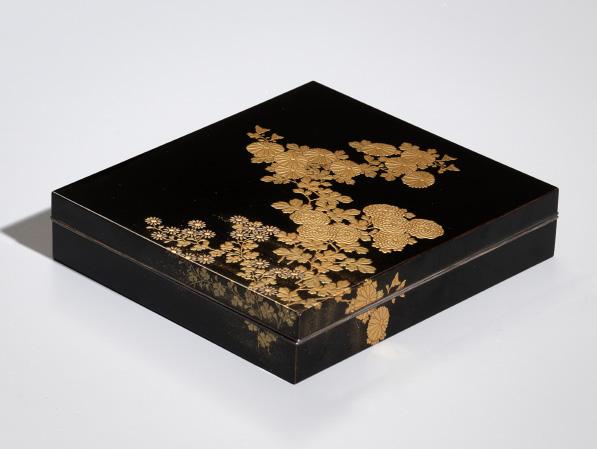
39
24
FUSEN: A FINE LACQUER SUZURIBAKO DEPICTING HERONS AT THE ITSUKUSHIMA SHRINE
By Fusen, signed Fusen with a kakihan Japan, late 18th to early 19th century, late Edo period (1615-1868)
Of rounded rectangular form, bearing a roiro ground, the overhanging cover finely decorated in gold and silver hiramaki-e and takamaki-e with kirigane and e-nashiji to depict the ‘floating’ torii gate of the Itsukushima Shrine, a heron perched with one leg on the gate and preening itself as two other herons fly toward it over crashing waves, all amid gnarled pine trees, craggy rockwork, and thick clouds, with the sacred peaks of Mount Misen towering in the background. The interior of the cover is decorated with gold and colored takamaki-e and e-nashiji with aquatic life including seashells, clams, conches, and a starfish, the upper half entirely in nashiji. The baseboard of nashiji and fitted with brush holders, a suzuri (inkstone), a parcel-gilt silver suiteki (waterdropper) of rhomboidal shape incised with stylized plovers (hama chidori), and two gold lacquered fude (writing brushes).
SIZE 4.4 x 25 x 22.6 cm
Condition: Good condition with minor wear, few minor age cracks, occasional light scratches. Provenance: Dutch collection.
With a black-lacquered wood storage box with an old Japanese label.


Fusen (lit. ‘a floating boat’) is recorded by Wrangham, E. A. (1995) The Index of Inro Artists, p. 54.
Itsukushima Shrine, on Miyajima Island (also known as Itsukushima), is believed to have been first built during the reign of Empress Suiko (554-628). The warrior Taira no Kiyomori (11181181), however, is responsible for the shrine’s present form. The Shinto shrine is best known for its “floating” torii gate.
Estimate EUR 4,000 Starting price EUR 2,000
40

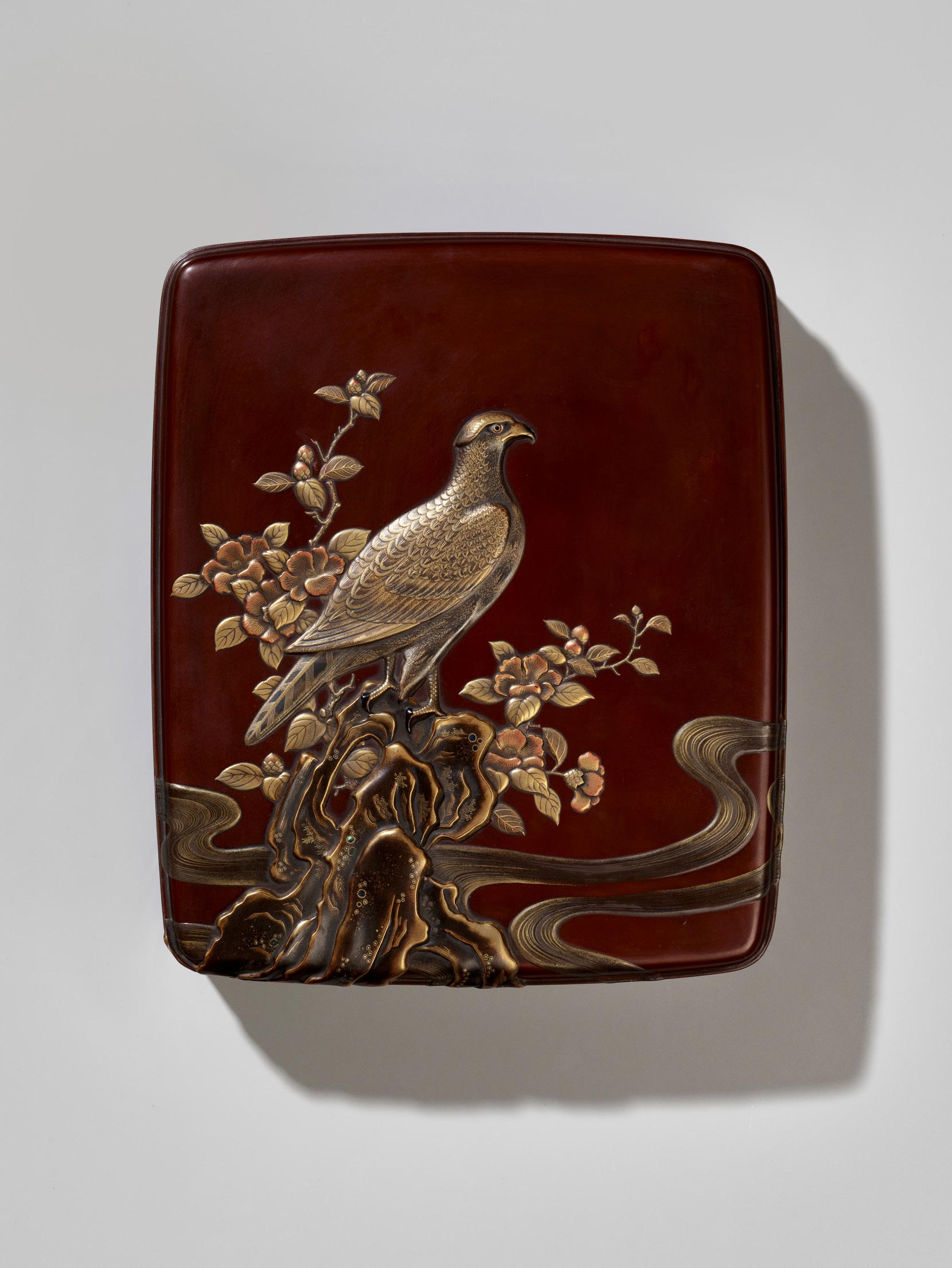
25
SHOGAKU: A SUPERB LACQUER SUZURIBAKO DEPICTING AN AUTUMNAL SCENE WITH FALCON AND SPARROWS


By Shogaku, signed Shogaku with seal Shogaku Japan, 19th century

Of rounded rectangular form with silver rims, bearing a lustrous chestnut-red ground, the flush-fitting cover superbly decorated in gold and colored takamaki-e with kirikane and aogai inlay to depict a falcon perched on a cragged rocky outpost with leafy floral blossoms above a meandering stream, continuing over to the sides of the box. The interior of the cover similarly decorated and with red hiramaki-e and e-nashiji to depict two sparrows flying amid swirling clouds under a blood-red moon. The baseboard with gnarled branches bearing finely veined leaves and chestnuts with roughly textured shells, some of which have fallen, fitted with a rectangular inkstone (suzuri) and a silver waterdropper (suiteki) in the form of a teakettle, and signed SHOGAKU with a seal Shogaku.
SIZE 6.5 x 27.3 x 23.2 cm

Condition: Excellent condition with minor wear.
Provenance: An important Austrian private collection, acquired during the first half of the 20th century, and thence by descent within the same family. Austrian private collection, acquired from the above.
AUCTION COMPARISON: Compare a related suzuribako of similar quality and depicting an autumnal scene with falcon, sold at Christie’s, Japanese and Korean Art, 18 September 2007, New York, lot 238 (sold for 18,750 USD).
Estimate EUR 6,000 Starting price EUR 3,000
43

26
A FINE LACQUER SUZURIBAKO DEPICTING A PAIR OF PIGEONS
Japan, early to mid-19th century, Edo period (1615-1868)
Of unusual oval form, the cover finely decorated in gold and silver takamaki-e depicting two pigeons, their feet and beaks inlaid in stained horn, the eyes inlaid in glass. The interior embellished with ferns in gold takamaki-e and with a silver patinated metal character 申 which is pronounced Shin and represents 神 (Kami).


The detachable baseboard with a suzuri (ink-grinding stone) and a cloisonné enamel suiteki (water dropper) in the form of a teapot with a fitted silver mount.
SIZE 24.1 x 20.3 x 4.6 cm
Condition: Very good condition, minor wear, discoloration to the lacquer, minor losses to the inlays and rims, light surface scratches.
Provenance: British private collection. Two old labels to the silver mount of the suiteki.
Estimate EUR 2,500
Starting price EUR 1,200
27
A BLACK AND GOLD LACQUER NATSUME (TEA CADDY) WITH A WEEPING WILLOW (YANAGI)



Japan, Showa period (1926-1989)
Of typical form with a flush-fitting cover, the exterior bearing a glossy roiro ground finely decorated in gold takamaki-e and kirikane to depict a willow tree growing from the base of the tea caddy to the top of the cover. The interior of roiro with gold fundame edges.
HEIGHT 7.5 cm
Condition: Excellent condition with minor wear.
Provenance: Dutch collection.
With a wood tomobako signed by Tada Keikan (1935-?) and a Japanese pamphlet describing the accomplishments of the artist.
AUCTION COMPARISON: Compare a related black and gold lacquer natsume with a weeping willow by Hirata Shoichi, also dated Showa period, at Zacke, Fine Japanese Art, 27 May 2022, Vienna, lot 123 (sold for 1,643 EUR).
Estimate EUR 1,000 Starting price EUR 500
28
A BLACK AND GOLD LACQUER NATSUME (TEA CADDY) WITH BAMBOO
Japan, Showa period (1926-1989)
The glossy roiro ground decorated in gold hiramaki-e, takamaki-e, and nashiji with bamboo stalks rising to a dense canopy of leaves on the cover, the interior of roiro with gold fundame edges.
DIAMETER 8.5 cm
Condition: Excellent condition with minor wear.
Provenance: Dutch collection.
With an inscribed wood tomobako.
Estimate EUR 800 Starting price EUR 400
46
29
A PAIR OF BLACK AND GOLD LACQUER CHOSHI (SAKE EWERS) AND COVERS
Japan, Meiji period (1868-1912)
Each of circular section, supported on three knop feet, with a flat cover, short spout, and loop handle, bearing a lustrous roiro ground finely decorated in predominantly gold hiramaki-e and takamaki-e with kirikane and e-nashiji to depict ho-o birds and leafy branches, the handle and spout decorated with leafy scrolling vines, the interiors of brown lacquer.

HEIGHT 17.2 cm and 17.4 cm
Condition: Very good condition with minor wear and expected minor age cracks.
Provenance: Dutch collection.
With the original wood storage box with an old Japanese label.
AUCTION COMPARISON: Compare a related sake ewer, erroneously described as a yuto (a hot-water ewer), dated late 19th century, Meiji period, 25 cm high, at Christie’s, 8 November 2006, London, lot 115 (sold for 2,400 GBP).
Estimate EUR 1,500 Starting price EUR 800

47
30
SADAATSU: A FINE ZESHIN-SCHOOL SET OF FIVE LACQUER TANZAKU (POEM CARDS) WITH FIVE FESTIVALS OF JAPAN

By Sadaatsu, each tanzaku signed Sadaatsu Japan, Tokyo, c. 1880, Meiji period (1868-1912)
Published: Grace Tsumugi Fine Art, Japanese Works of Art, Exhibition 28 October – 20 November 2020, London, no. 27.
Each carved wood tanzaku (poem card) decorated in superb iro-e maki-e lacquer with designs associated with five festivals of Japan; from left to right: a buriburi toy for the New Year’s celebration, a pair of dolls of an emperor and an empress for the Hinamatsuri festival in March, a samurai tachi sword for tango no sekku (boy’s festival) in May, a half-opened curtain for the Tanabata star viewing festival in July and a water vessel for the chrysanthemum festival in September. Each signed to the lower right within a rectangular reserve SADAATSU.
SIZE 63.4 x 69.8 cm (including frame) and 7 x 38.5 (each tanzaku)
Condition: Excellent condition, only very minor wear to lacquer. Provenance: Formerly with Grace Tsumugi Fine Art, London.
Each tanzaku set inside a silk brocade panel and framed within a black-lacquered frame behind plexiglass.

AUCTION COMPARISON: Compare a closely related framed panel with five lacquer tanzaku by Shibata Zeshin, sold at Bonhams, The Edward Wrangham Collection of Japanese Art, Part VI, 10 November 2015, London, lot 149 (sold for 25,000 GBP). Also compare to a set of two lacquer panels, one featuring the same tachi as the present lol, by Shibata Zeshin, sold at Christie’s, Japanese and Korean Art, 18 March 2014, New York, lot 488 (sold for 12,500 USD).
Estimate EUR 8,000 Starting price EUR 4,000

48

49
31 A SHIBAYAMA INLAID AND LACQUERED WOOD PANEL DEPICTING ANTHROPOMORPHIC FROGS


Japan, Meiji period (1868-1912)
The wood ground finely decorated in gold takamaki-e and hiramaki-e and neatly inlaid with mother-of-pearl, bone, some of which is stained green, and horn to depict two frogs by a stream amid blossoming flowers under the crescent moon partly obscured by thick clouds. One of the frogs is holding a chrysanthemum stem as if he was playing the flute, while the other approaches dragging another floral stem as if it was a club, about to strike the provocateur.
SIZE 23 x 22.5 cm (the panel) and 36.4 x 35.7 cm (incl. frame)
Condition: Good condition with minor wear, occasional light scratches, few losses to inlays.
Provenance: French private collection.
With an old gilt wood frame with velvet padding.
The depiction of the frogs on the present panel is reminiscent of the Choju-jinbutsu-giga scrolls from the 12th and 13th centuries. This famous set of four emakimono belonging to Kozan-ji temple in Kyoto are also referred to as Scrolls of Frolicking Animals in English and feature many anthropomorphic frogs.
Estimate EUR 1,500 Starting price EUR 800
A scene from the Chojujinbutsu-giga scrolls depicting frolicking frogs

EKIFUMI: A RARE AND FINE SHIBAYAMA INLAID LACQUER TRAY DEPICTING A KAPPA HUNT


By Ekifumi (Ekibun), signed Ekifumi Japan, Meiji period (1868-1912)
Of lobed (mokko) form with four short bracket feet and a silver rim, the interior bearing a kinji ground richly decorated in gold and brown hiramaki-e and takamaki-e with kirikane and e-nashiji, as well as inlays of aogai, lacquer, bone, wood, gilt-metal, and horn to depict a chaotic scene with a kappa emerging from a river, grabbing a terrified man’s leg, attempting to drown him as he screams while further men run toward them carrying flaming torches under the direction of a samurai standing on a bridge above them, a helpless attendant by his side, a woman carrying firewood at the foot of the bridge, two torches have fallen to the ground, suggesting an even more horrific turn of events, all amid blossoming cherries and a willow, with huts, trees, and mountains in the background, framed by a band of various brocade patterns and floral designs below the rim, the signature EKIFUMI incised within a red-lacquer fan-shaped reserve, the base of nashiji.
LENGTH 24.1 cm
Condition: Very good condition with minor wear, occasional light scratches, few minor losses to inlays.
Provenance: Dutch private collection, acquired at Mak van Waay, 25 February 1969, Amsterdam, lot 3340.
This artist of the Shibayama school appears to be unrecorded. However, like other Shibayama artists, his name uses the character Eki (Yasu).
A kappa is a reptiloid kami with similarities to yokai found in traditional Japanese folklore. Kappa can become harmful when they are not respected as gods. They are typically depicted as green, human-like beings with webbed hands and feet and a turtle-like carapace on their back. Their actions range from comparatively minor misdemeanors, such as looking up women’s kimonos if they venture too near to water, to outright malevolence, such as drowning people and animals, kidnapping children, raping women and at times eating human flesh. According to folklore there are two ways to escape a kappa encounter unharmed. One is to feed it with a cucumber, which is the kappa’s favorite food, and the other is to bow, as kappa are exceedingly polite creatures and find it difficult to resist returning the favor.
Estimate EUR 6,000
Starting price EUR 3,000
32
A RARE AND SUPERB SHIBAYAMA-STYLE
INLAID GOLD LACQUER TABLE SCREEN WITH
KYOSAI’S ANIMAL CIRCUS
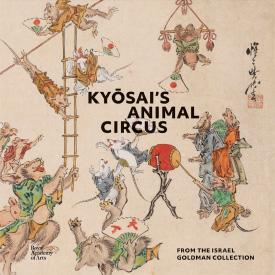
Japan, Meiji period (1868-1912)
The screen comprising two hinged panels opening both ways so either side can be presented as the front, each panel divided into two sections framed in gold nashiji, kirigane, and fundame, the kinji ground inlaid with mother-of-pearl, horn, coral, tortoiseshell, and bone, the top sections depicting to one side a multitude of anthropomorphic, frolicking animals engaged in various pursuits and acrobatic feats, including two mice destroying a game of go, a cat pounding mochi, a bat fanning a teakettle, a rabbit serving tea, another hare smoking a pipe, a dog being lifted into the air by a bat, a group of rats playing musical instruments, and another attempting to steal a puppy’s brocade ball, the lower sections decorated with scholar’s objects including scrolls, vases, a censer, a figure of Kannon, a scepter, a flywhisk, and a scholar’s rock.

The other side is similarly inlaid and further decorated in iro-e hiramaki-e and takamaki-e with a humorous and chaotic scene sparked by a hawk lifting a sarumawashi’s helpless monkey as numerous bystanders, young and old, watch in shock and awe, surrounded by blossoming cherry trees and leafy chrysanthemums, above the two smaller sections similarly decorated with Mandarin ducks in a pond with various flowers.
HEIGHT 25.5 cm, WIDTH 25.3 cm
Condition: Good condition with minor wear, the side with the frolicking animals with a few losses to inlays, the other side with absolutely no losses to inlays whatsoever. Provenance: French private collection.


This remarkably detailed and very amusing screen has certainly been inspired by Kawanabe Kyosai’s animal circus, which in turn was inspired by the famous Choju-jinbutsu-giga scrolls (literally “Animalperson Caricatures”), dating to the 12th century and housed in the Toyo National Museum.
AUCTION COMPARISON:
(1831-1889)

Compare a closely related Shibayama style gold lacquer two-panel screen by Masaaki, 23.7 x 21.5 cm, at Bonhams, Fine Japanese Art, 17 May 2018, London, lot 217 (sold for 11,250 GBP).
Estimate EUR 10,000
Starting price EUR 5,000
52
33
Animal circus by Kawanabe Kyosai


Buddhist Art
Lots 34 to 43

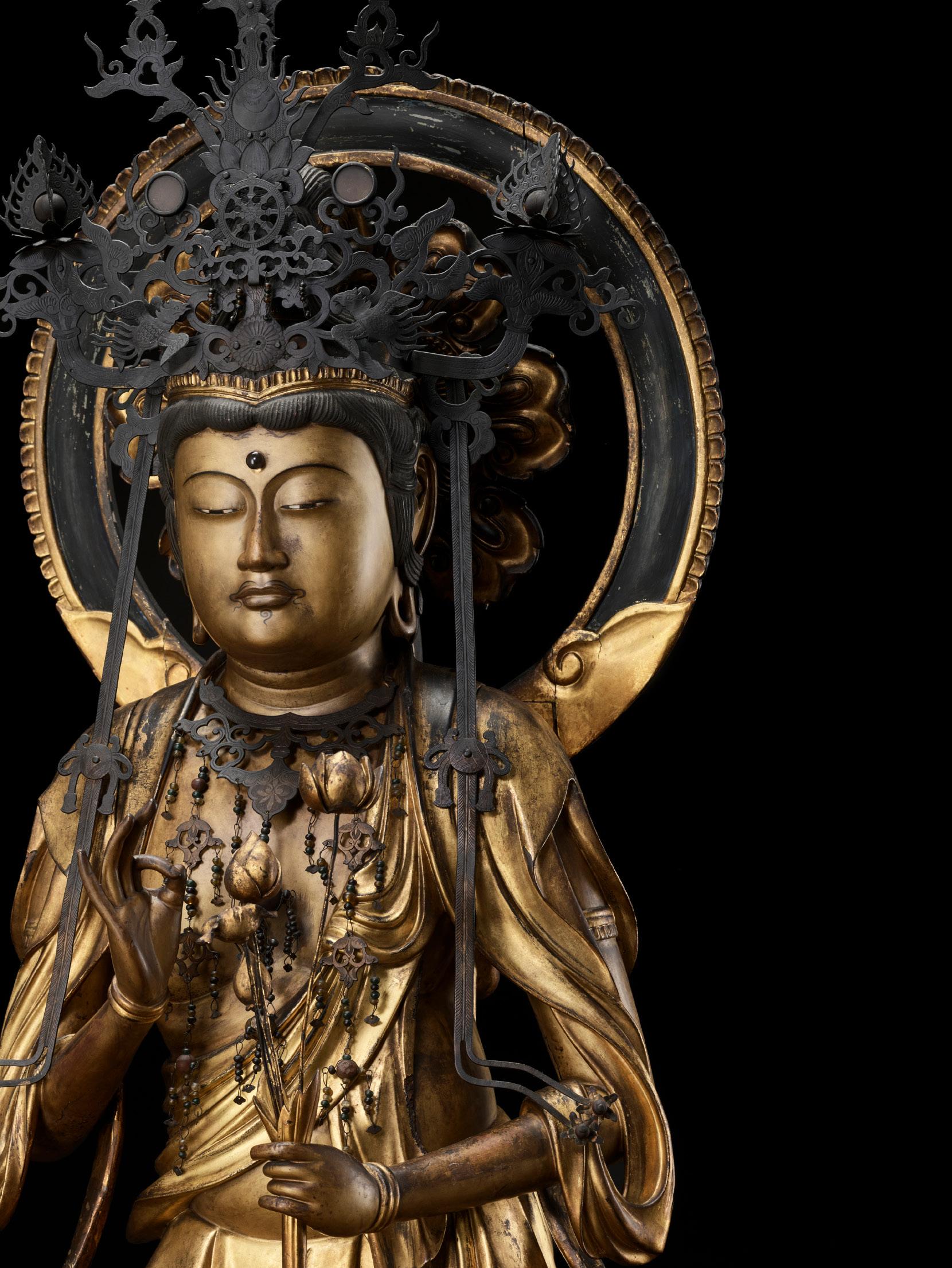

AN EXCEPTIONAL AND MONUMENTAL GILT WOOD FIGURE OF SEISHI BOSATSU


Japan, 16th-17th century, late Muromachi (1336-1573) to early Edo period (1615-1868)
Of yosegi-zukuri (joined-block) construction, the bodhisattva standing atop a lotus dais with finely carved petals raised on a compressed globular element with pierced foliate and floral dharmachakra designs supported on an elaborate tiered circular base decorated with scrolling vines, a wavy collar above lappets, and diapered chrysanthemums. His lowered left hand holding a small bouquet of lotus flowers, his raised right hand held in vitarka mudra (raigo-in). He is dressed in loose-fitting robes cascading in voluminous folds and billowing scarves, and richly adorned with an elaborate pierced necklace and head-ornament of applied copper alloy with pendent ornaments and ribbons. His serene face with finely painted downcast eyes below elegantly arched brows centered by an urna (byakugo) and full lips framed by a curled mustache, the hair piled up into a high chignon. The base inset with a flattened post surmounted by a large circular lotus aureole. The underside gives some further insight into the elaborate construction of this monumental figure.
HEIGHT overall 175 cm

Condition: Old wear, the gilt and applied metal elements remarkably well-preserved, minor flaking, small nicks and chips, light surface scratches, minuscule losses, expected minor age cracks. Possibly minor old repairs and touchups. Generally, in very good condition, commensurate with age, and better than most statues of this extremely rare size and period
Provenance: From the estate of Dorothy Robins Mowry (1921-2021), an American think tank executive and author who lived and worked in Tokyo between 1963-1971, where she held a position in the Cultural Programs Office for 8 years at the American Embassy. Among her most well-known books are The Hidden Sun: Women of Modern Japan and Experiment in Democracy: The Story of U.S. Citizen Organizations in Forging the Charter of the United Nations. Dorothy was a soughtafter public speaker at national and international conferences, universities, community and non-governmental organizations, and radio and TV stations. She presented extensively throughout the U.S. and overseas in many countries including Japan, Korea, Thailand, Indonesia, Switzerland, and Iran.
Seishi Bosatsu (Mahasthamaprapta), also known as the Bodhisattva of strength and wisdom, is recognized in Japan as one of the Thirteen Buddhas and associated with the Nio temple guardians. He is one of the oldest bodhisattvas and is regarded as powerful, especially in the Pure Land school, where he takes an important role in the Longer Sukhavativyuha Sutra. He is often depicted in a trinity with Amitabha (Amida) and Avalokiteshvara (Kannon), especially in Pure Land Buddhism. Seishi Bosatsu is rarely represented in Japanese sculpture outside of the Amida triad, where he is often depicted holding a lotus flower.
LITERATURE COMPARISON:
Compare a closely related gilt wood figure of Seishi Bosatsu, dated 18th century, 143.2 cm high, in the Museum für Asiatische Kunst, Humboldt Forum, Berlin, reference number DLG 134-1996. Compare a related gilt wood figure of Seishi Bosatsu, dated 17th or 18th century, 81.3 cm high, in the collection of the Metropolitan Museum of Art, accession number 2006.438a–e.

AUCTION COMPARISON:

Compare a related gilt wood figure of Amida, dated to the early period and measuring 180 cm, sold at Christie’s, Art D’ Asie, 10 December 2020, Paris, lot 65 (sold for 52,500 EUR).
Estimate EUR 60,000 Starting price EUR 30,000
57
34
Dorothy Robins Mowry (1921-2021)
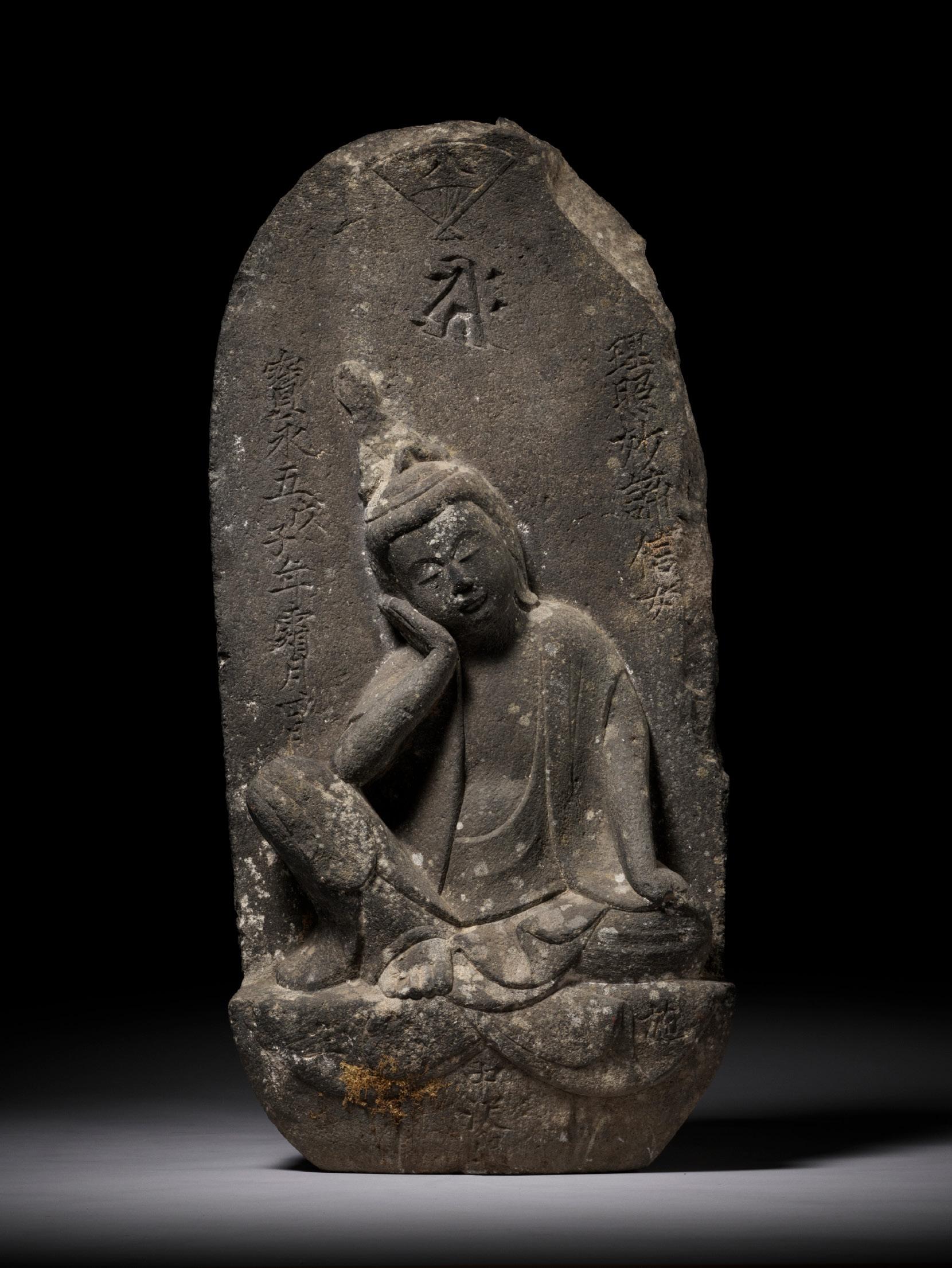
35
A RARE STONE STELE OF NYOIRIN KANNON, DATED 1708 BY INSCRIPTION
Japan, dated 1708
Well carved seated in royal ease on a draped lotus throne, the right hand raised in Shiyui-so supporting the tilted head, the left hand resting on the left thigh, wearing loose-fitting robes opening at the chest, the face with a contemplative expression, the hair arranged in a high chignon, backed by a tall mandorla.

The left side with a carved inscription: 寶永五戊子年霜月四日
“Hoei go tsuchinoe-ne toshi shimotsuki yokka” [The 4th day of the Eleventh month (the month of frost), in the Hoei 5th year (1708), in the year of tsuchinoe-ne]. The opposite side opposite with a female devotee’s holy name ‘Rishō Myotei Shinnyo 理照妙諦信女 “, center of the base further with ‘Nakazawa Shi 中沢氏’
HEIGHT 93 cm
Condition: Good condition, commensurate with over 300 years of age. Extensive wear, minor losses, signs of weathering and erosion, few structural cracks.
Provenance: From the collection of Sir Ernest Ridley Debenham, thence by descent in the same family. A letter from John G. Ayers of the Victoria & Albert Museum, addressed to “Miss M C Debenham” (Ernest Debenham’s daughter Margaret), dated 14 August 1970, detailing his opinion of the present lot and translation of the inscriptions, with the letterhead of the Victoria & Albert Museum, accompanies this lot.
Sir Ernest Ridley Debenham, 1st Baronet (1865-1952), was an English businessman who owned the famous department store chain Debenhams. He was responsible for the considerable expansion of the family’s retail and wholesale drapery firm between 1892 and 1927. He was also a pioneer in the dairy industry. John G. Ayers formed the Far Eastern Department at the Victoria & Albert Museum in 1970 and served as President of the Oriental Ceramics Society between 1984 and 1986. He authored countless books on Chinese and Japanese works of art, including the famous Baur Collection, and was widely recognized as one of the world’s leading specialists in the field.

Sir Ernest Ridley Debenham (1865-1952), 1930
A letter from John G. Ayers of the Victoria & Albert Museum



This stele depicts Nyoirin Kannon (Skt: Cintamani Chakra Avalokiteshvara), a form of the bodhisattva Kannon whom Buddhists believe ‘listens to the voices of the world’ and to whom they look for the granting of wishes. Nyoirin Kannon is usually depicted with six hands holding various attributes, but in this rare stele is carved with two hands.
The surname of the devotee was Nakazawa 中沢, whose holy Buddhist name was Risho Myotei shinnyo, which literally means “A Buddhist female lay believer Risho Myotei”. Risho Myotei 理照妙諦 literally means “Logic, Enlighten, Wondrous, Truth”.
MUSEUM COMPARISON:
Compare a closely related memorial stone depicting a two-armed Nyoirin Kannon, dated 1671 by inscription, in the Horniman Museum & Gardens, museum number nn19126. Compare a related stone stele of a six-armed Nyoirin Kannon, dated 1680 by inscription, in the Victoria & Albert Museum, accession number A.125-1920.
Estimate EUR 10,000 Starting price EUR 5,000
59

A LARGE GILT AND LACQUERED WOOD FIGURE OF AMIDA NYORAI
Japan, 18th-19th century, Edo period (1615-1868)
Seated in dhyanasana on a separately carved double lotus throne with beaded edge supported on an elaborate tiered hexagonal base lacquered in gold, red, and green and carved with lotus, clouds, and key-fret. His hands are held in raigo-in (vitarka mudra). He is wearing a loosefitting robe draped over both shoulders, opening at the chest, and cascading in voluminous folds, his chest and face lacquered brown over gold, the serene face with downcast eyes below elegantly arched brows, his full lips framed by a finely painted mustache, his hair arranged in tight curls with a domed ushnisha, backed by a large halo carved in openwork with scrolling clouds around a central lotus design, the separately carved halo inset at the back of the lotus throne.
HEIGHT 38 cm (the figure) and 90 cm (total)
Condition: Very good condition with some wear to gilt and lacquer, expected minor age cracks, minuscule nicks, light scratches, few minor losses.
Provenance: Dutch collection.
The sculpture represents Amitabha, known in Japanese as Amida Nyorai, or the Buddha of Limitless Light. The downcast gaze directed towards the onlooker below is emblematic of the infinite compassion with which his name is synonymous.


Amitabha reigns over the Western Pure Land, a paradise to which anyone is welcomed if they faithfully and sincerely incant his name. This place of salvation became central to the Jodo [lit. Pure Land] sect of Buddhism. Propounded in 1175 by the monk Honen, the accessibility of such tenets of redemption allowed this form of Buddhism to proliferate across the nation and feudal classes of Japan. Often depicted with an elaborate mandala, the boatshaped halo is said to remind his followers that he serves as a guide for them to cross the ocean of suffering which contaminates the living.
AUCTION COMPARISON:
Compare a related giltlacquered wood figure of Amida Nyorai, dated to the 18th century, Edo period, 77 cm high overall, at Christie’s, Art d’Asie, 14 December 2016, Paris, lot 87 (sold for 68,500 USD).
Estimate EUR 20,000
Starting price EUR 10,000
61
36


A PAIR OF MONUMENTAL BRONZE NIO GUARDIANS, DATED 1783
 BY INSCRIPTION
BY INSCRIPTION
Japan, dated 1783
Each standing atop a naturalistically cast rockwork base raised on a finely carved lacquered wood stand supported on four stout cabriole legs. The open-mouthed Misshaku Kongo holds a vajra in his raised left hand, his other hand lowered with the fingers stretched out, while the close-mouthed Naraen Kongo thrusts his right hand forward with the palm facing forward, in a protective gesture akin to the abhaya mudra, while his left hand is clenched into a fist. Both guardians wearing short skirts and billowing scarves, their muscular bodies with prominent ribs, their faces with wrathful expressions, their hair and brows neatly incised, their topknots with foliate headdresses. Each statue is inscribed to the reverse, ‘Tenmei san, mizunoto-u toshi, kichijitsu, kore wo osaku’ (‘This is donated on an auspicious day, in Tenmei 3 (corresponding to 1783), in the year of mizunoto-u’).
HEIGHT each 117 cm (excl. base) and 157.5 cm (incl. base) WEIGHT 92 & 96 kg
Condition: Very good condition with old, attractive wear; casting flaws, minor nicks, light scratches, small dents. The wood stands with some wear, minor nicks and scratches, expected age cracks. Provenance: US private collection.
The inscription on the present nio statues records that they were donated in Tenmei 3 (1783), a fateful year during which the devastating Tenmei eruption on Mount Asama in central Honshu occurred, exacerbating the Great Tenmei famine. It is plausible that an ardent patron commissioned and donated the pair to protect an important temple from further calamity during a particularly difficult time.
‘This is donated on an auspicious day, in Tenmei 3 (corresponding to 1783), in the year of mizunoto-u’
Nio or Kongorikishi are two wrathful and muscular guardians of the Buddha standing today at the entrance of many Buddhist temples in East Asian Buddhism in the form of frightening wrestler-like statues. They are dharmapala manifestations of the bodhisattva Vajrapani, the oldest and most powerful deity of the Mahayana Buddhist pantheon. According to Japanese tradition, they traveled with Gautama Buddha to protect him. Within the generally pacifist tradition of Buddhism, stories of dharmapalas justified the use of physical force to protect cherished values and beliefs against evil. Nio are also seen as a manifestation of Mahasthamaprapta, the bodhisattva of power that flanks Amitabha in Pure Land Buddhism and as Vajrasattva in Tibetan Buddhism. They are usually a pair of figures that stand under a separate temple entrance gate, usually called Niomon in Japan.
Two nio who stand in the left (ungyo) and the right (agyo) of a gate (sanmon) at Zentsu-ji, Nara, Japan
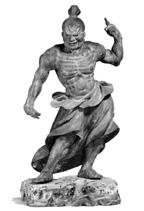

Guhyapada (Japanese: Misshaku Kongo) is a symbol of overt violence: he wields a vajra mallet and bares his teeth. His mouth is depicted as being in the shape necessary to form the ‘ha’ or ‘ah’ sound, wherefore he is also known as Agyo in Japan. Narayana (Naraen Kongo) is depicted either bare-handed or wielding a sword. He symbolizes latent strength, holding his mouth tightly shut. His mouth is rendered to form the sound ‘hūm’, ‘heng’, or ‘un’. He is also referred to as Ungyo in Japanese due to his closed mouth.

LITERATURE
COMPARISON: The two nio figures closely resemble a pair of wood guardian figures, dated to the late Kamakura period, early 14th century, each 86.4 cm high including the base, in the collection of the Metropolitan Museum of Art, accession numbers 64.292.1 and 64.292.2.
Estimate EUR 50,000 Starting price EUR 24,000
64
37

AN IMPRESSIVE PAIR OF LARGE SCROLL PAINTINGS DEPICTING NIO GUARDIANS
Japan, c. 1700, early Edo period
Each boldly and expressively painted with ink and watercolors on silk, mounted as a hanging scroll with a silk brocade frame. Each depicting one of the two Nio guardians, Agyo with open mouth and Ungyo with closed mouth, respectively, well detailed with muscular bodies, flowing robes, and billowing garlands, and adorned with a necklace, bracelets, and armlets, one holding a Buddhist tuning fork and the other a thunderbolt scepter. Their faces show fierce, almost grotesque expressions marked by large bulging eyes and furrowed brows.


SIZE 127.5 x 75.6 cm (image, each) and 192 x 91.5 cm (total, each)
Condition: Good condition with some wear, soiling, creasing, few minuscule losses, the mounting with some wear and small tears. Provenance: Dutch collection.
With an old black-lacquered wood
Nio or Kongorikishi are two wrathful and muscular guardians of the Buddha, found at the entrance of many Buddhist temples in East Asian Buddhism in the form of frightening wrestler-like statues. They are dharmapala manifestations of the bodhisattva Vajrapani, the oldest and most powerful of the Mahayana Buddhist pantheon. According to Japanese tradition, they traveled with Gautama Buddha to protect him. Within the generally pacifist tradition of Buddhism, stories of dharmapalas justified the use of physical force to protect cherished values and beliefs against evil. Nio are also seen as a manifestation of Mahasthamaprapta, the bodhisattva of power that flanks Amitabha in Pure Land Buddhism and as Vajrasattva in Tibetan Buddhism. They are usually a pair of figures that stand under a separate temple entrance gate commonly called Niomon in Japan. The right statue is called Misshaku Kongo (or Agyo) and has his mouth open, and the left statue is called Naraen Kongo (or Ungyo) and has his mouth closed. Similar to Alpha and Omega in Christianity, they signify ‘everything’.

Estimate EUR 8,000
Starting price EUR 4,000

39 A RARE EMBROIDERED SILK WALL HANGING OF KANNON


Japan, 18th century, early to mid-Edo period, the brocade frame Meiji period (1868-1912)
The shubutsu (Buddhist embroidery) finely embroidered with silk and gold couched threads on silver-gray silk damask and mounted to a later brocade frame, depicting Kannon, the Bodhisattva of compassion, standing on a lotus base above swirling clouds, holding a lotus flower in his left hand, the golden body dressed in a long flowing robe and adorned with jewelry, his face with a serene expression and downward gaze, centered by an urna, the head surmounted by an elaborate crown, with a silver radiating halo, the sun and moon to his upper left and right.
SIZE 187 x 93 cm (the hanging), 138 x 65.1 cm (the image)
Condition: Good condition, minor wear, loose threads, some staining and soiling, few small tears, minor losses. The brocade frame with loose threads. Provenance: A private collector in Vienna, acquired from Galerie Zacke, Vienna, circa in 1985. Thence by descent in the same family.
LITERATURE COMPARISON: Compare a closely related silk embroidery panel of Kannon, 1780-1840, in the Victoria and Albert Museum, accession number T.208-1958. Compare a closely related silk embroidery panel of Kannon, 18th century, in the Victoria and Albert Museum, accession number T.191-1968.
Estimate EUR 8,000 Starting price EUR 4,000
68


40 A POLYCHROME WOOD FIGURE OF SEITAKA DOJI


Japan, 16th-17th century, Muromachi (1333-1573) to early Edo period (1615-1868)
Finely painted in polychrome pigments and gilt over gesso, the guardian attendant standing, wearing a long flowing robe with deeply carved folds, foliate hems, and floral roundels, a scarf draped over his shoulders, adorned with armbands, bracelets, and anklets, his face with a stern expression, the eyes inlaid in reversepainted crystal, the curled hair tied at the front.
HEIGHT 30 cm
Condition: Good condition with some wear and small losses to pigments and gilt, few minuscule nicks, occasional light scratches.
Provenance: French private collection.
Mounted on an associated metal base of square form.
Seitaka Doji is one of the two boy attendants of Fudo Myo-o (the Immovable or Unshakable One). Sculptural triads of these figures exist from the late Heian period (794–1185). In these triads, Seitaka Doji has a troll-like appearance, which contrasts with the placid features of his fellow attendant, Kongara Doji.
MUSEUM COMPARISON: Compare a related lacquered wood figure of Seitaka Doji, together with Kongara Doji, 34.3 cm high, dated ca. 1350, in the collection of the Metropolitan Museum of Art, accession number 2018.17.1, .2.


AUCTION COMPARISON: Compare a related lacquered wood figure of Seitaka Doji, dated 14th century, 17.1 cm high, at Christie’s, 25 April 2017, New York, lot 6 (sold for 5,625 USD). Compare a closely related polychrome wood figure of Seitaka Doji, dated to the Muromachi period, 16th century, 30.8 cm high, at Bonhams, 22 July 2020, New York, lot 988 (bought-in at an estimate of 4,000-5,000 USD).
Estimate EUR 3,000 Starting price EUR 1,500
41
KANO TESSAI: A RARE WOOD NYOI SCEPTER WITH ONI HEAD



By Kano Tessai (1845-1925), signed Tessai followed by the artist’s idiosyncratic kakihan Japan, Nara, early 20th century
Finely carved, the elegantly curved shaft with a plain scroll terminal and a fierce oni head detailed with bulging eyes, bushy brows, a wide mouth revealing tongue and teeth flanked by sharp fangs, and a broad nose, the sides and back of the shaft and some details lacquered red, the wood of attractive grain and color, purposely worn to simulated old age. The front of the scepter is inscribed Seija (‘right and wrong’), referencing a moral precept known as Seija zen’aku (‘right and wrong & good and evil’), while the back shows the signature TESSAI followed by the artist’s characteristic kakihan.
LENGTH 39.3 cm
Condition: Excellent condition with attractive simulated wear, possibly few minuscule nicks. Provenance: French private collection.
Kano Tessai (1845–1925) came from a Gifu family and started his life as a Buddhist priest, though his father instructed him in the art of carving. He studied Chinese literature and drawing and was a professor at Tokyo art school in 1872. He was also on the examining committee for investigating the ancient art of Japan and subsequently went to Nara where he engaged in the reproductions of old objects of art, such as the present example. Although only few scepters by Tessai are known, he clearly greatly enjoyed and found inspiration in this type of object, as evidenced by a Chinese Ming-dynasty bamboo scepter once owned by him, see Bonhams, The Zuiun Collection, 15 March 2017, New York, lot 5004.
AUCTION COMPARISON: Compare a bamboo scepter by Kano Tessai at Bonhams, 11 September 2019, New York, lot 546 (sold for 2,040 USD). Compare a dried-lacquer scepter by Ito Tesseki, a student of Kano Tessai, at Bonhams, 15 March 2017, New York, lot 5030 (sold for 10,000 USD). Estimate EUR 2,500 Starting price EUR 1,200
42
HOKKYO SESSAI: AN EXTREMELY RARE BAMBOO ZUSHI (PORTABLE SHRINE) WITH STAG ANTLER MOUNTS
By Hokkyo Shima Sessai (1820-1879), signed Sessai Japan, Echizen, mid-19th century, Edo period (1615-1868)

Of oval section, raised on three incised T-form feet, the mounts of stag antler, the hinged doors carved with rectangular panels enclosing a foliate cross design with a stylized flowerhead in stag antler in the center, below swirling clouds, the interiors of the doors incised with dragon roundels above a cross-hatched panel. The front of the zushi is further carved with scrolling vines and angular scroll continuing over to the reverse, the doors framed by key-fret borders, below two confronting baku. The reverse signed SESSAI within a stag antler-inlaid rectangular reserve.
HEIGHT 17 cm
Condition: Very good condition with minor wear, few tiny natural age cracks, few minuscule nicks.
Provenance: British collection.
Hokkyo Shima Sessai (1820-1879) was an excellent carver who earned the honorary title of Hokkyo during his lifetime and served the lord of the Echizen clan. His work is scarce as he died at a relatively young age.
Estimate EUR 2,500
Starting price EUR 1,200

AN EXCEPTIONAL AND VERY RARE ‘LOTUS’ ZUSHI SCEPTER ENCLOSED WITH BUDDHA SHAKYAMUNI
Japan, 19th century
Well carved in openwork, much of the surface embellished with masterful ukibori pimples, as several stems bearing lotus buds and leaves, the lotus pod to the base with fine stag antler inlay, the original cord tied around a loose stag antler ring below a stag antler-inlaid bud, the lotus bud terminal carved with scrolling clouds in high relief leading up to a hinged petal opening to reveal a minutely carved figure of Buddha Shakyamuni, a small stag antler peg serving as a hook to close the door to this naturalistic zushi (portable shrine).



LENGTH 50 cm

Condition: Excellent condition with minor wear.
Provenance: British collection.
AUCTION COMPARISON: Compare to a related scepter, also depicting lotus, attributed to Nakanishi Yosetsu (1841-1923), sold at Bonhams, The Zuiun Collection, 15 March 2017, New York, lot 5022 (sold for 21,250 USD).
Estimate EUR 4,000
Starting price EUR 2,000
73 43

Metalwork Lots 44 to 90




44
MUNEKAZU: AN EXCEPTIONALLY RARE AND HIGHLY IMPORTANT IRON JIZAI OKIMONO OF A HUMAN SKELETON

By Tomiki Isuke I (Art name Munekazu, 1853-1894), signed Munekazu Japan, c. 1860-1880
Ingeniously constructed from well over 100 separately cast and hammered iron components, depicting the 206 human bones in a scale of 1:4 precisely, altogether meticulously jointed to present a fully articulated skeleton of unique anatomical accuracy, the skull furthermore finely incised in every detail including the fontanelle and with a hinged jaw opening to reveal a remarkably detailed interior. The signature MUNEKAZU is neatly incised on a rectangular silver plaque inlaid to back of pelvis.
HEIGHT 38.5 cm WEIGHT 820.7 g
Condition: One arm has been replaced, otherwise in superb condition with a fine, naturally grown patina overall, some old wear and traces of use, presents exceptionally well.
Provenance: An old private estate in Philadelphia, USA. A British private collector, acquired from the above. Exhibited by Kevin Page Oriental Art at the 2019 LAPADA Art & Antiques Fair in London, United Kingdom, winner of the LAPADA Legends award in the Sculpture category.
With a fitted metal-mounted plexiglass stand.
Jizai okimono, known as Ingenious movable sculptures are the invention of Japanese metalsmiths trained in the manufacture of samurai armor. The Myochin family of armorers is credited with the first sculptures of this type in the eighteenth century. In relative peacetime, the demand for arms and armor, except for display purposes, had slowed. To meet the changes in demand, the Myochin expanded their repertoire into metalwork of a decorative and symbolic nature. Some see these articulated models as the culmination of the armorer’s skill and imagination. Known as jizai okimono, (lit. ‘free decorative object’), these intricate sculptures are a unique genre of Japanese sculptural art. Popular subjects for jizai okimono included insects, fish, crustaceans, snakes, and even dragons.
The present skeleton, however, is not only an outstanding example of such objects, but also the only known example of its kind. It was made by Tomiki Isuke I (1853-1894), who used the art name Munekazu and is sometimes called ‘Myochin Munekazu’, although his affiliation with the Myochin school remains unclear. At his studio in Kyoto he tutored Takase Kozan (1869-1934) and Muneyoshi (Tanaka Tadayoshi; ?-1958). Although clearly working in the Myochin style, visible in the exceptional quality of his jizai okimono, the artist also enjoyed some independence from the school, allowing him to create unique sculptures such as the present lot, during the second half of his career.
AUCTION COMPARISON:
Compare an iron jizai okimono of a snake by Muneyoshi (Tanaka Tadayoshi, d. 1958), a student of Munekazu, 162.9 cm long, at Christie’s, 18 April 2018, New York, lot 111 (sold for 250,000 USD). Compare also an iron jizai okimono of an eagle by Itao Shinjiro (1842-1911), another artist who worked independently from the Myochin school, at Christie’s, 27 November 2018, Hong Kong, lot 3825 (sold for 6,700,000 HKD). Note that while these are some of the highest results achieved for mid-to-late 19thcentury jizai okimono, neither the snake nor the eagle are unique, unlike the present skeleton

77
Estimate EUR 250,000 Starting price EUR 120,000
MEMENTO MORI
Memento mori (Latin for ‘remember that you die’) is an artistic or symbolic trope acting as a reminder of the inevitability of death. The concept has its roots in the philosophers of classical antiquity and appeared in art and architecture from the medieval period onwards. The most common motif is a skull, often accompanied by one or more bones, or a complete skeleton. Often this alone is enough to evoke the trope, but sometimes other motifs such as a coffin, hourglass and wilting flowers were added to signify the impermanence of human life.
In Tibetan Buddhism, the skull mask of Citipati is a reminder of the eternal cycle of life and death. Furthermore, there is a mind training practice known as Lojong, the ‘Four Contemplations to Cause a Revolution in the Mind’. The second of these four is the contemplation on impermanence and death. In particular, one contemplates that:

All compounded things are impermanent, The human body is a compounded thing, Therefore, death of the body is certain, The time of death is uncertain and beyond our control.
There are a number of classic verse formulations of these contemplations meant for daily reflection to overcome our strong habitual tendency to live as though we will certainly not die today.
The Skull, by Leonardo da Vinci, 1489


Riding with Death, by Jean-Michel Basquiat, 1988; one of the artist’s last paintings
From Leonardo to Basquiat, the most important artists of the modern world were fascinated by the Memento Mori trope.

The same applies to the talented artist of the present lot Tomiki Isuke I (1853-1894) who like other Japanese artists drew influence from these earlier European ‘Memento Mori’ motifs. Some important examples include Kuniyoshi’s famous triptych depicting the Monster Skeleton or Kawanabe Kyosai’s Skeleton Musicians. Kyosai (1831-1889), a contemporary of the artist Tomiki Isuke I (1853-1894), in particular became fascinated by skeletons featuring them in several of his artworks, extending from orthodox pictures founded in the Kano-style to humorous and satirical pictures, full of wit, in the manner of ukiyo-e artist Kuniyoshi.
The Citipati as depicted in a painting in the Gelugpa Monastery, Nepal
A remarkably realistic skeleton depicted in Utagawa Kuniyoshi’s woodblock print, c. 1845, sold at Sotheby’s, Fine Japanese Art, 5 November 2019, London, lot 23 (sold for 200,000 GBP)

Painting of playful skeletons moving severable limbs, by Kawanabe Kyosai (1831-1889), British Museum, Museum no. 1946,0209,0.48

In Japanese Samurai culture, the influence of Zen Buddhist contemplation of death on indigenous culture can be gauged by the following quotation from the classic treatise on samurai ethics, the Hagakure:

“The Way of the Samurai is, morning after morning, the practice of death, considering whether it will be here or be there, imagining the most sightly way of dying, and putting one’s mind firmly in death. Although this may be a most difficult thing, if one will do it, it can be done. There is nothing that one should suppose cannot be done.”
In the annual appreciation of cherry blossom and fall colors, hanami and momijigari, it was philosophized that things are most splendid at the very moment just before their fall, and to aim to live and die in a similar fashion.

45
A RARE AND IMPRESSIVE IRON JIZAI OKIMONO OF A HAWK

Japan, late 19th century, Meiji period (1868-1912)
Naturalistically rendered, the eyes inlaid in gilt with black pupils, the predatory bird perched in a portrait-like pose, the leg joints, wings, beak, and tail meticulously crafted from numerous movable segments.
LENGTH 30 cm, HEIGHT 26 cm WEIGHT 1,234 g
Condition: Very good condition with minor wear, some expected age-related stiffness to the joints.
The art of creating lifelike figures of animals in metal, known as jizai okimono, which developed during the Edo period, is an example of outstanding Japanese craftsmanship. Meticulously constructed with hammered plates of iron, these articulated figures were greatly sought after for decorative use. They were placed in alcoves alongside pieces of porcelain, pottery and hanging scrolls, and were the object of entertainment and discussion. Popular subjects for jizai okimono included insects, fish, crustaceans, and even dragons. Jizai okimono depicting birds are extremely rare
LITERATURE COMPARISON:
Compare with an articulated hawk by Myochin Kiyoharu in the collection of the Tokyo National Museum, illustrated by Ito Yoshiaki et al., in the NHK Exhibition Catalogue, Commemorating the 2005 World Exposition, Aichi, Japan Arts of the East and West from World Expositions, 1855-1900, Paris, Vienna and Chicago, 2004, p. 080, no. I-191; and another articulated iron hawk (unsigned), in a private collection in France, illustrated by Harada Kazutoshi, ibid., p. 058, no. 19.
AUCTION COMPARISON:

Compare a related kusshin jizai okimono model of a hawk, attributed to Itao Shinjiro, dated circa 1894, 29 cm high, at Bonhams, Fine Japanese Art, 16 May 2013, London, lot 563 (sold for 121,250 GBP).

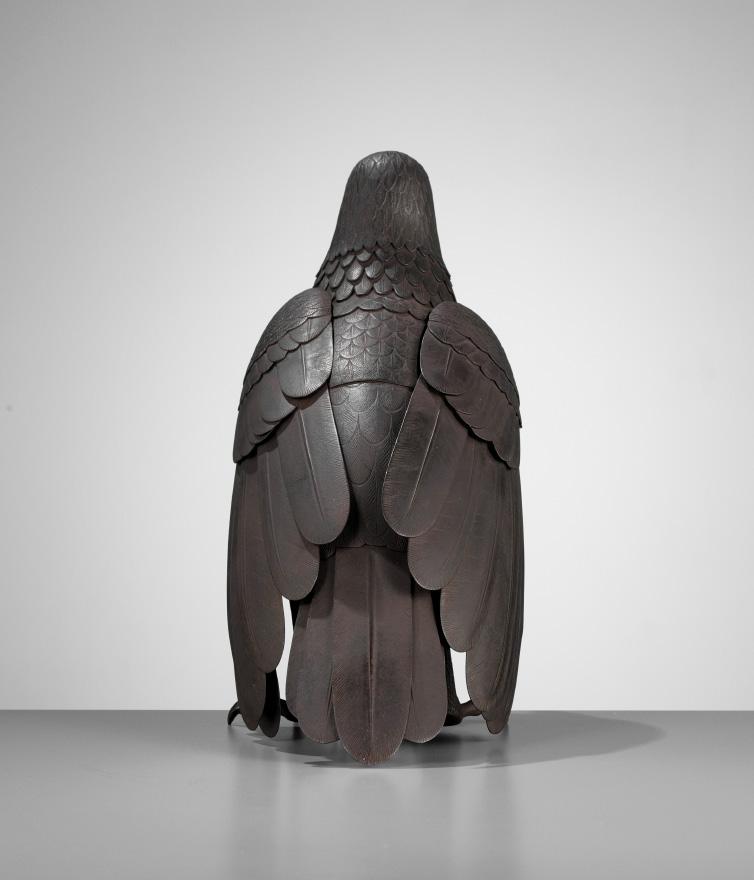
Compare to a closely related iron jizai okimono of a hawk, measuring 23 cm, sold at Woolley & Wallis, Japanese Works of Art, 27 July 2021, Salisbury, lot 358 (sold for 43,000 GBP).
Estimate EUR 60,000
Starting price EUR 30,000
81

46 A RARE MYOCHIN SCHOOL
IRON ARTICULATED JIZAI OKIMONO OF A SCHACHIHOKO (DRAGON FISH)
Japan, 19th century, late Edo period (1615-1868) to early Meiji period (1868-1912)
The shachihoko with a fully articulated body finely constructed of hammered plates joined inside the body, the mouth open to reveal a moveable flat tongue and sharp fangs, the body with spiky fins, the head applied with long, curling whiskers, elaborate horns and spines, and the eyes of shakudo embellished with gilt. With an associated root wood base.

LENGTH 41.5 cm (the dragon fish), 49.5 cm (the base) WEIGHT 4,076 g

Condition: Very good condition with minor expected wear and encrustations, some joints slightly stiffened.
This inventive creature is a dolphin-like sea beast called a shachi or shachihoko. With its moving jaws, spine and fins, it is a bit of fantasy come to life.
It is not clear why articulated animals and insects were first made in the workshops of armor makers in the early eighteenth century. The dragon model in the Tokyo National Museum made by Myochin Muneaki in 1713 is the earliest dated example. Typically, the artists of articulated figures made in this period were members of the Myochin school, prominent armor makers particularly skilled at forging and tempering steel. By the middle of the Edo period, Japan was at peace after centuries of civil war. The demand for arms significantly decreased, influencing many Myochin-school metalsmiths to turn to ornamental sword guards and arms, tea utensils and decorative objects in iron. Some of the articulated figures may have evolved from ornaments intended for helmets and other accoutrements.
Literature comparison: Tokyo National Museum, ed., Jizai okimono: Honmono no yo ni jiyu ni ugokaseru hebi ya konchu (Articulated [iron] figures: Movable representations from nature from snakes to insects) (Tokyo: Tokyo National Museum, 2008), pl. 4 and fig. 3.
AUCTION COMPARISON:

Compare a closely related iron articulated model of a dragon fish by Muneyoshi, 18th19th century, 30.5 cm long, at Christie’s, An Inquiring Mind: American Collecting of Japanese and Korean Art, 22 April 2015, New York, lot 94 (sold for 185,000 USD
Estimate EUR 60,000 Starting price EUR 30,000
83
47 AN EXCEPTIONALLY RARE INLAID IRON MINIATURE KODANSU (CABINET) WITH TURTLES AND CRANES


Japan, Meiji period (1868-1912)
Superbly decorated in gold and silver takazogan and hirazogan, the hinged door and short sides with ‘floating’ turtles framed by a stream and aquatic plants below and thin clouds above, the cover with two cranes flying in the sky as well as the setting sun and further clouds, the cover with a fitted gilt silver handle and the door with a silver knop, opening to reveal three silver drawers with iron front panels with silver-mounted handles and inlaid in the same manner as the exterior with turtles and carved with water currents, the interior of the door with a gold plate engraved with a man surrounded by ducks in a barren forest.
SIZE 9.6 x 9.3 x 6.4 cm WEIGHT 851.5 g
Condition: Very good condition with minor wear and casting irregularities.
Provenance: French private collection.
While miniature kodansu (display cabinets) were commonly made during the Meiji period, the most popular examples crafted from lacquer, inlaid ivory, or damascened iron, no comparable examples in sparsely inlaid iron are recorded in private or public collections, making this exceptionally well-crafted piece extremely rare
Estimate EUR 4,000 Starting price EUR 2,000
84
48
AN IMPORTANT IMPERIAL SILVER ‘TANG MIRROR’ BONBONNIERE WITH GOLD KIKUMON

Japan, 1915, early Taisho period (1912-1926)


The bonbonnière silver box in the shape of an eight lobed tang mirror, rising from an openworked foot, the lid centered by a gold kikumon flanked by two majestic ho-o birds (phoenixes) worked in masterful high relief and standing on swirling clouds and issuing bands. With a seal mark Gyokuya kinzo (respectfully made for the Imperial house).


This bonbonnière was specifically made for the 1915 Tokyo Banquet, after the enthronement of Emperor Taisho. The eight-lobed mirror form with facing phoenixes, connotes an ancient tie to nobility. This harks back to the Tang dynasty (618–907) of China, which was a formative influence on the Japanese nation.
LENGTH 6.4 cm WEIGHT 115.4 g
Condition: Very good condition, minor surface wear. Provenance: From the Collection of Gustaf Wallenberg, thence by descent in the same family. Gustaf Wallenberg (1863-1939) was a Swedish businessman, diplomat, and active politician. His father André Oscar Wallenberg was the founder of Stockholm Enskilda Bank (today SEB, and grandfather of Raoul Wallenberg). After a career in the Swedish Navy, he turned to the business world and was active in improving the transoceanic shipping industry, which came in handy in 1908 when he successfully negotiated with the Qing court in Beijing about a friendship, trade, and navigation treaty. The collection was acquired between 1906 and 1918 when Wallenberg was the Swedish Envoyé in Tokyo. From 1907 Wallenberg was accredited for Beijing and came to spend time in both countries as the Swedish Ambassador. Wallenberg lived in China during a tumultuous period, when a lot of precious items entered the market and the golden era of collecting Chinese works of art started in Europe.
For further information on Japanese imperial silver bonbonnières see Arts of Asia Journal, Susan Tosk and David Cole, Japanese Imperial Silver Bonboninières: Elegance in the Palm of Your Hand – The Nancy and Robin Markbreiter Collection, spring 2022, no. 9. Another bonbonnière from the same series as the present lot is illustrated in fig. 9.

AUCTION COMPARISON: Compare to a closely related imperial silver bonbonnière sold at Hindman, Japanese and Korean Works of Art, 25 March 2022, Chicago, lot 13 (sold for 2,813 USD).
Estimate EUR 3,000 Starting price EUR 1,500
85
Gustaf Wallenberg (1863-1939)
The exterior and interior of the Temple Court, the Wallenberg residence in Japan

TAKASAKI KOICHI: A MASTERFUL ENAMELED SHIBUICHI VASE DEPICTING LILIES




By Takasaki Koichi, signed Takasaki Koichi Japan, late 19th century, Meiji period (1868-1912)
The ovoid body supported on a short foot and rising to a short waisted neck with flared rim. The silver-patinated ground applied in high relief with gilt-wire and bright enamels with white and orange lilies borne on long, leafy stems. The mouth with a silver inset and the foot of silver as well. The signature to the base worked in gold wire and red enamel TAKASAKI KOICHI.

HEIGHT 18.8 cm WEIGHT 908 g
Condition: Excellent condition with minor wear.
Takasaki Koichi is known as one of the most prominent metalartists of the Meiji period and he exhibited a pair of enameled silver vases with peonies and poppies at the International Exposition held in Paris in 1900, illustrated in the catalog Fine Arts Magazine, extra issue No. 2. Today, however, only very few pieces by Koichi are known to exist.
Lilies have long been admired for their slender stems and large flowers, their Japanese name ‘yuri’ comes from the word meaning to sway, as the lily does in the breeze. There is a Japanese saying used to describe a woman’s beauty, ‘She sits and stands a peony and walks a lily’.
LITERATURE COMPARISON:
Compare a related enameled shibuichi vase by Takasaki Koichi, 34.5 cm high, illustrated in Meiji no Takara: Treasures of Imperial Japan - The Nasser D. Khalili Collection, The Kibo Foundation, 1995, Metalwork Part I, no. 64. Compare a related enameled silver vase by Takasaki Koichi, 27.9 cm high, in the collection of the Cantor Arts Center, Stanford University, accession number JLS.10279.
AUCTION COMPARISON:
Compare a related enameled and metal-inlaid iron incense burner by Takasaki Koichi, 21 cm high, at Christie’s, 2 October 2017, Hong Kong, lot 60 (sold for 812,500 HKD).
87
49
Estimate EUR 20,000 Starting price EUR 10,000
50
A SUPERB SILVER FILIGREE AND CLOISONNÉ ENAMEL VASE DEPICTING A COCKATOO


Japan, late 19th century, Meiji period (1868-1912)
The globular body supported on a spreading foot with scalloped lower edge and rising to a slender waisted neck with garlic mouth. The sides with two circular panels decorated in gold, silver, copper, and shakudo takazogan to depict a preening cockatoo perched on the branch of a blossoming plum tree to one side and a dragonfly about to land on some foliage to the other. The panels surrounded by intricate filigree silver work with butterfly decoration. The foot, shoulder, and mouth further decorated with butterflies, lotus, paulownia, and floral scroll in cloisonné enamel.
HEIGHT 20.2 cm WEIGHT 248 g
Condition: Excellent condition with minor wear and minimal casting irregularities.
Cockatoos are a member of the parrot family native to Australia, New Guinea, and Indonesia. They have a distinctive crest they can raise and lower at will and are highly intelligent. Cockatoos make popular, if demanding, pets. In Meiji period Japan, the cockatoo was an expensive high-status pet, as they were much prized for their beauty and entertainment.
AUCTION COMPARISON:
Compare a related shibuichi, silver filigree, and cloisonné enamel koro and cover by Hiratsuka Mohei, dated to the Meiji period, 11.5 cm high, at Bonhams, 6 November 2012, London, lot 511 (sold for 27,500 GBP). Compare a related silver filigree and cloisonné enamel vase, also dated late 19th century, Meiji period, 28.5 cm high, at Bonhams, 17 May 2021, New York, lot 612 (sold for 8,287 USD).
Estimate EUR 15,000 Starting price EUR 8,000

88
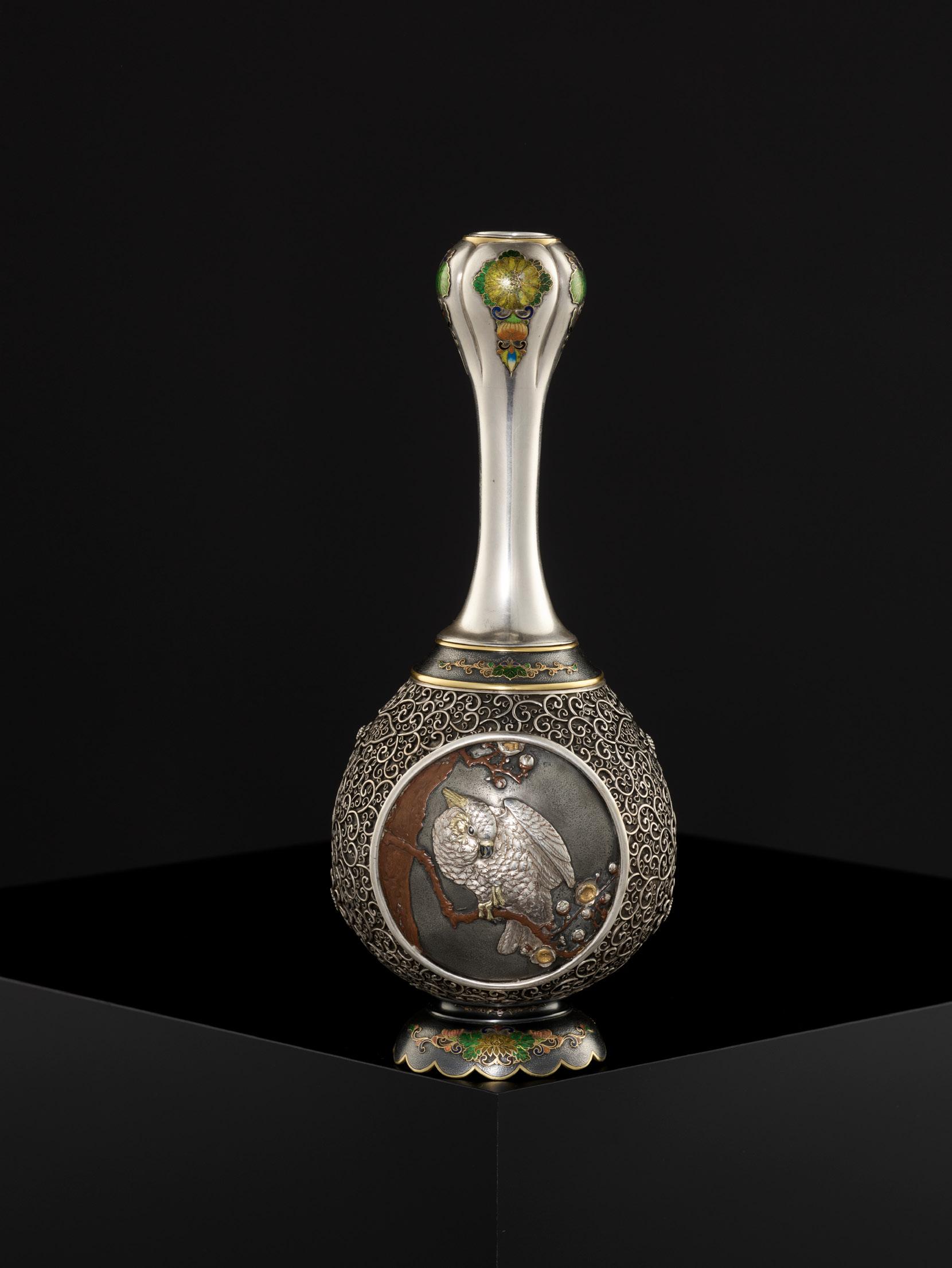

51
A RARE AND EXCEPTIONAL PARCEL-GILT SILVER KORO (INCENSE BURNER) IN THE FORM OF A SUISEI
Japan, c. 1870, early Meiji period (1868-1912)
Superbly cast, the two-horned beast standing proudly with one front leg slightly raised, its fur with neatly incised whorls, the scrolling mane and bushy tail also finely incised, the horns, eyes, fangs, whiskers, and flames are gilt, the pupils in shakudo, the pierced cover cast in the form of the beast’s characteristic carapace, incised with a dating inscription in English, ‘Jan. 1st 1870’.
LENGTH 19.7 cm, HEIGHT 16.8 cm WEIGHT 584 g
Condition: Very good condition with minor wear and traces of use, the tail probably separately cast.
Provenance: British collection.
The suisei is a rarely depicted mythical beast with much the same appearance as a kirin, with the exception of a tortoise carapace on its back.
AUCTION COMPARISON:
Compare a related silver koro in the form of a duck, signed Tsuneaki, dated late 19th century, Meiji period, at Christie’s, 8 December 2016, London, lot 117 (sold for 18,750 GBP).

Estimate EUR 15,000 Starting price EUR 8,000

91
52
JOMI EISUKE II: A MASTERFUL SILVER OKIMONO OF A CHIN PUPPY WITH DRUM
By Jomi Eisuke II (1839-1900), sealed Jomi Eisuke Japan, late 19th century, Meiji period (1868-1912)
Superbly cast as a Chin puppy sitting obediently with one paw slightly raised and resting on a shakudo den-den daiko drum decorated with silver, gold, and copper inlays and showing a mitsudomo-e symbol, the dog’s piebald fur ingenuously highlighted with shakudo inlays, its gold-inlaid collar well carved and tied with a copper-inlaid bow at the back of its neck. The underside cast with a gold seal JOMI EISUKE within a circular reserve.
With an associated gold-lacquered wood stand supported on four feet and finely decorated with foliate scroll, dating from the same period.
LENGTH 13.2 cm
WEIGHT 654 g (excl. stand)
Condition: Excellent condition with minor wear. The wood stand with some wear, nicks, and old repairs to feet.
The Japanese Chin, also known as the Japanese Spaniel, is a dog acknowledged for its importance to Japanese nobility. The dogs have a dot or a line on their forehead, which is associated with the touch of Buddha. While most believe that the source breed for the Japanese Chin originated in China, the route by which the Chin arrived in Japan is a widely debated topic. One story claims that the dogs were given to the Japanese royalty in AD 732 as gifts from the rulers of Korea. Others maintain that they were given as gifts to the Empress of Japan as early as the middle of the sixth century or by the seventh century.
Literature comparison: For a related silver koro in the form of a Pekinese dog, see Meiji no Takara: Treasures of Imperial Japan - The Nasser D. Khalili Collection, The Kibo Foundation, 1995, Metalwork part II, no. 122.

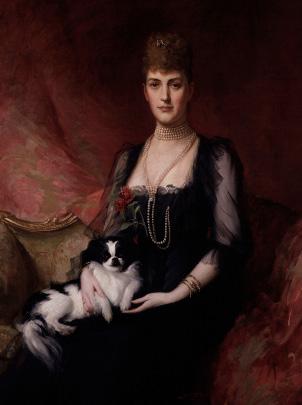
Estimate EUR 25,000 Starting price EUR 12,000

92
Alexandra of Denmark with her Japanese Chin, named Punch, originally painted by Sir Luke Fildes in 1893

HANEHIRO: A FINE SILVERED BRONZE OKIMONO OF A HAWK

By the Hanehiro workshop, signed Hanehiro Japan, late 19th century, Meiji period (1868-1912)
The hawk perched on a naturalistically cast parcel-gilt bronze stand in the form of gnarled and twisted branches, its head lowered and wings outstretched in preparation for flight, the plumage neatly incised, the shibuichi beak with gilt cere and pierced nares, the eyes inlaid with amber glass, the gilt ring-punched feet with raised scales, the long curved claws with darker patination, the underbelly marked HANEHIRO.
HEIGHT 62 cm (incl. stand), WIDTH 53 cm (the wing-span)
WEIGHT 3,298 g (the hawk) and 5,897 g (the stand)
Condition: Excellent condition with minor wear.
The hawk is traditionally a symbol of nobility and wealth, due to the expense of training and caring for the birds.
AUCTION COMPARISON: Compare a silvered-bronze model of an eagle by Masatsune, 64 cm wide, at Bonhams, Fine Japanese Art, 5 November 2020, London, lot 288 (sold for GBP 11,312). Compare a silvered model of a hawk by Masatsune, also with a separately cast giltbronze tree-stump stand, 42.6 cm high, at Christie’s, 20 October 2000, New York, lot 189 (sold for USD 10,575).

Estimate EUR 10,000 Starting price EUR 5,000

94
53

54
SANMI: A MASTERFUL SILVER OKIMONO OF A DRAGON WITH ROCK CRYSTAL SPHERE


By Gyokuryuken Sanmi (art name Kazumi), signed Kazumi with kakihan Japan, late 19th century, Meiji period (1868-1912)
Powerfully cast, the ferocious three-clawed dragon standing atop a rootwood base, its sinuous body precisely rendered with myriad scales and a spiked spine and mane, the eyes picked out in gilt, a separately cast gust of flames emanating from the beast’s jaws holding a rock crystal sphere, signed to the dragon’s underbelly within a shaped reserve KAZUMI with a kakihan (artist’s monogram)
LENGTH 31 cm, HEIGHT 32.5 cm (incl. base)
WEIGHT 3.5 kg (excl. base and sphere)
Condition: Excellent condition with minor wear.
Gyokuryuken Sanmi (art name Kazumi) was an exceptional artist renowned for his masterful silver metal work during the reign of the Meiji emperor.
The dragon is associated with a wealth of legend and symbolism in old Japan, signifying both the holy nature of Shinto and the wisdom of Buddhism. Representations of the dragon are found from the earliest historical period, wall paintings in the stone tomb chambers of the Kofun period (4th-7th centuries) together with tiger, phoenix, and griffin. In Shinto mythology the deity Ryujin is a dragon who lives under the sea and bears a jewel that controls the tides. In esoteric Buddhism, the dragon and the sword indicate the rope and double-edged sword of Fudo Myo-o.
LITERATURE COMPARISON:
For a silver ornament of a dragon and crystal ball see Joe Earle, Splendors of Meiji, Treasures of Imperial Japan, Masterpieces from the Khalili Collection (St. Petersburg, Fla.: Broughton International, Inc., 1999), pl. 135. Also compare to a closely related, yet larger bronze model of a dragon in similar pose, by the Miyao company, Meiji no Takara: Treasures of Imperial Japan - The Nasser D. Khalili Collection, The Kibo Foundation, 1995, Metalwork part II, no. 108.
AUCTION COMPARISON:

Compare a closely related silver model of a dragon by Gyokuryuken Sanmi, signed Kazumi with kakihan, lacking the crystal ball and base, sold at Bonhams, Fine Japanese Art, 19 March 2013, New York, lot 2358 (sold for 128,500 USD).

Compare a related silver dragon with rock crystal sphere by Gyokuryuken Sanmi, also dated late 19th century, Meiji period, 16.8 cm high, at Christie’s, Japanese and Korean Art, 16 March 2021, lot 37 (sold for 62,500 USD).
Estimate EUR 80,000
Starting price EUR 40,000
96




AN IMPRESSIVE BRONZE OKIMONO OF RYUJIN PRESENTING A ROCK CRYSTAL SACRED JEWEL (YASAKANI NO NAGATAMA)

Japan, late 19th century, Meiji period (1868-1912)


The Dragon King of the Sea wearing dragon armor with finely incised scales and a powerfully cast head with fierce expression, tied to his waist over his loose-fitting robes with billowing sleeves, deep folds, and foliate incised hems, holding in both hands the stand supporting his rock crystal sphere which he uses to raise and lower the tides. His face with an intense expression marked by his shakudo-inlaid gilt-ringed eyes, furrowed brows, and spiky beard. His robes, hair and beard are blowing as if he is standing in the midst of a great storm. Mounted on a stepped square base.

HEIGHT 43 cm (excl. stand) and 46 cm (incl. stand) WEIGHT 11.6 kg
Condition: Very good condition with minor wear.
The rock crystal sphere held by Ryujin represents the sacred jewel Yasakani no Nagatami, one of the Three Sacred Treasures, the imperial regalia of Japan. They represent the three primary virtues: valor (the sword), wisdom (the mirror), and benevolence (the jewel). This depiction of the Dragon King of the Sea presenting the jewel appears in woodblock prints of the 19th century as well as two celebrated sculptural groups (see Literature comparison).
LITERATURE COMPARISON:
(1780-1850)
Compare a bronze group in the Khalili collection depicting the sea-god Haneakarutama (essentially, the purely Japanese equivalent of Ryujin) presenting the jewel to Susanoo, illustrated in Meiji no Takara: Treasures of Imperial Japan - The Nasser D. Khalili Collection, The Kibo Foundation, 1995, Metalwork part II, no. 98. For a related version depicting Takenouchi no Sukune and Ryujin by Oshima Joun and others, made for the Second Naikoku Kangyo Hakurankai (Domestic Industrial Exposition) of 1881, see Oliver Impey and Malcolm Fairley, The Dragon of the Sea, Japanese Decorative Art of the Meiji Period from the John R. Young Collection, Oxford, Ashmolean Museum, 1991, cat. no. 11.
AUCTION COMPARISON:

Compare a related bronze figure of Ryujin presenting the sacred jewel, 164.5 cm high, at Christie’s, 20 June 2001, London, lot 101 (sold for 23,500 GBP).
Estimate EUR 12,000 Starting price EUR 6,000
100 55
A woodblock print by Totoya Hokkei
depicting Ryujin presenting tama jewels


56
AN IMPRESSIVE BRONZE OF TWO ONI HOLDING A CRYSTAL BALL, ATTRIBUTED TO SANO TAKACHIKA


Attributed to Sano Takachika, unsigned Japan, late 19th century, Meiji period (1868-1912)
The two grinning demons executed in parcel-gilt bronze and supporting a large crystal ball. One oni has a copper-brown patina while the other is crafted from shakudo. Both wear gilt bracelets at their feet and arms as well as loincloths embellished with gilt details. With an associated burlwood base.
HEIGHT 21.7 cm (incl. crystal ball), HEIGHT 13.5 cm (the bronze only), HEIGHT 24.3 cm (total) WEIGHT 2,292 g

Condition: Very good condition, minor wear, few light surface scratches.
LITERATURE COMPARISON: Compare a near-identical bronze okimono of a single oni holding a crystal ball by Sano Takachika, illustrated in The Nasser D. Khalili Collection of Japanese Art - Treasures of Imperial Japan, Metalwork Part II, 1995, no. 123.
Estimate EUR 8,000 Starting price EUR 4,000
103
57
HIDEMITSU: A LARGE AND IMPRESSIVE BRONZE BOWL WITH TWO DRAGONS

 By Hidemitsu (Shuko), signed Hidemitsu kansei Japan, Meiji period (1868-1912)
By Hidemitsu (Shuko), signed Hidemitsu kansei Japan, Meiji period (1868-1912)
The large revolving bowl with deep rounded sides rising to a galleried twelve-sided rim decorated with pierced diapered manji designs, surmounted by two ferocious dragons with sharp claws, finely incised scales, ridged spines, long horns, and spiked manes, the larger dragon with a small rock crystal tama clutched in its claws, the exterior carved with crashing waves, all supported on a large separately cast base with finely cast and openworked crashing waves, the top of the base cast in the center with the signature HIDEMITSU kansei.
HEIGHT 49.5 cm, WIDTH 45 cm WEIGHT 23.9 kg
Condition: Good condition with minor wear, few minuscule nicks, one beard hair of the larger dragon with a minor old repair. Provenance: British collection.
Estimate EUR 10,000 Starting price EUR 5,000

58
YOSHITANI: A MASSIVE AND HIGHLY UNUSUAL BRONZE JARDINIÈRE DEPICTING A NEST OF RATS

By Yoshitani, signed Dai Nihon Yoshitani sei and isho toroku juken Japan, late 19th-early 20th century, Meiji period (1868-1912)
Heavily cast as a pile of large rats with neatly incised long-haired fur and long tails, the animals further detailed with bulging eyes, deeply incised whiskers, and round ears, the base pierced with six holes. With an associated, finely carved and fitted wood stand supported on five elegantly curved legs with scroll-form feet. With two seal marks underneath reading Dai Nihon YOSHITANI sei [made by Yoshitani in Great Japan] and isho toroku juken [registered holder of patented designs]. The artists’s name 美谷 can be pronounced Mitani, Bikoku, and Yoshitani, which literally means “Beautiful Valley”.
WIDTH 37 cm, HEIGHT 38 cm (incl. stand)
WEIGHT 10.2 kg (excl. stand)
Condition: Excellent condition with minor wear.
In Japan, rats do not have the negative connotations they sometimes do in the Western world. The rat was the first animal to arrive at the New Year’s greeting and so is the first of the Zodiac animals; it represents prosperity of descendants and social success.
Estimate EUR 8,000 Starting price EUR 4,000
106

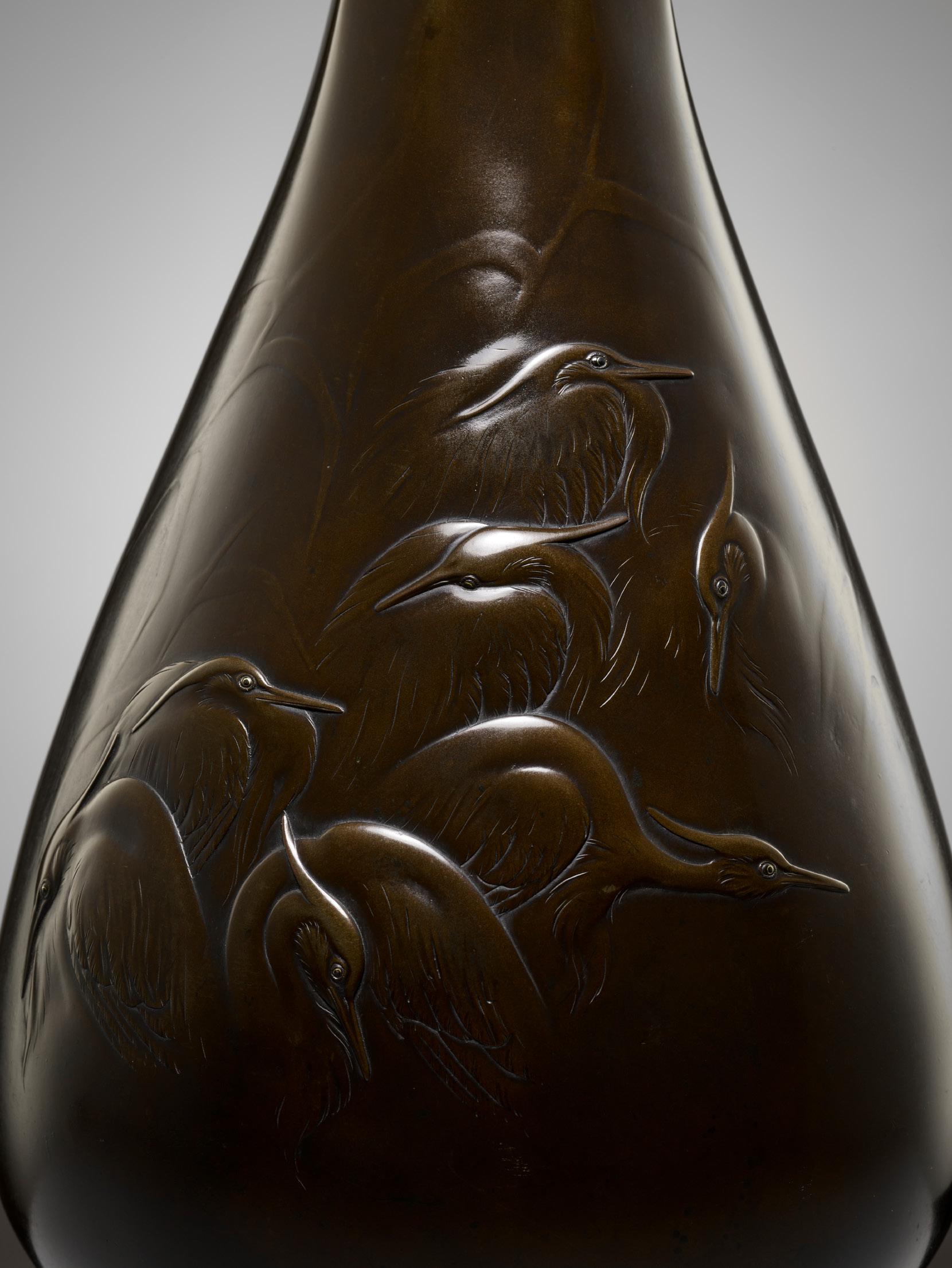
HIDEMITSU: A SUPERB AND LARGE BRONZE VASE DEPICTING HERONS AND LOTUS


By Hidemitsu (Shuko), signed Hidemitsu sei Japan, Tokyo, late 19th century, Meiji period (1868-1912)
The pear-shaped body supported on a waisted foot and rising to a slender octagonal neck with a flared rim, the body superbly cast in relief with a group of seven herons with long beaks and gilt-ringed shakudo eyes perched amid lotus leaves executed in shallow relief which displays a particularly fine, almost misty quality. The other side of the vase is similarly cast with a hanging lotus leaf and a rising lotus pod. The bronze patinated to a warm coppery tone. The base cast HIDEMITSU sei [made by Hidemitsu].
HEIGHT 45.5 cm
WEIGHT 4,374 g
Condition: Very good condition with some wear and minor casting flaws.
Provenance: British collection.
Estimate EUR 5,000
Starting price EUR 2,400
59

60
TAKAHASHI RYOUN: A MONUMENTAL BRONZE VASE WITH A SEA EAGLE


By Takahashi Ryoun, signed Takahashi Ryoun Japan, late 19th century, Meiji period (1868-1912)
The bracket-lobed sides supported on a spreading foot and rising to a tall, gently waisted neck with a flared foliate trumpet mouth, the sides and base of the neck finely carved with a stream surmounted by the applied bronze crashing waves and rockwork base on which a sea eagle is perched, the majestic bird neatly detailed with finely incised plumage, sharp claws, curved beak, and gilt eyes with shakudo pupils. The base with a square seal mark TAKAHASHI RYOUN.
HEIGHT 61.5 cm WEIGHT 14.1 kg
Condition: Very good condition with minor wear, few minuscule nicks, occasional light scratches. Some typical casting flaws.
Provenance: The Strong National Museum of Play, accession number 76.3310 (lacquered to the underside). Margaret Woodbury Strong (1897-1969) grew up in a prosperous family of collectors. Her interests ranged so widely that by 1960 she had amassed more than 27,000 collectible items and works of art. The vast majority of her collections related in some way to play and as her accumulation grew, Margaret planned a museum to house her collection. It eventually opened to the public in 1982, and grew dramatically over the following decades, expanding its collections, facilities, and resources, now spanning over 285,000 square feet. Today, the Strong National Museum of Play (known as just The Strong Museum or simply The Strong) is the only collections-based museum in the world devoted solely to the study of play.
AUCTION COMPARISON: Compare a related bronze vase with a silver eagle, 68.5 cm, at Galerie Zacke, 27 January 2022, Vienna, lot 351 (sold for 13,904 EUR). Another large work by this artist, depicting Daruma, was sold at Zacke, Fine Japanese Art, 28 October 2020, Vienna, lot 27 (sold for 17,696 EUR).
Estimate EUR 5,000 Starting price EUR 2,400
111
61
KOITSU FOR THE NOGAWA COMPANY: A SUPERB AND LARGE INLAID BRONZE VASE DEPICTING A GOJUNOTO PAGODA IN SPRING
By Koitsu for the Nogawa Company, signed Kotisu and with Nogawa company mark Japan, late 19th century, Meiji period (1868-1912)
The slender ovoid body rising to a short waisted neck with a lipped everted rim, masterfully decorated in gold, silver, and shakudo takazogan depicting a five-storied Gojunoto pagoda in spring, the sorin (spire) delicately inlaid, the lower part of the pagoda obscured by the dense foliage of the trees below, with only a few blossoming cherry branches poking out, the base with the Nogawa Company mark. Signed to the back KOITSU koku [carved by Koitsu]. With an associated reticulated wood base.


HEIGHT 32 cm WEIGHT 2,796 g
Condition: Excellent condition with minor wear.
Founded in Kyoto in 1825, during the Meiji era the Nogawa Company developed into a commissioning house that showed at major international expositions between 1893 and 1910 as well as at the Naikoku Kangyo Hakurankai (Domestic Industrial Promotion Exhibitions) in 1881 and 1890. The company had a popular store which was on the “must-see” list for international globetrotters, as well as showrooms in the Kyoto and Miyako Hotels.
Estimate EUR 8,000 Starting price EUR 4,000
112
Spring Evening at Toshogu in Ueno, by Kawase Hasui, 1948

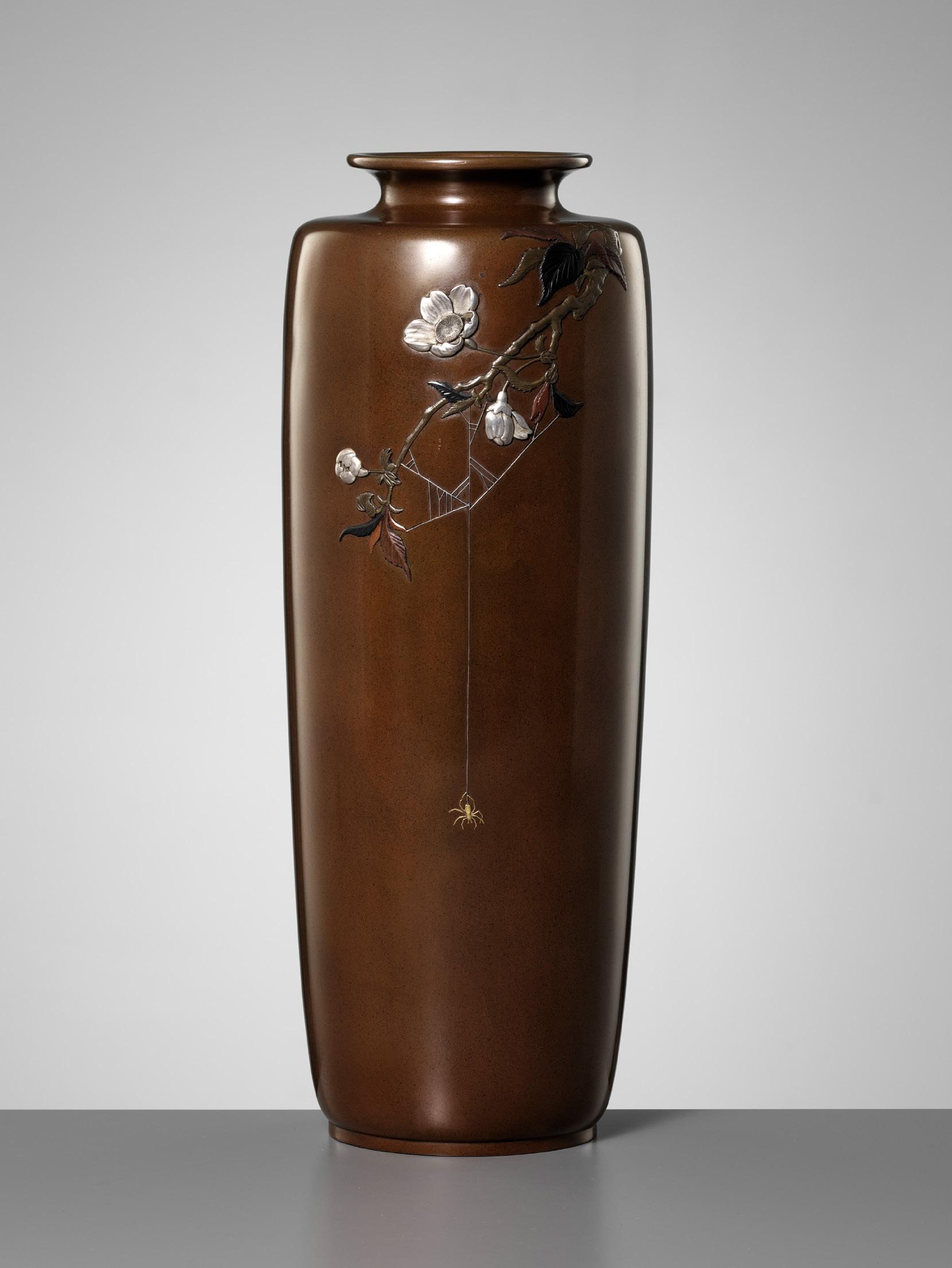
62
OTSUEI FOR THE NOGAWA COMPANY: A MASTERFUL INLAID BRONZE VASE DEPICTING A SPIDER HANGING FROM A PLUM BRANCH


By Otsuei for the Nogawa Company, with company mark and signed Otsuei with kakihan Japan, Meiji period (1868-1912)
The tall slender body rising to a waisted neck with everted lipped rim, the sides finely decorated in iro-e takazogan with a masterful gold spider hanging by a single thread from its irregularly constructed web around a thin prunus branch bearing leaves with serrated edges, slowly opening buds, and a single blossom, the base with the Nogawa Company mark, the reverse signed OTSUEI with a kakihan.
HEIGHT 36 cm WEIGHT 2,684 g
Condition: Excellent condition with minor wear.
Founded in Kyoto in 1825, during the Meiji era the Nogawa Company developed into a commissioning house that showed at major international expositions between 1893 and 1910 as well as at the Naikoku Kangyo Hakurankai (Domestic Industrial Promotion Exhibitions) in 1881 and 1890. The company had a popular store which was on the “mustsee” list for international globetrotters, as well as showrooms in the Kyoto and Miyako Hotels.
AUCTION COMPARISON: Compare a related bronze vase, signed Otsuno with kakihan and with Nogawa Company mark, 32 cm high, also depicting a spider hanging from its web, at Christie’s, 18 May 2012, London, lot 151 (sold for 27,500 GBP).
Estimate EUR 15,000
Starting price EUR 8,000
A PAIR OF SUPERB GOLD-INLAID BRONZE ‘MYTHICAL BEASTS’ KORO (INCENSE BURNERS) AND COVERS


Japan, Meiji period (1868-1912)
Finely decorated in gold, silver, and shakudo takazogan, each censer of compressed globular form, inlaid to one side with a winged mythical beast chasing a ribboned vase and to the other with a ribboned vase flanked by a fan and a reishi cloud, the shoulder applied with baku-form handles suspending loose gold rings, the domed cover decorated with gold-inlaid swirling clouds above a lappet border and surmounted by a baying kirin, raised on three elongated legs encircled by three-clawed dragons and centered by a gold tama, above an elaborately cast and openworked tiered hexagonal base.
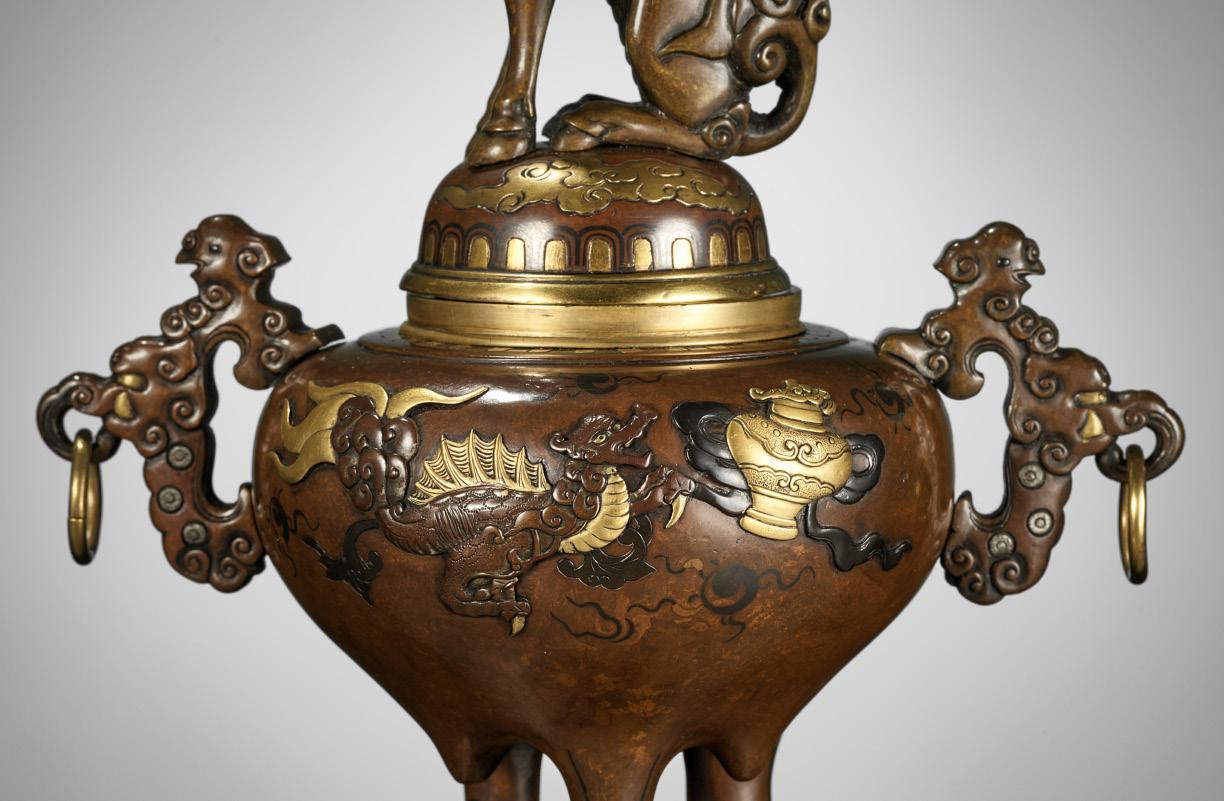
HEIGHT 38 cm and 37.5 cm WEIGHT 2,802 and 2,816 g
Condition: Very good condition with minor wear and few minuscule nicks.
The present koro depicts three of the most iconic Japanese mythical creatures. Dragons are hugely significant in Asian culture. Known as the Ryu or Tatsu in Japan, they are closely related to the Chinese Long and Korean Yong. The Japanese dragons rarely fly and usually reside in or near the sea and other bodies of water. Japanese dragons have positive symbolism. They are good and represent wisdom and generosity, and they are portrayed as using their powers to help mankind. The baku is a mythical Japanese chimeric creature which loosely resembles an elephant; it is said they eat nightmares and protect from pestilence and evil. The kirin (Qilin in Chinese) is a mythical chimerical creature common in artworks and legends across most of East Asia, it is believed to have originated in China around the 5th century BC. The Japanese kirin resembles a deer with long slender legs and horns; it is said that they are peaceful creatures with great power, they are able to walk on grass without disturbing a single blade, and they only appear at times when there is peace in the world. When the giraffe was first brought to Japan it greatly resembled the Kirin and so the Japanese word for giraffe is kirin.
Estimate EUR 8,000 Starting price EUR 4,000
63

MIYAO: A SUPERB AND IMPRESSIVE PARCEL-GILT CENSER DEPICTING WATANABE NO TSUNA FIGHTING THE ONI IBARAKI
 By
By
Miyao Eisuke of Yokohoma, signed Miyao zo Japan, late 19th century, Meiji period (1868-1912)
Heavily cast as the Rashomon Gate, the cylindrical vessel with elaborate stylized demon masks and shaped panels enclosing leafy peony sprays against a wood-grain ground, a smaller cylindrical pole beside the vase is similarly decorated with panels showing inome (boar’s eye) elements and surmounted by the fierce oni with finely incised curled hair, two gold horns, and a floral garment, the demon being pulled down by the great samurai in the process of drawing his trusty sword. The censer fitted with a metal inset. The reverse of the vase signed in a gold-inlaid rectangular reserve MIYAO zo.

HEIGHT 57 cm WEIGHT 18.1 kg
Condition: Very good condition with some wear, the sword blade lost. Presents beautifully. Provenance: From a Swedish private collection.
Founded by Miyao Eisuke, the Miyao Company of Yokohama specialized in the manufacture of bronze sculptures, embellished with gold and silver as well as patinated copper alloys, that represent generic samurai warriors as well as more precisely identifiable characters from Japanese myth and legend. In addition, the company also made a smaller number of pieces in other formats such as incense-burners, vases, and chargers.
According to legend, in the late 10th century of Heian Period Japan, Ibaraki-doji, a notorious oni, resided at Rashomon Gate in Kyoto. Ibaraki-doji harassed people who tried to pass through the gate until a heroic samurai named Watanabe no Tsuna, a loyal retainer of Minamoto no Raiko, went to subdue the creature. When
Tsuna arrived at Rashomon Gate he was attacked by Ibaraki-doji. However, Tsuna was a strong and valiant swordsman who was able to defend himself against the ferocious attack. The battle raged on until Tsuna drew his katana and severed the arm of the demon. Screaming in pain, Ibaraki-doji ran away from Tsuna, leaving the severed arm behind. Tsuna swept up Ibaraki-doji’s arm as a trophy. When he arrived home at his mansion, he wrapped up the severed arm and locked it away in a chest. A few days later, an elderly woman claiming to be Tsuna’s aunt, Mashiba, came to visit him. During the conversation, the aunt asked her nephew to recount how he fought with the oni, and when Tsuna mentioned that he had the severed arm in his possession, his aunt was curious and asked to see it. The unsuspecting Tsuna brought out the chest with Ibaraki-doji’s arm inside and when he removed the arm, his aunt revealed herself as being Ibaraki-doji in disguise. She grabbed the arm and escaped from Tsuna’s mansion. Tsuna was astonished that Ibaraki-doji had posed as his elderly aunt and did not give chase. However, even after retrieving the arm, Ibaraki-doji never returned to dwell at Rashomon Gate again.
AUCTION COMPARISON:
Compare a related bronze by the workshop of Miyao Eisuke, 67.3 cm high, at Christie’s, 24 June 2014, New York, lot 28 (sold for 37,500 USD).

Estimate EUR 10,000 Starting price EUR 5,000
A woodblock print depicting Watanabe no Tsuna fighting Ibarakidoji at Rashomon Gate by Masayoshi (1764-1824)

118
64
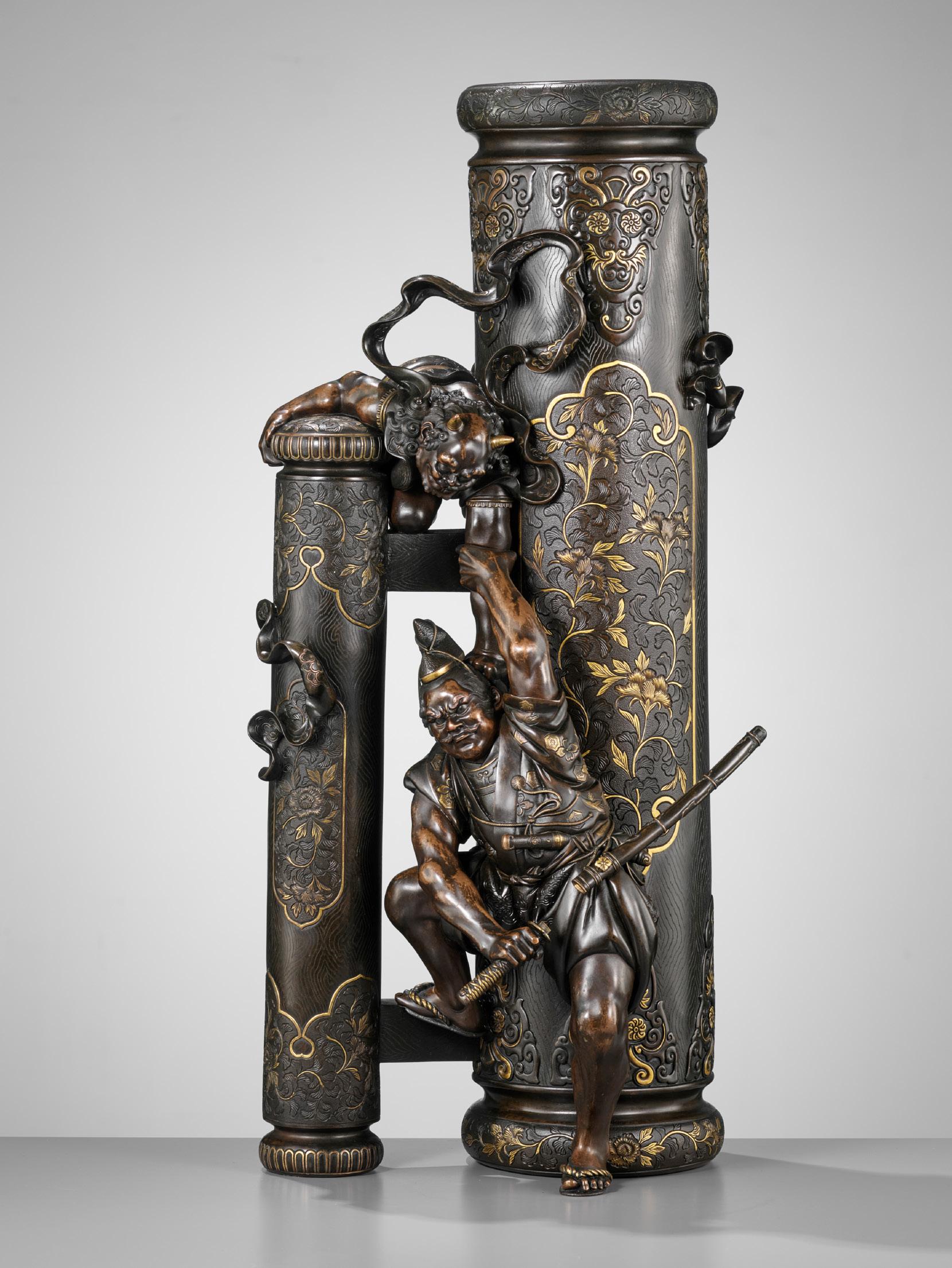




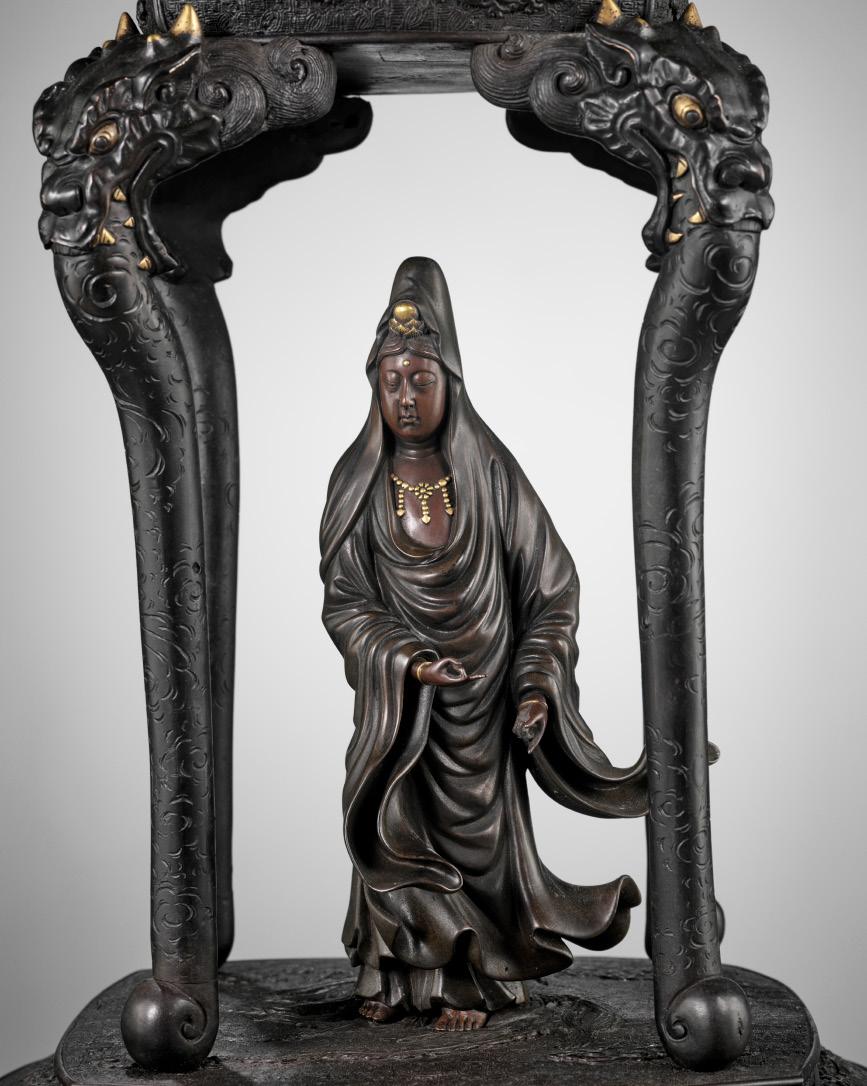
Japan, Meiji period (1868-1912)
The koro of rounded square form, fitted with a metal inset, the sides with two shaped panels in gold, copper, and shakudo takazogan to depict a rakan and oni conversing, the arhat wearing loose robes and holding a small figure of Kannon while the demon holds a staff, the reverse panel depicting pheasants and peony, the body cast with raised floral diaper and foliate designs against an archaistic scroll ground and flanked by two scrolling cloud-form handles. The cover similarly cast and surmounted by a boy wearing a gold-inlaid robe decorated with clouds and flowers, standing in a dynamic pose beside a red-capped crane with silvered body and plumage. The vessel is supported on four long legs issuing from fierce dragon heads atop a tiered base which is crisply cast with stylized butterflies surrounding a ho-o bird against a diapered ground, a superbly patinated and gold-inlaid figure of Kannon wearing a long flowing robe with deeply incised folds standing atop the base which is raised on four short feet decorated with goldinlaid ho-o birds. Unsigned, however confidently attributed to the Miyao company of Yokohama.
HEIGHT 91 cm WEIGHT 14.6 kg
Condition: Very good condition with minor wear, minimal casting flaws, few minuscule nicks, occasional light surface scratches. Provenance: British collection.
Founded by Miyao Eisuke, the Miyao Company of Yokohama specialized in the manufacture of bronze sculptures, embellished with gold and silver as well as patinated copper alloys, that represent generic samurai warriors as well as more precisely identifiable characters from Japanese myth and legend. In addition, the company also made a smaller number of pieces in other formats such as incense burners, vases, and chargers.
AUCTION COMPARISON: Compare a related parcel gilt bronze censer, measuring 44.5 cm, also with rakan and oni motif and by the Miyao company, sold at Zacke, Fine Japanese Art, 4 June 2021, Vienna, lot 6 (sold for 17,696 EUR).

Estimate EUR 15,000 Starting price EUR 8,000

122
65
A TALL AND IMPRESSIVE PARCEL GILT BRONZE KORO (INCENSE BURNER) AND COVER, ATTRIBUTED TO THE MIYAO COMPANY



66
MIYAO: A RARE AND FINE PARCEL GILT BRONZE OKIMONO OF A DRUNKEN SHOJO


By Miyao Eisuke of Yokohama, signed Miyao sei kore Japan, Meiji period (1868-1912)
The visibly drunken Shojo kneeling with a large sake cup in its hands, the inebriated facial expression masterfully crafted, the mouth agape ready to take a large gulp of the silver-inlaid sake, the long hair neatly incised and falling down the back, dressed in a robe richly decorated with gilt flowers and wave patterns, signed within a gold plaque underneath MIYAO sei kore. With an associated lobed base embellished in gold takamaki-e with water dragons amid crashing waves.
HEIGHT 19 cm
WEIGHT 3,774 g
Condition: Excellent condition with minor surface wear, some light surface scratches, tiny nicks.
Provenance: British collection.
The Miyao workshop was founded in the mid-19th century by Miyao Eisuke of Yokohama and is renowned for its powerful portrayals of legendary and historical figures made of bronze, often decorated with gilt and silver.
A Shojo is a Japanese sea spirit with similarities to a ghost but differing from the latter in the fact that Shojo are tangible. It enjoys drinking alcohol, especially sake. Legend has it that workers at breweries in Japan have seen Shojo lurking about after indulging in their products.
Estimate EUR 6,000
Starting price EUR 3,000
125
67
A PAIR OF PARCEL-GILT BRONZE FIGURES DEPICTING SAMURAI WARRIORS

Japan, Meiji period (1868-1912)
Each figure is finely cast and supported on a carved wood stand raised on four curved feet and decorated with pierced floral designs. The samurai is captured mid-leap with one foot raised, his body plunging forward with both hands clutching his sword above his head. The archer is preparing to shoot an arrow at his target, his body in a back-leaning stance with the front leg fully outstretched and the other slightly bent, a sword tucked into his belt. Both warriors with neatly detailed facial features and armor. Viewed as a pair, it is easy to imagine this samurai and archer embroiled in a vicious fight to the death that is about to reach its end, though the outcome is still unsure.
HEIGHT 20.2 cm (the samurai excl. stand), 16.5 cm (the archer excl. bow and stand), and 22.7 cm (the archer excl. stand)
WEIGHT 1,354 g (the samurai incl. stand), 1,092 g (the archer incl. stand)
Condition: Excellent condition with minor wear.
AUCTION COMPARISON:


Compare a closely related group of samurai warriors of similar size, by the Miyao company, sold at Bonhams, Fine Japanese Art, 8 November 2018, London, lot 246 (sold for 7,500 GBP). Also compare to a closely related giltbronze figure of a warrior by Miyao, measuring 27.5 cm, sold at Bonhams, Fine Japanese Art, 6 November 2012, London, lot 507 (sold for 16,250 GBP).
Estimate EUR 8,000 Starting price EUR 4,000
126



68
TAMAGAWA MITSUKIYO FOR THE KAKUHA COMPANY: A SUPERB SILVER AND GOLD-INLAID BRONZE USUBATA VASE
By Tamagawa Mitsukiyo for the Kakuha company, signed Dai-Nihon Etchu-koku, Kakuha sei, Mitsukiyo Japan, c. 1880, Meiji period (1868-1912)
The ovoid body flanked by two openworked handles depicting ho-o birds at flight amid scrolling clouds and decorated in gold, silver, copper, and shakudo takazogan within shaped panels depicting to one side a samurai carrying a noble lady on his shoulder amid pine and bamboo with finely incised crashing waves in the background, and to the other the hero Saginoike Heikuro fighting a giant python with neatly incised scales atop a craggy rock amid crashing waves and a waterfall. The separately cast trumpet mouth with a galleried rim inlaid in silver wire with a geometric and a foliate band, the base of the mouth with silver-inlaid leafy floral blossoms, the interior with katakiri and kebori as well as gold and copper takazogan to depict a ho-o bird beside a leafy branch and a kirin amid swirling clouds, the exterior similarly decorated with birds and butterflies amid leafy branches and peony.
The separately cast, elaborately openworked, tiered stand is intricately decorated with gold and silver inlay, both flat and in high relief, as well as katakiri and kebori, depicting beast masks, birds in flight, blooming chrysanthemums, leafy bamboo, and implements for the shell-matching game (kai-awase), and further with geometric and foliate designs.
HEIGHT 59 cm WEIGHT 13.9 kg
Condition: Excellent condition with minor wear.
Provenance: British collection.
Kakuha Kanzaemon I, real name Kakuha Zenjiro, was a member of a lineage of metalworkers from Toyama. In 1869, he started a branch office in the port of Yokohama for the export trade of bronze ware and also acted as a retailer for foreign clients in Japan.
Based on Chinese bronze forms but with exaggeratedly wide rims, usubata were first cast in Japan in the seventeenth century for formal flower arrangements; then, during the early Meiji era, elaborate multi-part usubata became one of the favored forms of bronze destined for international exhibitions and the global export market.




MUSEUM COMPARISON:
The artist Tamagawa Mitsukiyo appears to be rare, his output focused on producing exceptionally fine usubata. A single usubata is preserved in the Takaoka City Museum of Art and a pair of Usubata are located in the Portland Museum of Art, accession no. 2000.64A,B.
AUCTION COMPARISON:
Compare a pair of related usubata vases by Tamagawa Mitsukiyo, dated Meiji period, circa 1880, each 48 cm high, at Bonhams, Fine Japanese Art, 7 November 2019, lot 219 (bought-in at an estimate of 25,00030,000 GBP).
Estimate EUR 10,000 Starting price EUR 5,000
129
Woodblock print by Kuniyoshi depicting Saginoike Heikuro fighting the giant snake at the lake of Sayama


A FINE INLAID IRON PANEL DEPICTING EGRETS AND LOTUS


Japan, late 19th century, Meiji period (1868-1912)
The roughly textured iron ground finely decorated in gold, silver, and bronze takazogan to depict two egrets, one flying and the other standing in a lotus pond, surrounded by giant leaves, buds, blossoms, and reeds, the pond rendered with subtly incised lines.
SIZE 50 x 33.5 (the panel) and 57 x 41 cm (incl. frame)
WEIGHT 3,360 g
Condition: Very good condition with minor wear.
With an old wood frame.
AUCTION COMPARISON: Compare a related inlaid iron panel signed Fukuda Michiharu zo, also dated late 19th century, Meiji period, 59 cm high, at Sotheby’s, Fine Japanese Art, 14 May 2019, London, lot 168 (sold for 8,750 GBP).
Estimate EUR 5,000 Starting price EUR 2,400
69
70
A MASTERFUL PARCEL-GILT BRONZE VASE DEPICTING A TREE TRUNK WITH AUTUMN LEAVES

Japan, late 19th century, Meiji period (1868-1912)
Superbly cast as a gnarled and knotted tree trunk bearing thin branches issuing maple leaves, exquisitely patinated and gilt to convey the turning of the leaves, which are further detailed with neatly incised veins and finely serrated edges, the stump masterfully finished with a strikingly naturalistic texture, the straight rim incised with growth rings.
HEIGHT 35.8 cm
WEIGHT 4,844 g
Condition: Excellent condition with minor wear. Provenance: From a Belgian private collection, assembled between 1950 and 1990.
The present vase, impressively cast in a minimalist yet naturalistic manner, was clearly made by an extremely talented metalworker. The masterful use of patination and the superb texture of the bronze style make an attribution to the workshop of Miyao Eisuke reasonable.

AUCTION COMPARISON: Compare a related pair of bronze figural vases by Miyao Eisuke at Sotheby’s, 15 December 2011, Paris, lot 337 (bought-in at an estimate of 20,000-30,000 EUR).
Estimate EUR 5,000 Starting price EUR 2,400
132

71
A SUPERB SHAKUDO OKIMONO DEPICTING AN AUTUMNAL SCENE OF A CROW WITH MAPLE LEAVES
Japan, c. 1900, Meiji period (1868-1912)
Naturalistically modeled as a karasu (crow) perched on a rock, formed from a section of rootwood, its beak holding a maple leaf, the rootwood base with further silver-inlaid fallen maple leaves, the gold and shakudo eyes staring in the distance, the plumage very finely incised.



HEIGHT 19 cm WEIGHT 1,194 g
Condition: Very good condition, minor wear. The base with a fine, smooth polish. Provenance: British collection.
Meiji metalwork depicting crows is to be considered rare, with only few examples recorded in literature and public collections. In Japan, the crow is a symbol of gratitude and family love. It is also considered the divine messenger of good omens. The Kojiki (713) relates that the crow Yatagarasu guided the mythical founder of Japan, Emperor Jinmu (660-585 BC), on a military campaign to Yamato.
LITERATURE COMPARISON:
Compare a closely related shakudo model of a crow by Masatsune, illustrated in The Nasser D. Khalili Collection of Japanese Art - Treasures of Imperial Japan, Metalwork Part II, 1995, no. 104.
Estimate EUR 8,000 Starting price EUR 4,000
134

72
INOUE: A SUPERB INLAID BRONZE DISH DEPICTING BOYS ON A DRAGON BOAT

By Inoue company of Kyoto, signed Kyoto Inoue sei Japan, late 19th century, Meiji period (1868-1912)

The shallow rounded sides rising from a short spreading foot to a gold-inlaid lobed rim with a masterful Komai-style lozenge design, encircling a central medallion finely decorated in iro-e takazogan with three boys dressed in Korean festive garments and standing in a dragon boat in a lotus pond with neatly incised blossoms and furled leaves, detailed in katakiri, all below a long-tailed ho-o bird in flight. One boy is standing in the back, holding a long staff with reishi terminal, beside a flag waving in the wind, above a second boy dancing and holding a drumstick and fan, wearing a peacockfeathered hat, the third boy standing behind the large dragon head holding a trumpet in his hand, all against a rich copper-brown patinated ground. The base with the gilt signature Kyoto INOUE sei [made by Inoue of Kyoto].
DIAMETER 27.4 cm WEIGHT 1,234 g
Condition: Very good condition with minor wear. Provenance: British collection.
Estimate EUR 6,000 Starting price EUR 3,000
136


73
A MATCHED PAIR OF GOLD-INLAID BRONZE ‘BUDDHIST TEMPLE BELL’ KOGO (INCENSE CONTAINERS), ONE BY MIYABE ATSUYOSHI
One by Miyabe Atsuyoshi, signed Ikkodo Japan, late 19th century, Meiji period (1868-1912)
Each cast in the form of a bell, the dark-brown patinated bronze decorated in gold, silver, and copper takazogan to depict a fierce three-clawed dragon with neatly incised scales, its sinuous body partly obscured by the surrounding swirling clouds and crashing waves, a lotus motif on either side, with a band of formal lappet ornament inlaid in gold around the base, the domed lid with gold lappets and raised bosses imitating those on a real bell, surmounted by a handle in the form of a double-dragon head. One bell is signed to the base IKKODO – the art name of Miyabe Atsuyoshi.

HEIGHT 12.8 cm (each)
WEIGHT 757.6 g and 639.2 g
Condition: Excellent condition with minor wear.
During the Meiji era, Japanese metalworkers began to manufacture ornaments in the form of Buddhist temple bells. Reflecting increasingly sophisticated Western interest in native traditions and beliefs, such pieces were mostly intended not for liturgical use in Japan but as ornaments for American and European drawing rooms. Even so, their makers made an effort to give them the appearance of miniaturized versions of the real thing, sometimes as with this particularly high-quality lot adding fanciful surface motifs that appealed to foreign taste for exotic myth and legend.
Miyabe Atsuyoshi, art name Ikkodo, is recorded in Wakayama Takeshi, Kinko Jiten (Dictionary of Metalworkers), Tokyo, Token Shunju Shinbunsha, 1999, p. 1141, as being a maker of sword fittings and a pupil of Shinoyama Tokuoki (1813-1891), active in Kyoto during the late Edo period and early Meiji era.
Although the present boxes and covers were not conceived as a pair, they match perfectly and it can be seen as a great (and unlikely) accomplishment by the collector to have brought the two together.

AUCTION COMPARISON: Compare a closely related single kogo (incense container) with Nogawa mark, sold at Christie’s, Masterful Exuberance, Artistic Craftsmanship of Imperial Japan, 18 May 2012, London, lot 23 (sold for 11,875 GBP).
Estimate EUR 12,000 Starting price EUR 6,000
139

74
CHOMIN: A SUPERB PAIR OF INLAID BRONZE VASES WITH MINOGAME AND GEESE
By Chomin (Nagatami), signed Chomin Japan, late 19th century, Meiji period (1868-1912)
Each of ovoid form, supported on a short spreading foot and rising to a waisted neck with everted rim, decorated with fine incision work as well as masterfully executed flat and relief inlays in gold and silver takazogan. One vase depicts a minogame on a rocky outcrop below the full moon partly obscured by swirling clouds, a small turtle below the majestic thousand-year-tortoise. The other vase depicts three geese descending from the sky above trees and bamboo leaves, the reverse with swirling clouds. The base of each with a rectangular silver reserve incised with the signature CHOMIN.

HEIGHT 29 cm and 28.9 cm WEIGHT 2,418 g and 2,220 g
Condition: Excellent condition with minor wear.
Takahashi Ryoun lived in Tokyo and was active from the late Meiji period into the early Showa period. He graduated from the Tokyo School of Fine Arts and was famed for his skill in bronze casting. The Tokyo Casting Association lists him as a designated special member, a ranking reserved only for the best artists. He exhibited his works at the Paris Great Exposition in 1900: three pieces were entered in the Exhibition Catalogue Two (Q 107, 161, 175), and one piece was exhibited in the Award Winning Catalogue. His work can be found in the Museum of the Japanese Imperial Collections (Sannomaru Shozo-kan) in Tokyo.
Estimate EUR 8,000
Starting price EUR 4,000
141

75 MIYABE ATSUYOSHI: A PAIR OF FINE INLAID BRONZE VASES


By Miyabe Atsuyoshi, signed Ikkodo Miyabe Atsuyoshi with kakihan Japan, late 19th-early 20th century, Meiji period (1868-1912)
Each of slender ovoid form, supported on a short straight foot and rising to a waisted neck with a galleried rim, the shoulder and rim neatly incised with key-fret bands, finely decorated in gold, silver, copper, and shakudo takazogan as well as katakiri and kebori to the neck with autumn leaves and to the body with a front panel enclosed by gold cranes and a reverse panel with the edge in the form of crashing waves, each reserved against a deeply incised diapered ground interrupted by gold-inlaid wavy and floral designs. One vase depicts owls perched on leafy blossoming branches with the full silver moon partly obscured by a raised wispy cloud to the front and a towering pine tree in front of a long bridge with Mount Fuji in the background to the reverse, the other vase with a bird of prey clutching a small bird above a stream amid snowy bamboo and leaves to the front and a lakeshore scene with a fishing hut and trees to the reverse. The base of each vase is signed IKKODO MIYABE ATSUYOSHI with a kakihan (artist’s monogram).
HEIGHT 23.5 cm (each)
WEIGHT 978 g and 1,018 g
Condition: Excellent condition with minor wear. Provenance: British collection.
Miyabe Atsuyoshi, art name Ikkodo, is recorded in Wakayama Takeshi, Kinko Jiten (Dictionary of Metalworkers), Tokyo, Token Shunju Shinbunsha, 1999, p. 1141, as being a maker of sword fittings and a pupil of Shinoyama Tokuoki (1813-1891), active in Kyoto during the late Edo period and early Meiji era. Working out of Kyoto, Miyabe Atsuyoshi exhibited works domestically and internationally at the turn of the twentieth century, such as at the 1904 World’s Fair in St. Louis, MO.
LITERATURE COMPARISON:
Compare an inlaid bronze koro and cover by Miyabe Atsuyoshi, also decorated with an owl, illustrated in Meiji no Takara: Treasures of Imperial Japan - The Nasser D. Khalili Collection, The Kibo Foundation, 1995, Metalwork part II, no. 93.
AUCTION COMPARISON:

Compare a related pair of vases by Miyabe Atsuyoshi, also dated late 19th century, each 30 cm high, at Christie’s, 7 November 2012, London, lot 313 (sold for 12,500 GBP).
Estimate EUR 8,000 Starting price EUR 4,000

143
A FINE INLAID BRONZE VASE WITH QUAIL AND AUTUMN GRASSES

Japan, Meiji period (1868-1912)
The baluster body supported on a spreading foot and rising to a waisted neck with a broad everted rim, the sides finely decorated in iro-e takazogan to depict a quail perched on the subtly incised ground amid autumn grasses and leaves.
HEIGHT 18 cm WEIGHT 700 g
Condition: Good condition with minor wear, minuscule nicks, and light surface scratches.
Provenance: Austrian private collection.
Estimate EUR 1,000 Starting price EUR 500
77
GENRYUSAI SEIYA: A CHARMING AND RARE MINIATURE BRONZE VASE WITH MONKEYS
By Genryusai Seiya, signed Seiya 誠谷 Japan, Meiji period (1868-1912)

The vase with a bulbous body, rising from a short, splayed foot to a trumpet neck, flanked by three clambering monkeys, the larger one holding another monkey’s foot and leaning forward over the edge, a small monkey holding onto the edge of the upper rim. Their eyes inlaid in gilt, and the fur neatly incised. The recessed base signed SEIYA.
HEIGHT 10.8 cm WEIGHT 310.4 g
Condition: Very good condition, minor wear, few small nicks, and dents. Fine, chocolate brown patina.
Provenance: British private collection.
Estimate EUR 1,500 Starting price EUR 800
144
76
78
TANETOSHI: A FINE BRONZE VASE DEPICTING HOTEI GAZING AT THE FULL MOON

By Tanetoshi, signed Tanetoshi saku Japan, late 19th century, Meiji period (1868-1912)
The ovoid body supported on a short waisted foot and rising to a short, slightly flared rim, the sides finely cast in high relief with a characteristically full-bellied Hotei holding his treasure sack in one hand, a gnarled staff in the other, his well-detailed face with a cheerful expression as he looks up to gaze at the full moon. The base signed TANETOSHI saku [made by Tanetoshi].

HEIGHT 27.3 cm WEIGHT 3,297 g
Condition: Very good condition with minor wear, the base with few light surface scratches.
Provenance: British private collection.
Estimate EUR 2,000
Starting price EUR 1,000
79
KAZUTOSHI:
A LARGE AND IMPRESSIVE INLAID BRONZE CHARGER DEPICTING DARUMA AS DAIDARABOTCHI
By Yanagi Kazutoshi, signed Kazutoshi/Ichiju with seal Ichiryu Japan, late 19th century, Meiji period (1868-1912)

Finely decorated in gold, silver, shakudo, and copper takazogan to depict a parody of Daruma (Bodhidharma) posing as Daidarobotchi, detailed with bushy brows, reverse-painted glass eyes, and large thick earlobes, crouching over a snow-capped mountain above two cranes flying over clouds. The rim of silver. Signed to the right in gold takazogan KAZUTOSHI/ICHIJU and with a seal Ichiryu.
DIAMETER 46 cm WEIGHT c. 7,900 g
Condition: Very good condition with minor wear, the base with few minuscule nicks and light scratches.
Yanagi Kazutoshi used the art name Ichiryuken and was also known as Ichiryu Kazutoshi. He was active during the late Edo period and is listed on page 16 in the Toso Kinko Jiten by Wakayama Takeshi, Yuzankaku Publishers.
Daidarabotchi is a gigantic yokai in Japanese mythology, sometimes said to pose as a mountain range when sleeping. The size of a daidarabotchi was so great that his footprints were said to have created innumerable lakes and ponds. In one legend, a daidarabotchi weighed Mount Fuji and Mount Tsukuba to see which was heavier, but he accidentally split Tsukuba’s peak after he was finished with it.
AUCTION COMPARISON: Compare a pair of inlaid iron panels depicting monkeys by the same artist at Sworder’s, Asian Art, 13 May 2022, London, lot 209 (sold for 20,000 GBP).
Estimate EUR 10,000 Starting price EUR 5,000

146


80
JOUN: A SUPERB BRONZE PORTRAIT OKIMONO OF DARUMA

By Kitamura Joun (active c 1926-1968), signed Joun saku Japan, c. 1930
The Zen patriarch standing, his hands folded at the chest shrouded in the sleeves of his long flowing robe billowing around him, only one superbly crafted finger showing, the voluminous folds elegantly and deeply carved, his chest hair subtly incised, his face with a meditative expression, the silver eyes with dark pupils pointing upward, the earrings of gilt metal, his feet wearing sandals with floral straps, the toes neatly detailed. Signed to the back JOUN saku [made by Joun].
HEIGHT 40.3 cm WEIGHT 4,673 g
Condition: Excellent condition with minor wear.
Kitamura Joun exhibited his work at the 15th Nihon Dento Kogei-ten exhibition (Japan Traditional Arts Crafts Exhibition) in 1968 (Showa 43). This artist is not to be confused with Oshima Joun (1858-1940), who used a different character for Jo.
Daruma (Bodhidharma) was an Indian monk who lived during the 5th or 6th century, credited with bringing Buddhism to China. His teachings centered around meditation, as do many of the legends surrounding him. One details how when he fell asleep seven years into his nine years of wall gazing, he became so angry with himself that he cut off his eyelids so he might never sleep again. Where his eyelids hit the floor, the first tea plants grew, providing stimulants to help keep his students awake.
Estimate EUR 10,000 Starting price EUR 5,000

81 SHOKAKEN: A LARGE AND EXCEPTIONAL BRONZE KORO (INCENSE BURNER) AND COVER WITH THE TWELVE ANIMALS OF THE ZODIAC (JUNISHI)

By Oshima Yasutaro (Shokaken), signed Dai Nihon Kanda kawabe ju, Shokaken kore wo chu Japan, late 19th century, Meiji period (1868-1912)
Finely cast, the compressed globular body supported on a tall, prominent foot and rising to a broad cylindrical neck with galleried rim, flanked by two handles in the form of baying kirin with exquisitely rendered curved horns, scrolling manes, and muscular bodies. The slightly domed cover is surmounted by two karako, one standing wearing a shishimai mask and the other seated beside a drum incised with a mitsudomo-e symbol and holding a stick, both showing cheerful expressions. The koro and cover are crisply cast with finely worked diapered patterns, the body is further cast in relief with the twelve animals of the zodiac, each dynamically rendered and neatly detailed to convey the mythical race that would determine their order in the zodiac. The foot is raised on five legs in the form of winged kirin with elongated bodies atop a circular base decorated with concentric diapered bands encircling a raised central medallion cast in relief with sparrows in flight amid swirling clouds. The underside of the foot is cast with the inscription and signature Dai-Nihon Kanda kawabe ju, SHOKAKEN kore wo chu (‘This is cast by Shokaken, resident by the Kanda River, Great Japan’).


HEIGHT 75 cm WEIGHT 19 kg
Oshima Yasutaro (artist name: Shokaken) was born to a prominent family of metalworkers in 1849 and was the son of Oshima Takajiro. Together with his younger brother Oshima Joun (1858–1940), he successfully ran a studio called Sanseisha and produced bronzes of the finest quality. In Recollections of Oshima Joun, by Katori Hozuma published in 1941 by Tokyo Chukin-kai (Tokyo Cast Metalwork Association), he talked of his older brother who died young as being of the first rank of bronze metalwork artists in 1878, producing works of the very highest quality and commissioned for the world exhibitions. Shokaken indeed exhibited his works at numerous international expositions, including a metalwork incense burner at the Vienna World Exposition in 1873, which is now housed in the Austrian Museum of Applied Arts and Contemporary Art, Vienna (Illustrated in Arts of East and West from World Expositions 1855-1900: Paris, Vienna and Chicago (Commemorating the 2005 World Exposition, Aichi, Japan), (Osaka, 2004), p. 20, plate l-16).
Condition: Very good condition with minor wear, minimal casting flaws, few minuscule nicks, occasional light surface scratches. Provenance: French private collection.
AUCTION COMPARISON: Compare a related bronze koro by Shokaken, 50 cm high, at Zacke, 3 December 2021, Vienna, lot 8 (sold for EUR 4,045).
Estimate EUR 4,000 Starting price EUR 2,000
151








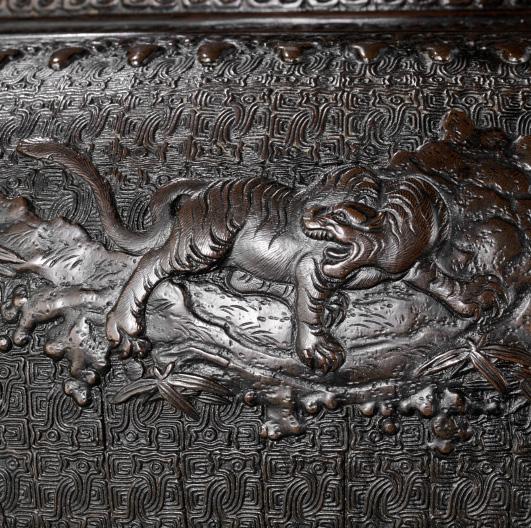

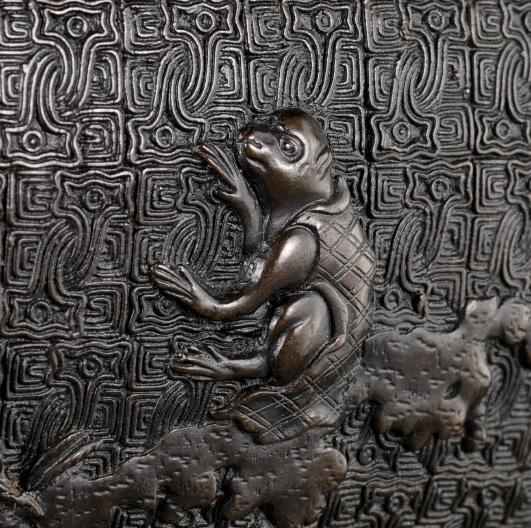

82
FUKUI KYORI & KIYOTOSHI: A LARGE BRONZE KORO IN THE FORM OF A SHACHIHOKO (DRAGON FISH)



By Fukui Kyori and Kiyotoshi, signed Fukuri Kyori zo and Kiyotoshi with kakihan Japan, late 19th century, Meiji period (1868-1912)
Superbly cast as a gigantic dragon fish, its head resting on the separately cast massive four-legged base with crashing waves both neatly incised to the top and cast in relief on the rim and feet, the sides with craggy rockwork in low relief, the shachihoko with a fierce expression marked by bulging eyes with gilt pupils, spiky brows and mane, and sharp fangs, the mouth agape in a roar, its head surmounted by the pierced cover with a standing Otohime, the daughter of Ryujin, wearing a long flowing robe blowing in the wind and a headdress. The dragon fish’s underbelly with a square aperture for attachment to the base and signed FUKURI KYORI zo, the base signed KIYOTOSHI with a kakihan.
HEIGHT 50.5 cm (incl. base) and 40.5 cm (excl. base)
WEIGHT 8,814 g (the dragon fish) and 5,796 g (the base)
Condition: Very good condition with minor wear and casting flaws, few minuscule nicks, occasional light scratches, few minor losses.
Provenance: French trade.
The given names Kiyotoshi (Seiri) and Kyori (Atsutoshi/Takatoshi) suggest that both artists were from the same family or worked at

the same studio, as they share the second character ro/toshi. For a smaller bronze okimono of a rakan, signed Fukui Kiyotoshi, see Bonhams, Fine Japanese Art, 14 May 2015, London, lot 419.
The Chinese character for shachi is composed of two radicals, that for ‘fish’ and that for ‘tiger’. The creature is sometimes referred to as a ‘tigerfish’, the face resembling a tiger or the mythical leonine shishi. However, the present example has a long face with the horns and whiskers of a dragon. It was believed that this animal could cause the rain to fall, and as such, temples and castles were often adorned with roof ornaments (crafted in the form of a shachihoko), in order to protect them from fire.
A shachihoko on the roof of Nagoya Castle
AUCTION COMPARISON: Compare a related smaller bronze koro in the form of a shachihoko, 31.1 cm high, lacking the base and figural cover, at Bonhams, Fine Japanese and Korean Art, 11 September 2019, New York, lot 915 (sold for 2,550 USD), and another by Kamejo, dated Meiji or Taisho period, 21 x 23 cm, at Bonhams, Fine Japanese Art, 8 November 2018, London, lot 231 (sold for 6,250 GBP).
Estimate EUR 2,500 Starting price EUR 1,200
153

A MASSIVE BRONZE KORO AND COVER WITH TOKUGAWA MON
Japan, 19th century, late Edo period (1615-1868)
The sides of the vessel are finely worked in relief with two panels framed by ferocious dragons amid clouds, depicting to one side Lady Rokujo at the Nonomiya Shrine, with long hair and dressed in a long flowing court dress, standing in the sacred bamboo enclosure amid jars filled with water and reading a love-letter from Prince Hikaru Genji. The other panel depicts her as a vengeful spirit wearing a mask of Hannya, and clutching her long, finely incised hair with one hand.
The ovoid vessel supported on a revolving foot cast with crashing waves above a compressed globular ‘basketweave’ segment raised on four elegantly curved legs on a tiered circular base. The pierced cover surmounted by a screeching eagle with fierce expression and outstretched wings. The vessel is flanked by two handles in the form of sinuous dragons with neatly incised scales and mouths wide open, with a third dragon writhing around the foot. The neck is cast to either side with the Tokugawa clan mon (aoi mon), while the cover and base are decorated with crests of six radiating aoi leaves. The base with a cho mon (butterfly crest).
With a finely carved wood stand supported on four elegantly curved legs with scroll-form feet above an apron carved with clouds and foliage surmounted by a tiered square platform carved with decorative bands.
HEIGHT 132 cm (censer only), HEIGHT (total) 180 cm WEIGHT 28 kg (excl. stand)
Lady Rokujo is a character in The Tale of Genji (Genji Monogatari). She is a mistress of the novel’s protagonist, Hikaru Genji, with whom she becomes infatuated and jealous of his other lovers. Her jealousy subconsciously causes her ikiryo (wandering spirit) to become a Shiryo (also known as a Yurei) that attacks and murders multiple other mistresses and wives of Genji.
The Tokugawa’s clan symbol, known in Japanese as a mon, the “triple hollyhock” (although commonly, but mistakenly identified as “hollyhock”, the aoi actually belongs to the birthwort family and translates as “wild ginger”—Asarum), has been a readily recognized icon in Japan, symbolizing in equal parts the Tokugawa clan and the last shogunate.
The cho (butterfly) mon traditionally represents the Taira Clan, who prospered during the Heian era (AD 700 ~ 1200). They are recognized as the first to use this mon, and nearly all of the modern families who claim it are descendants of the Taira clan.
AUCTION COMPARISON:
Compare a related bronze koro with eagle finial, dated to the late 19th century, measuring 149.8 cm, sold at Bonhams, Fine Japanese and Korean Art, 12 September 2012, New York, lot 3373 (sold for 15,000 USD).

Estimate EUR 8,000 Starting price EUR 4,000

155
83
Condition: Good overall condition with some wear, tiny nicks, light scratches, some repairs with traces of soldering, minor losses. Provenance: Belgian private collection.



84
GENRYUSAI SEIYA: A VERY LARGE AND IMPRESSIVE BRONZE OKIMONO OF AN EAGLE
By Genryusai Seiya, signed Genryusai Seiya zo Japan, Meiji period (1868-1912)
Superbly cast, the majestic eagle perched on a separately cast rocky outcrop above swirling and crashing waves, the smooth water and roughly textured rock creating a striking contrast, the eagle with intricately incised plumage, the wings spread out as the bird is about to take flight, its eyes in shakudo with gilt-ringed pupils, the strong beak elegantly curved, signed underneath within a square reserve GENRYUSAI SEIYA zo [Made by Genryusai Seiya].
HEIGHT 83.7 cm (incl. base), WIDTH 93.7 cm (the wingspan) WEIGHT 36.7 kg
Condition: Very good condition, minor wear and casting flaws as are to be expected.
Provenance: Austrian private collection.
Genryusai Seiya was a master craftsman in charge of a workshop specializing in export wares of the highest quality. Production included human genre figures, vases and exotic bronze models of animals probably influenced by the opening of Tokyo Zoological Gardens in 1882. The present piece is a brilliant example of Seiya’s naturalistic bronzes.
AUCTION COMPARISON:
Compare a closely related bronze model of an eagle by Genryusai Seiya, 92.2 cm wide, with a gnarled wood stand as opposed to the bronze base of the present lot, at Christie’s, Japanese and Korean Art, 22 March 2001, lot 226 (sold for 17,625 USD).



Estimate EUR 15,000
Starting price EUR 8,000
159
85
AKASOFU GYOKKO: AN IMPRESSIVE AND RARE BRONZE OKIMONO OF AN ASCENDING EAGLE
By Akasofu Gyokko (Gyoko), signed Gyokko Japan, late 19th century- early 20th century, Meiji period (1868-1912)
Finely cast, the bronze patinated to a highly attractive, almost black finish, the majestic bird about to soar but as of now still perched atop a gnarled rootwood base, its wings bent backwards, stretched out and head raised toward the sky, the details such as the curved beak, gilt-ringed pupils, and incised plumage neatly rendered, the bronze signed within a rectangular reserve underneath GYOKKO.
HEIGHT 45 cm (incl. base), WIDTH 43 cm WEIGHT 5,770 g (the eagle), 2,874 g (the base)
Condition: Excellent condition with minor wear.
Provenance: British collection.
Akasofu Gyokko (dates unknown) lived in Tokyo, his factory producing cast metalwork for export. His given name was Sotojiro and he is recorded as a member of the Tokyo Chukinkai (Tokyo Cast Metalworkers’ Association) in the second half of the Meiji era.
The posture of the present eagle is to be considered extremely rare. While many similar Meiji bronzes show various birds of prey preparing for flight with their wings extended, the position of the head and wings of the present bronze is rather unique.



AUCTION COMPARISON: Compare to a similar bronze of an eagle, by Kaneya, sold at Bonhams, Traditional Travel Transition, Japanese Art across the Centuries, 4 November 2021, London, lot 150 (sold for 9,562 GBP).
Estimate EUR 10,000 Starting price EUR 5,000
160
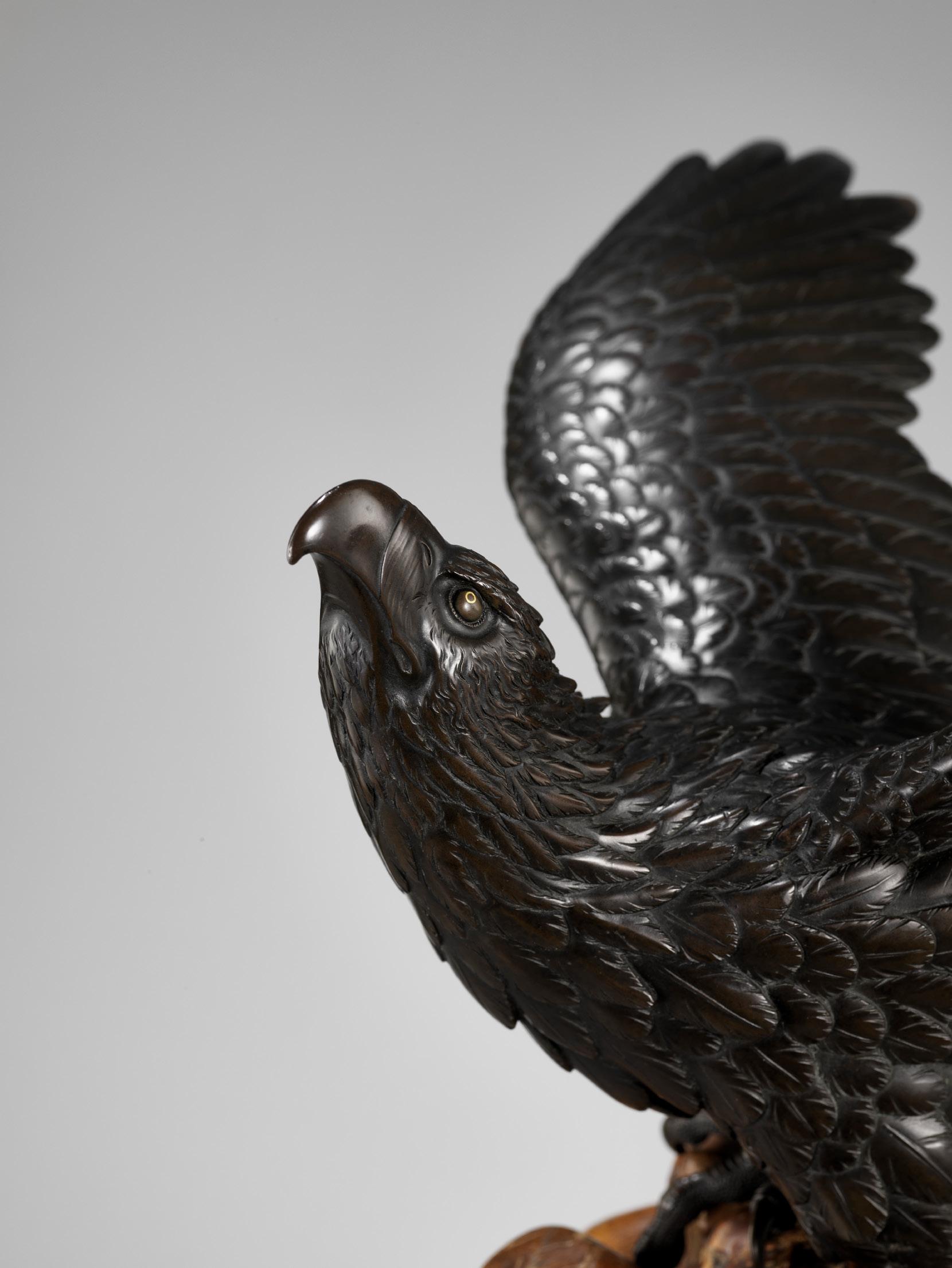
AN UNUSUAL BRONZE AND WOOD GROUP DEPICTING A HAWK ON A BIRDHOUSE


The hawk by Nojiri Hidechika for the Genryusai Seiya workshop, signed Hidechika and sealed Seiya chu Japan, Meiji period (1868-1912)
The majestic bird of prey naturalistically cast with finely incised plumage, ring-punched claws, elegantly curved beak, and gilt eyes with black pupils, perched on a gnarled branch atop the roof of a Japonisme hardwood lantern-form birdhouse, the roof decorated in gold and colored takamaki-e with aogai inlays to depict autumnal maple leaves borne on twisted vines, above the birdhouse with four intricately carved panels depicting phoenixes, framed by bands of key-fret, the stand and feet incised with stylized flowerheads and foliate scroll. Signed underneath the eagle HIDECHIKA and with seal mark SEIYA chu [by Hidechika, cast by the Seiya workshop].
HEIGHT 22.5 cm (the bird), 104.5 cm (total)
WEIGHT 3.92 kg (the bird), 9.32 kg (total)
Condition: The hawk’s feet with restorations and replaced screws, a loss to one claw, and traces of soldering. The stand with losses to inlays and lacquer, minor chips and scratches, expected age cracks. Provenance: French private collection.
Genryusai Seiya was a master craftsman in charge of a workshop specializing in export wares of the highest quality. Production included human genre figures, vases and exotic bronze models of animals probably influenced by the opening of Tokyo Zoological Gardens in 1882. The present piece is a brilliant example of Seiya’s naturalistic bronzes.
AUCTION COMPARISON:
Compare to a closely related bronze of an eagle, by Seiya, sold at Christie’s, Japanese and Korean Art, 16 September 2003, New York, lot 344 (sold for 6,573 USD).
Estimate EUR 6,000 Starting price EUR 3,000
162
86

87
ATSUYOSHI FOR THE MARUKI COMPANY: A MASTERFUL PORTRAIT BRONZE OKIMONO OF A STRIDING HORSE


By Miyabe Atsuyoshi for the Maruki company, signed Atsuyoshi saku and Maruki shachu sei Japan, Meiji period (1868-1912)
The horse mounted to a carved wood base, its posture imbued with movement, the mane and sweeping tail naturalistically modeled and heightened with fine incision work. The muscular body of the horse is superbly crafted, several bulging veins worked in low relief add to the superior realism of the bronze. Signed to the underside of the belly ATSUYOSHI saku [made by Atsuyoshi] and with a square seal MARUKI shachu sei [manufactured at the Maruki company].
HEIGHT 32 cm, LENGTH 37 cm WEIGHT 4,684 g
Condition: Excellent condition. Only very minor, expected wear. Miyabe Atsuyoshi, art name Ikkodo, is recorded in Wakayama Takeshi, Kinko Jiten (Dictionary of Metalworkers), Tokyo, Token Shunju Shinbunsha, 1999, p. 1141, as being a maker of sword fittings and a pupil of Shinoyama Tokuoki (1813-1891), active in Kyoto during the late Edo period and early Meiji era. Atsuyoshi is known for a number of finely modeled bronze studies of both wild and domesticated animals, almost all of them made for the Maruki Company.
The Maruki Company was active during the Meiji Period (18681912) in Japan, they stand out for the quality and weight of their okimono and are known for producing fine bronzes of animals.

AUCTION COMPARISON:
A related bronze okimono of a bear, bearing the same signature and mark and by Atsuyoshi for the Maruki company, was sold at Bonhams, Ancient Skills, New Worlds Twenty Treasures of Japanese Metalwork from a Private Collection, 12 September 2018, New York, lot 19 (sold for 21,250 USD).
Estimate EUR 6,000 Starting price EUR 3,000
164
88
KAKUHA: A FINE BRONZE OKIMONO OF A STRIDING BACTRIAN CAMEL
By Kakuha, signed Kakuha sei Japan, late 19th century, Meiji period (1868-1912)
Naturalistically modeled, walking forwards, the head raised, with shaggy fur and neatly detailed facial features. Signed within a square reserve underneath KAKUHA sei.
HEIGHT 24.6 cm WEIGHT 3,532 g
Condition: Very good condition, minor wear. Provenance: Old German private collection, acquired prior to 2007.
Kakuha Kanzaemon IX, real name Kakuha Zenjiro, was a member of a lineage of metalworkers from Toyama. In 1869, he started a branch office in the port of Yokohama for the export trade of bronze ware, also acting as a retailer for foreign clients in Japan.
AUCTION COMPARISON: Compare a closely related bronze of a Bactrian camel, by Seiya, sold at Koller, Asian Art, 3 June 2015, Zurich, lot 379 (sold for 4,500 CHF). Another closely related bronze of a camel, by Yoshihara, was sold at Sotheby’s, The Collection of Craig Wright, 30 September 2011, New York, lot 192 (sold for 5,938 USD).


Estimate EUR 3,000 Starting price EUR 1,500
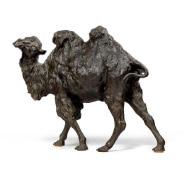
165
89
TSUDA EIJU: A BRONZE OKIMONO OF A SNAKE ON A ROCK
By Tsuda Eiju (1915-2001), signed Tsuda Eiju Japan, Showa period (1926-1989)
Well cast as a sinuous serpent writhing along a withered craggy rock, the eyes gilt, the bronze finely patinated to a warm copper tone. The flat base signed TSUDA EIJU.
LENGTH 19 cm WEIGHT 1,722 g
90
ISHIDA KAZUMASA: A FINE BRONZE ‘TOAD AND HYOTAN’ VASE

By Ishida Kazumasa (Issei), signed Kazumasa Japan, Meiji period (1868-1912)
Finely cast as a toad struggling to hold up a large double gourd, the frog’s skin naturalistically modeled, its eyes of gilt with shakudo pupils, the dark bronze patination of the frog providing an appealing contrast to the lighter bronze patina of the gourd. Signed in a recessed reserve KAZUMASA.
HEIGHT 28.8 cm WEIGHT 2,688 g
Condition: Very good condition, minor wear, light surface scratches, small casting flaws.
Condition: Excellent condition with minor wear. Provenance: Dutch collection.
With the original signed wood tomobako.
Tsuda Eiju (1915-2000) was a pupil and successor of Tsuda Shinobu (1875-1946). He showed his work at the special exhibition celebrating the 2600th anniversary of the imperial line, held in 1940, and won several prizes at the Nitten exhibition during the post-war period.
Estimate EUR 1,500 Starting price EUR 800
Ishida Kazumasa (Issei), given name Seiji, studied metal art in Takaoka, Toyama Prefecture. In the mid-Meiji Period, he went to Tokyo (Shimogaya district, Kamigyo, Tokyo) and worked in the metal art industry as a member of the Tokyo Chukin Kai (Tokyo Cast Metal Association). Ishida Kazumasa belongs to the Otake Norukuni line of metal crafting in Tokyo.
Estimate EUR 6,000 Starting price EUR 3,000
A bronze group of boys trapping birds by Ishida Kazumasa was exhibited in 1906 and was awarded a silver medal

166


Textiles, Paintings & Woodbock Prints Lots
109
91 to

AN EXCEPTIONAL AND VERY LARGE SILK EMBROIDERED ‘SEVEN DRAGON’ WALL HANGING

Japan, c. 1880, Meiji period (1868-1912)
The large tapestry finely embroidered in silk primarily in brown, cream, salmon, light blue, and black, with one large confronting dragon and six smaller dragons, all three-clawed, cavorting amid intricately defined clouds tufted in various shades of gray, beige, and blue silk threads, a magic pearl (tama) on the top.
SIZE 248 x 143 cm
Condition: Good condition with typical wear, minimal soiling, very few loose threads, minor losses.
The aesthetic of the present tapestry owes significantly to the Chinese Imperial design language of the Ming and Qing dynasties and the corresponding ceremonial tastes. Unlike most Chinese dragons, the Japanese version has only three claws, enabling the artist to make them larger and thus more threatening. Also, there are no metal-wrapped gold or silver thread embellishments present. The artist has relinquished the usage of such superficial decorations to instead ultimately focus on the dominance, not to say menacing appearance of the main confronting dragon. His portrayal is astounding in its sophistication and maturity. Its fierce countenance is imbued with a sense of agility and gravity. The dynamic depiction with its head facing the observer and three powerful open claws appears to be a variation of the forward-facing dragon found on blue and white ceramics developed from the Yuan period onwards.
The inspiration for this unusually striking example probably originated from Southern Song paintings such as those by Chen Rong (c. 1200-1266). Compare with two paintings in the Museum of Fine Arts, Boston, USA, the first titled Silongtu, ‘Painting of Four Dragons’, see the Museum of Fine Arts, Boston, accession no. 14.50. Also compare to a second painting by Chen Rong titled Jiulongtu, ‘Painting of Nine Dragons’, see the Museum of Fine Arts, Boston, accession no. 17.1697.
The dragon on the current tapestry is closely related to the dragons painted by Chen Rong in both style and spirit. The additional short spiky bristles in front of tufts of long flowing hair at the elbows of the dragon have not been seen on many occasions, but they do appear on Chen Rong’s dragons. Also, the dragons appearing in the Jiulongtu are each depicted with its neck flexed and tail extending, using the tension around the neck to indicate movement. The juxtaposition of tension and ease, movement and stillness, is akin to the confronting dragon depicted on the present tapestry.
Chen Rong’s dragons have been widely revered and imitated since the Song and Yuan periods, and the Xuande Emperor - as an avid art patron and competent artist - welcomed their influence on Imperial wares, which in turn were highly admired by Japanese artists of subsequent generations. Their ability to transition ancient Chinese painting techniques into different media, such as lacquer, wood carving, metal casting and tapestry, however, is unrivalled.

Another highlight on the current wall hanging is the scattered cloud scrolls. They have been strategically placed and shaped according to the space available, not only filling the voids but also being aesthetically pleasing. They are particularly creative, breaking up the otherwise monotonous symmetry of the seven dragons.
LITERATURE COMPARISON:
Compare a related silk hanging of a dragon, once hung in a Buddhist temple in Japan, of related size (270 x 178 cm), in the Victoria and Albert Museum, accession number T.132-1927.
Estimate EUR 15,000 Starting price EUR 8,000

170 91
Detail from the Jiulontu, ‘Painting of Nine Dragons’, by Chen Rong

92 A LARGE
FRAMED ‘CRANES’ SILK EMBROIDERY
Japan, Meiji period (1868-1912)
Finely embroidered in various shades of brown and cream, with black, red, and white accents, depicting five red-crested cranes wading through reeds near a river in a grove of leafy bamboo. With a brown brocade border, backed, and framed.

SIZE 190 x 134 cm (total) and 181.5 x 126 cm (image only)

AUCTION COMPARISON: Compare a closely related large, embroidered silk wall hanging with cranes, Meiji to Taisho period (1868-1926), of related size (195-124 cm), at Bonhams, Asian Works of Art, 16 March 2010, San Francisco, lot 8442 (sold for 3,660 USD).
Estimate EUR 4,000 Starting price EUR 2,000
172
Condition: Good condition, some wear, loose threads, and small tears. Provenance: British collection.
A SILK EMBROIDERED PANEL DEPICTING A PAIR OF JAPANESE CHIN DOGS

Japan, Meiji period (1868-1912)
Finely woven on a black-colored silk ground, the two long-haired dogs seated in obedient poses with attentive expressions, each wearing a ruffled collar, one red and the other blue.
SIZE 32 x 42.5 cm (image) and 44.4 x 54.5 cm (incl. frame)
Framed behind glass.
Condition: Very good condition, minor wear, some loose threads, very minor soiling.
The Japanese Chin, also known as the Japanese Spaniel, is a dog acknowledged for its importance to Japanese nobility. The dogs have a dot or a line on their forehead, which is associated with the touch of Buddha. While most believe that the source breed for the Japanese Chin originated in China, the route by which the Chin arrived in Japan is a widely debated topic. One story claims that the dogs were given to the Japanese royalty in AD 732 as gifts from the rulers of Korea. Others maintain that they were given as gifts to the Empress of Japan as early as the middle of the sixth century or by the seventh century.
AUCTION COMPARISON:


Compare a related embroidered panel depicting pointer dogs by Aiko, also dated to the Meiji period, at Bonhams, Fine Japanese Art, 6 November 2014, London, lot 217 (sold for 4,375 GBP).
Estimate EUR 4,000 Starting price EUR 2,000
Alexandra of Denmark with her Japanese Chin, named Punch, originally painted by Sir Luke Fildes in 1893

93
94
SESSON SHUKEI: A SCROLL PAINTING OF FUKUROKUJU
School of Sesson Shukei (1504-1589), signed Sesson Shukei with one seal Japan, 17th-18th century, early Edo period (1615-1868)
Finely painted in ink on paper, with a silk brocade frame and mounted as a hanging scroll, depicting the lucky god Fukurokuju holding with both hands a small scroll to his head, his mouth obscured but the eyes at least seemingly betraying an unusually serious expression, his cowl and wide sleeves rendered with bold, dynamic brushstrokes, the brows and beard are painted with dense brushwork, his nostril hairs with short lines, and the contours and wrinkles of his face with dynamic brushstrokes.

SIZE 110 x 50 cm (image) and 190 x 70 cm (total) Condition: Good condition with old wear, creasing, soiling, Provenance: German private collection.
Sesson Shukei (1504-1589) was a Japanese Zen monk and painter from the Muromachi period. He was born a member of the Satake clan, but left after being disinherited by his father and was inducted as a monk at Shoso-ji temple, the Satake bodaiji. Sesson was a master of ink painting, ranked with Sesshu Toyo, one of the greatest painters in Japanese history, and worked in a dramatic style that generally accentuated idiosyncrasy, humor, and exaggeration in his approach to subjects, whether figural or landscape.

MUSEUM COMPARISON: Compare a related painting of Jurojin by Sesson Shukei, 136.5 x 70.6 cm, in the collection of the Freer Gallery of Art in the National Museum of Asian Art, Smithsonian Institution, accession number F2015.6a-d. Also compare to a closely related painting of Daruma, School of Sesson Shukei, dated 17th-18th century, in the British Museum, accession no. 1913,0501,0.109.
Estimate EUR 4,000 Starting price EUR 2,000
174

175
95
A PAINTING OF SHOKI, MUROMACHI TO EARLY EDO

Japan,16th-17th century, Muromachi period (1333-1573) to early Edo period (1615-1868)
Depicting Shoki, dressed in a voluminous robe tightened at the waist with a band, holding a fine sword with elaborate handle in his right hand, the sheath hanging behind his back. The face with a fierce expression, framed by his bushy beard. Ink on paper. Framed behind glass.
Condition: Good condition with minor wear, some foxing, few wormholes, some creasing, and small tears at the edges, possibly few minor old repairs.
Provenance: German private collection.
SIZE 58.1 x 38.7 cm (image), SIZE 82 x 56 cm (incl. frame)
AUCTION COMPARISON: Compare to a related scroll painting of Shoki mounted on a horse, offered at Bonhams, The Ethereal Brush, 10 November 2016, London, lot 4 (estimate 30,00050,000 GBP)

Estimate EUR 1,500 Starting price EUR 800
Compare to a related scroll paiting of Shoki fighting a tiger, by Sesson Shukei (15041589), in the Kyoto National Museum, Japan

176
96
KOTO YOSHIN: A FINE KANO SCHOOL PAINTING OF ‘SCHOLAR READING A SCROLL’

By Koto Yoshin, signed Yoshin hitsu (Painted by Yoshin) and seals Yoho and Fujiwara Japan, 1830-1850
Remarkably detailed painting depicting a bearded scholar wearing voluminous robes and a prominent headdress, holding a fan in one hand, seated on a barrel stool at a table and reading a scroll unrolled before him. Ink on very fine silk. With a yellow silk brocade frame, laid down on board.
Condition: Good condition, as expected and commensurate with age. With old wear and traces of use, soiling, browning, foxing, creasing, small losses, minor touchups.
Provenance: From an English private collection.
SIZE 59 x 42.7 cm (image), SIZE 78 x 68.7 cm (incl. mounting)
Koto Yoshin (active 1830-1850), son of Koto Yozan (circa 1780-1846) of the Kano School painting. They were originally from Satsuma Province (in modern Kagoshima Prefecture) but settled in Edo. Both worked in the atelier of the Kobikicho branch of the Kano School painting. Koto Yoshin studied under his father and Kano Seisen’in Yasunobu (Kano Osanobu: 1796-1846), 9th head of the Kobikicho branch of the Kano School Painting, Edo (Tokyo).
As a customary practice carried out by the Kano School atelier, Koto Yoshin took part in various projects of copying Chinese paintings in famous collections, such as a painting of a bunch of wild narcissus flowers which was originally painted by the Chinese master painter Zhao Mengfu趙子昂 (1254-1322); the copy (dated 1843) by Yoshin is now in the National Museum of Tokyo collection.
A stack of books rests beside the scroll, a small censer on an incense stand (xiangji) as well as further scrolls, a lacquer box, various vessels, and other scholar’s objects on a high table behind a standing screen painted in magnificent quality with crashing waves, all behind a large curtain with floral roundels to the right side.
Estimate EUR 1,500
Starting price EUR 800
177
97
KANO YUSEN HIRONOBU: A KANO SCHOOL SILK PAINTING OF HORSES


By Kano Yusen Hironobu (1778-1815), signed Yusen Hogen ga, with seal Hironobu Japan, 1808-1815, Edo period (1615-1868)
Well painted in ink and watercolors on silk to depict eleven gamboling and grazing horses beside old gnarled trees, each animal neatly detailed, with a variety of poses and differently colored coats, some with spotted fur. With a silk brocade mounting and framed behind glass. Signed to the lower right YUSEN hogen ga, with red seal Hironobu.
SIZE 45 x 74 cm
Condition: Good condition with minor wear, soiling, and creasing. Provenance: Austrian private collection.
Kano Yusen Hironobu (1778-1815) was the fifth generation head of Hamacho branch of the Kano School. In 1808, he received the honorary title of Hogen. The artist is mentioned in Roberts, Laurance P. (1990) A Dictionary of Japanese Artists, p. 207.
AUCTION COMPARISON:
Compare a related painting of two horses by Kano Yasunobu (1613-1685), 113.3 x 135.5 cm, at Christie’s, Japanese & Korean Art, 11 September 2012, New York, lot 3 (sold for 3,000 USD).
Estimate EUR 1,500 Starting price EUR 800
178
98
BAISEN: A FINE PAIR OF KANO SCHOOL ‘FALCON’ SCROLL PAINTINGS
By Baisen (Umekawa), signed Baisen hitsu with seal Japan, 18th-19th century, Edo period (1615-1868)

Painted in ink and watercolors on silk, with a silk brocade frame, and mounted as a hanging scroll, each scroll depicting a falcon, one grooming, the other perched on a gnarly pine branch, its steely glare focused on the far distance, their eyes and feet accentuated in vibrant yellow colors. Each signed BAISEN hitsu [made by Baisen] and with two red seals.
SIZE 79.2 x 31.2 cm (image), 158 x 43.3 cm (incl. mounting)
Condition: Good condition, the images with few stains and some creasing, the mounts with creasing, few minuscule holes, small stains, and loose threads.
Provenance: French private collection.
With a wooden box, inscribed: “Baisen hitsu, taka no e, nifuku tsui, shigatsu nanoka, Chosai no shozou” [Painting by Baisen, a pair of hanging scrolls of hawks, collection of Chosai, 7th day in the fourth month].
MUSEUM COMPARISON: Compare a related scroll painting of an eagle by Kano Chikanobu, 17th-18th century, at the Metropolitan Museum of Art, accession number 36.100.7.

Estimate EUR 1,500 Starting price EUR 800

179

99
KISHI GANKU: A SUPERB AND VERY LARGE PAINTING OF A TIGER

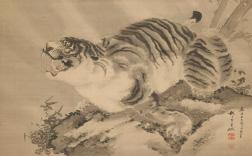
By Kishi Ganku (1749-1839), signed Echizen no kami Ganku with two seals, Ganku and Fuzen Japan, early 19th century, Edo period (1615-1868)
Finely painted with ink and watercolors on silk depicting a ferocious roaring tiger, seated on its haunches as it turns to one side, showing its sharp teeth, its tail raised in the air, the striped fur neatly rendered with needle-like brushstrokes, signed upper left Echizen no kami GANKU [Ganku, honorary governor of Echizen] with two seals, Ganku and Fuzen, both of which are art names of Kishi Ganku.
An unusually large and expressive painting by the great tiger painter Kishi Ganku (1749-1839), who was perhaps only rivaled by his contemporary Maruyama Okyo (1733-1795).
SIZE 177.5 x 108 cm (total) and 142 x 87.2 cm (image only)
Condition: Good condition with some wear, creasing, minor soiling. Provenance: French private collection.
With a silk brocade mounting and framed behind glass. The reverse with an old Japanese newspaper clipping, likely from a local newspaper published in Toyama Prefecture, describing Kishi Ganku as a painter famed for depicting the tiger, and a small label reading ‘Kanda Chihoko’, possibly from a previous owner.
Kishi Ganku (1749-1839) was a leading Japanese painter of Kyoto and founder of the Kishi school of painting. He is famous for his paintings of tigers. Ganku was born in Kanazawa as Kishi Saeki, studied painting styles including those of Chinese painter Shen Nanpin and the Maruyama-Shijo school, and arrived in Kyoto around 1780. By the late 18th century, Ganku’s paintings were appreciated by patrons that included the imperial family, leading to a position under Prince Arisugawa. His students included his son, Gantai (1782–1865), son-in-law Ganryou (1797–1852), adopted son Renzan (1804–59), Yokoyama Kazan (1784–1837), Shirai Kayou (fl. ca 1840–60), and Kawamura Bumpou (1779–1821). He was made honorary governor of Echizen (Echizen no kami) toward the end of his life.
MUSEUM COMPARISON: Compare to a closely related scroll painting of a tiger by Kishi Ganku, measuring 106.7 x 41 cm, in the Metropolitan Museum of Art, New York, Accession no. 6.100.11.
AUCTION COMPARISON: Compare a related scroll painting of a tiger by Kishi Gantai, a son of Kishi Ganku, measuring 84 x 113.7 cm, at Bonhams, Japanese Works of Art, 19 March 2009, New York, lot 308 (sold for 15,860 USD).
Estimate EUR 8,000 Starting price EUR 4,000
181
SCROLL PAINTING OF A TIGER, SCHOOL OF MARUYAMA OKYO

Inscribed Kamei and sealed Anagura and Kameisai Japan, Kyoto, late 18th – early 19th century, Edo period (1615-1868)
Finely painted in ink and watercolors on silk, with a silk brocade frame and mounted as a hanging scroll, depicting a tiger standing foursquare on a rocky slope, with brown leaves and twisted vines and roots in the background, as well as bamboo leaves below the tiger, calling to mind the popular motif take no tora (tiger in bamboo). The tiger’s striped fur is neatly detailed and both its large side-glancing eyes and dynamic pose suggest a certain mischief to the mysterious animal.
Inscribed and signed center right, ‘KAMEI shujin, Heian shuchikuro chu ni oite utsutsu’ (‘Painted by Master Kamei, at the Shuchikuro Studio, Kyoto’).
SIZE 103 x 51 cm (image) and 178 x 67 cm (total)
Condition: Very good condition with minor wear, creasing, little soiling, the brocade frame with few minuscule losses to edges.
Provenance: From a private collection, Illinois.
Although there is no information available about this artist, it is likely that he was a follower of Maruyama Okyo (1733-1795). The name Kamei literally means ‘Turtle Abode’. Maruyama Okyo and his students painted numerous paintings for the Daijoji Temple, whose mountain name (sango) is Kamei Temple (also known as Okyo Temple); the commission was carried out at the Okyo’s studio in Kyoto, though the Kamei Temple (Okyo Temple) is located in nearby Hyogo.
Tiger imagery has a long history in East Asia. Tigers were frequently paired with dragons— the tiger representing the ‘male’ principle, the yin to the female ‘yang’ of the dragon, ancient cosmological symbols. Tigers are also commonly paired with bamboo, which is known as take no tora, or ‘tiger in bamboo’, and has many different interpretations; the tiger has a strong nature, is flexible and resilient like the bamboo, but it is also said that the strong tiger is looking for shelter underneath the bamboo, as any earthly power is inferior to the forces of nature. Moreover, the tiger and bamboo represent the power of faith in Buddhism.
AUCTION COMPARISON: Compare a closely related painting of a tiger, described as “School of Maruyama Okyo”, 104 x 15.5 cm, at Christie’s, Japanese & Korean Art, 23 March 2011, New York, lot 879 (sold for 10,000 USD).
Estimate EUR 3,000 Starting price EUR 1,500

182 100
A FINE
101
A FINE MORI SCHOOL SCROLL PAINTING OF TWO MONKEYS ON A PINE TREE

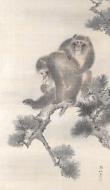
School of Mori Sosen (1747-1821), with two seals, one reading Tadamichi 忠道 Japan, 19th century, Edo period (1615-1868)
Finely painted in ink and watercolors on silk, with a silk brocade frame, and mounted as a hanging scroll, depicting two monkeys clambering a gnarly pine branch, playfully looking at each other. Two red seals to the bottom right. The reverse with an inscribed Japanese label ‘Tadamichi, Monkeys’. With ivory jiku (roller ends).
SIZE 95.5 x 36 cm (image), 172.9 x 43.3 cm (incl. mounting)
Condition: Very good condition, the image with few minuscule stains and minor creasing, the mounts with some foxing, stains, few creases, and little browning. Provenance: French private collection.
Mori Sosen (1747-1821), the founder of the Mori painting School, was active in Osaka at the end of the Edo period and came to be known as the ‘Monkey Painter Sosen,’ and he is renowned even today for his monkey paintings. Like his contemporary Maruyama Okyo, Sosen created works based on sketches from life as is finely exemplified by the painting presented here, where the artist has beautifully captured the realism of the details of the animals’ soft fur in the refined delicacy of the brushstrokes.
MUSEUM COMPARISON:
Compare a closely related scroll painting of two monkeys on a pine branch by Mori Sosen, in the British Museum, museum number 1881,1210,0.2279.
AUCTION COMPARISON:
Compare a closely related scroll painting of two monkeys on a pine branch by Mori Sosen, at Bonhams, Fine Japanese Art, 11 May 2010, London, lot 132 (sold for 15,600 GBP).
Estimate EUR 2,000 Starting price EUR 1,000

183




184
102
URAGAMI SHUNKIN:
A 14-METER HANDSCROLL WITH BIRDS AND FLOWERS, DATED 1836 BY INSCRIPTION
By Uragami Shunkin (1779-1846), signed Uragami Shunkin Japan, dated 3 August 1846



Finely painted with ink on paper, depicting various birds and flowers, including sparrows below willow trees, paradise flycatchers, cherry blossoms, magnolias, magpies, starlings, a cuckoo on a pine branch, water chestnut trees and kingfisher, as well as wagtails and asters. Inscribed with a title, Kacho ga, dated 3 August 1836, sealed Kisennoin and Shunkin Koji, and signed URAGAMI SHUNKIN.
LENGTH 14.1 m, WIDTH 27.4 cm
Condition: Very good condition with minor wear, soiling, and creasing.
Provenance: The collection of Teddy Hahn (1933-2012), thence by descent. Theodor “Teddy” Hahn was a well-known and respected collector of netsuke and other Asian works of art. After spending time in museums to study the early cultures of the world, finding particular interest in their sculptures, he began collecting, remarking, “I somehow knew it would have a profound influence on my life. How right I was. And how happy I have been.”

Uragami Shunkin (1779-1846) was a Japanese nanga (literati) painter who lived during the late Edo period. He was born in Bizen Province (present-day Okayama Prefecture) as the first son of Uragami Gyokudo, who was a samurai for the Ikeda daimyo at the time. He learned painting and calligraphy from his father when he was a child. Around 1792, the art dealer Nyoi Dojin began buying Gyokudo’s as well as Shunkin’s works. Uragami Shunkin later settled in Kyoto, establishing himself as a Literati painter conversant in the related arts of poetry, calligraphy, and playing the koto, the musical instrument that had been one of his father’s fortes. Shunkin, who was active in the intellectual and literary circle of Rai Sanyo (1780–1832) and others in Kyoto, also achieved a reputation as a connoisseur of antique paintings, calligraphies, inkstones, and metalwork, all of which he collected himself.
AUCTION COMPARISON:
Teddy Hahn (1933-2012)
With a wood storage box inscribed Kacho Shunkin hitsu, Uragami Shunkin Kacho zu maki, Tenpo Heiko hitsu.

Compare a smaller handscroll attributed to Uragami Shunkin depicting scholar’s rocks, 24.6 x 492.5 cm, at Bonhams, 25 June 2019, San Francisco, lot 311 (sold for 5,075 USD).
Estimate EUR 4,000 Starting price EUR 2,000
185



186
103
A RARE NANBAN SIX-PANEL BYOBU SCREEN DEPICTING THE ARRIVAL OF A PORTUGUESE SHIP


Japan, 18th-19th century, Edo period (1615-1868)
Finely painted in ink, watercolors, and gold on paper to depict a Portuguese ship arriving at the port of Nagasaki. The ship is filled with passengers and sailors, some of which perform acrobatic feats as they prepare to dock. A number of smaller boats are approaching land as well, while two boats which are heavily filled with goods are departing. A group of Portuguese men are carrying large boxes and leading a spotted deer toward a bridge, one of the men appears to shrug as he tries to communicate with two Japanese men. The two rightmost panels show a chaotic scene of numerous Japanese and Portuguese men carrying goods in all directions, as well as a fenced terrace with Portuguese noblemen seated at a table and enjoying tea and wine. The screen is further decorated with thick, goldsprinkled clouds.
SIZE (when opened) 88 x 259 cm
Condition: Good condition with some wear, minor soiling, occasional light scratches, and few small losses.
The scene presents a narrative of the dynamic conflation of East and West around 1600. Portuguese traders reached Japan in 1543, and by 1570 they had selected the Bay of Nagasaki as the ideal natural harbor for the center of their commerce, which was conducted with little or no restriction. The Portuguese nau do trato was known to the Japanese as the kurofune (black ship) or nanban bune, ship of the Nanban, or Southern Barbarians, so called because these foreigners arrive from the south. (The term originated in China, where all foreigners were regarded as barbarians.)
The Portuguese made large profits selling Chinese silk to the Japanese in exchange for silver. Some European goods were traded, but for the most part the Iberians served as middlemen between the Chinese and Japanese. The great ship was a three-deck carrack of up to 1,600 tons, and its enormous size and exotic crew and cargo were the cause of much wonder and excitement.
The earliest screen of this type is thought to date from the 1590s and is attributed to Kano Mitsunobu (1561/5–1608), who was called from Kyoto to decorate Hideyoshi’s Nagoya Castle in northern Kyushu. Mitsunobu may have traveled to Nagasaki to observe the “Southern Barbarians” first hand. The fad for Nanban screens continued into the second quarter of the seventeenth century. The novel subject fascinated the Japanese, and the Kano-school atelier as well as other professional painting studios in Kyoto made numerous versions in the early seventeenth century for clientele prepared to enjoy the strange costumes and odd physiognomy of these tall, hairy and longnosed Southern Barbarians, a throwback to the outlandish imagery familiar from the iconography of Daoist immortals.
Museum comparison: Compare to a related pair of Nanban screens, dated to the first quarter of the 17th century, in the Metropolitan Museum of Art, New York, accession no. 2015.300.109.1, .2.
AUCTION COMPARISON:
Compare to a related important Namban screen, dated to the 17th century, sold at Christie’s, European Courts Encounter Japan, 11 May 2015, London, lot 8 (sold for 818,500 GBP).
Estimate EUR 8,000 Starting price EUR 4,000
187
AN IMPRESSIVE PAIR OF SIX-PANEL BYOBU SCREENS DEPICTING A DOG-CHASING EVENT (INOUMONO)
Japan, 18th century, Edo period (1615-1868)
Finely decorated with ink, watercolors, and gold foil on paper to depict a large dog-chasing event (inoumono) watched by numerous spectators standing outside the fenced area, along with street vendors and entertainers as well as other contestants, amid gnarled pine and maple trees, as horse-mounted archers chase dogs of all stripes and colors, pointing their large padded arrows at the fleeing canines, with some dogs held by leashes by attendants on foot, including two attendants and three dogs resting under a tree as the chaotic scene unfolds, framed by thick clouds.
SIZE 171.8 x 63.5 cm (each panel) and SIZE (when opened) 171.8 x 367 cm
Condition: Very good condition with minor wear and little soiling, some expected tears and creases, the wood screen with minor nicks and scratches and some old repairs.
Provenance: From the collection of L. Harrison Bernbaum, Chicago, Illinois, USA. L. Harrison Bernbaum is a Chicago businessman who co-founded the outdoor company High Sierra with his father Harry Bernbaum (1917-2015), who had been one of the first American businessmen to travel to Japan in 1956, helping to pioneer manufacturing relationships between America and Japan for the American sporting goods industry.
With a silk brocade frame and mounted to a brown-lacquered screen with parcel-gilt fittings decorated with blossoming flowers and foliate scroll.
Shooting dogs from horseback was a form of samurai training that began in the Muromachi period (1392–1573). During the peaceful 1600s this activity was revived as a samurai sporting event that attracted many spectators. As a sport, dog chasing involved two teams of seventeen participants each. The riders used softly padded arrows in order not to seriously hurt the dog, which was released within a circle of rope to begin the game. A strike on the dog‘s torso scored points; strikes on the head or legs did not count. The winning team usually received prizes of lengths of white silk cloth. The present screen shows the game in progress, with the judges sitting in the building at the left of the field. As many as eighteen pairs of screens on this subject are known in Japan and the West. Later examples, such as this pair, show greater numbers of spectators, probably reflecting the growing popularity of the sport.
LITERATURE COMPARISON:
Compare a closely related six-panel folding screen, also depicting a dogchasing event, dated approx. 1640, in the collection of the Asian Art Museum of San Francisco, object number B60D1.
AUCTION COMPARISON:
Compare a closely related single sixpanel folding screen, also depicting a dog-chasing event, dated 17th-18th century, 171.5 x 370.8 cm, at Bonhams, Fine Japanese Works of Art, 19 March 2014, New York, lot 3098 (bought-in at an estimate of USD 20,000-30,000).

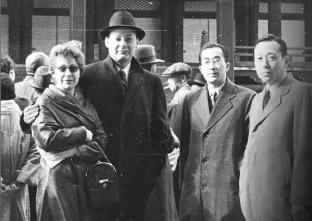
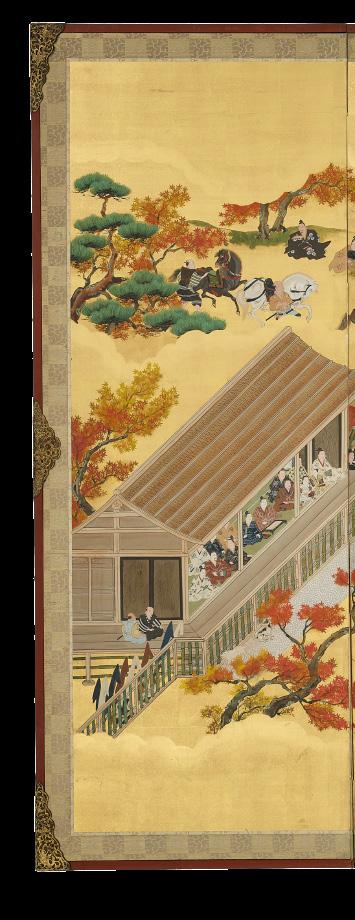
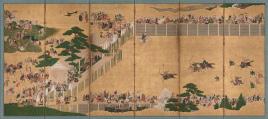

Estimate EUR 15,000
Starting price EUR 8,000
188 104
Harry Bernbaum and his wife, Harriet, on a buying trip to Japan in the 1950s


189




190
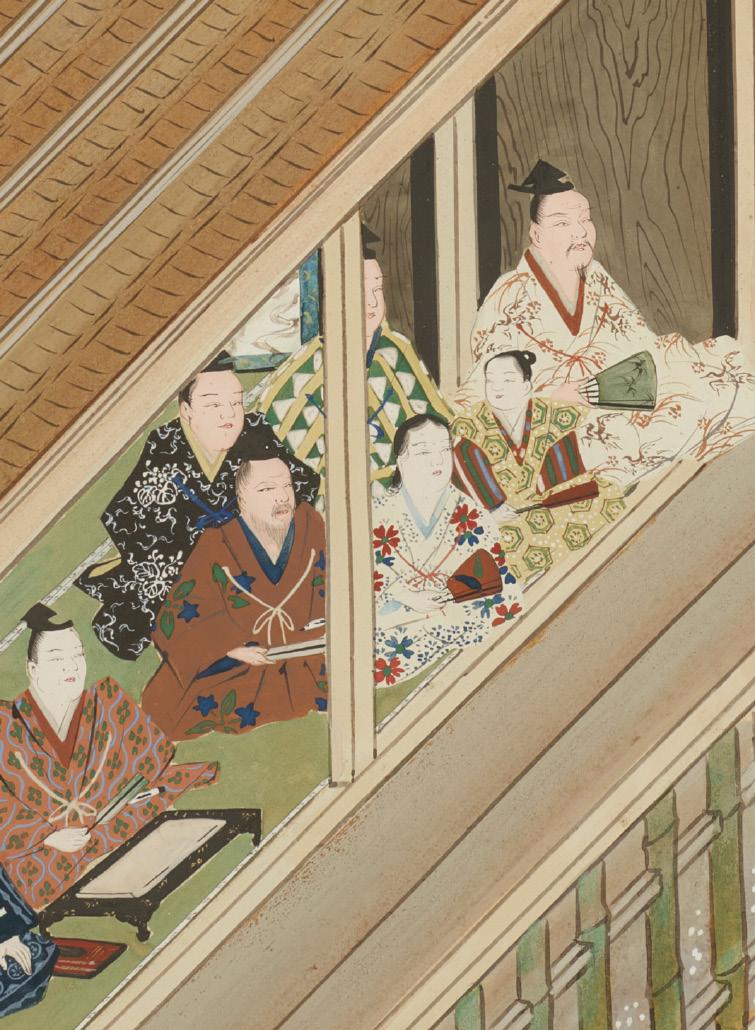



191
105
A PAIR OF FINE SIX-PANEL BYOBU SCREENS DEPICTING SPARROWS AND BAMBOO




Japan, 19th century, Edo period (1615-1868)
Each finely decorated with ink, watercolors, and gold foil to depict sparrows amid thickly growing bamboo and wispy clouds, further painted with flowers growing from craggy rocks and swirling streams and ponds, all within a silk brocade frame and mounted to a black-lacquered wood screen with partly gilt metal fittings with incised and ring-punched decorations. The many birds are meticulously painted, each neatly detailed and slightly different from the others. The bamboo stalks have also been given close attention by the artist, with many segments having turned yellow to brown. Note also the fine gold foil technique and clouds.
SIZE (each when opened) 177 x 377 cm
Condition: Very good condition with minor wear, little soiling, occasional light scratches, and few minuscule losses. Provenance: Dutch collection.
Estimate EUR 20,000 Starting price EUR 10,000
192


193
106
A FINE SIX-PANEL BYOBU SCREEN DEPICTING CRANES AND PINES

Japan, 19th century, Edo period (1615-1868)
Finely decorated with ink, watercolors, and gold foil to depict a dense forest of neatly detailed gnarled pine trees divided by a stream in which four red-capped cranes are frolicking, one preening itself, another looking for fish in the water, a third with its head raised toward the sky, all within a silk brocade frame and mounted to a black-lacquered wood screen with gilt metal fittings with incised and ring-punched decorations. Note the fine gold foil technique used to depict both the ground and cloudy sky.
SIZE (when opened) 171.8 x 367 cm
194
Condition: Very good condition with minor wear, little soiling, occasional light scratches, and few minuscule losses.
Provenance: Dutch collection.
The crane is one of the most prominent symbols of longevity and good fortune in Asia. For at least two millennia, the Chinese have viewed them as living to a great age and as being able to navigate between heaven and earth. In turn, these attributes have made them logical companions of sennin, the Taoist Immortals. The redcrowned, or Japanese, crane depicted in this painting is said to live for 1,000 years.
Pine is an auspicious symbol in Japan, representing longevity due to its long life, and endurance as it remains green throughout the winter months. The pine trees depicted in this painting introduce a freshness and liveliness which complements the spirited movements of the cranes.
AUCTION COMPARISON:
Compare a related six-panel screen with cranes and pine, dated 18th century, 107 x 273 cm, at Christie’s, 28 July 2015, London, lot 1 (sold for 12,500 GBP). Compare a related sixpanel screen with cranes, dated 18th century, 178.8 x 373 cm, at Christie’s, 8 December 2016, London, lot 111 (sold for 50,000 GBP).


Estimate EUR 6,000 Starting price EUR 3,000

195
UTAGAWA YOSHITSUYA: A COLOR WOODLOCK PRINT TRIPTYCH DEPICTING KOGAKURE NO KIRITARO, DATED 1861
 By
By
Utagawa Yoshitsuya (1822-1866), signed Ichieisai Yoshitsuyaga ga Japan, dated 1861
A fantastic scene of the warrior Kogakure no Kiritaro using witchcraft to hide himself from three men attacking his palanquin. An enormous snake emerges in a cloud of smoke from the palanquin window, with Kiritaro riding atop its back at left, his hands clasped in a magical gesture as he casts a spell. The serpent bares its fang as a line of rats comes scampering out of his mouth, running across the scene. In the center, Waniguchi Jinsuke falls back on one knee, flinging his hand out at his side as he glares up at the creature. At right, his companions Masakino Torazo and Kazama Hanjiro watch with alarmed grimaces. Pine trees frame the dark night sky and a swirl of leaves is swept through the air.

OBAN 36 x 23.5 cm (each print)
Condition: Excellent condition, very good impression, fresh colors. Provenance: French private collection.
The present triptych is from the series Kyokyaku Suikoden no uchi (Shuihuzhan of the mirror) and is titled Kogakure no Kiritaro yojyutsu o motte tsugata o kakusu (Kogakure no Kiritaro hides himself using witchcraft). The series was published by Kameya Iwakichi between 1861 and 1863. This triptych is dated to the sixth month of 1861.
Utagawa Yoshitsuya (1822-1866) was a Japanese designer of ukiyo-e woodblock prints. Yoshitsuya was a student of Utagawa Kuniyoshi and, like his teacher, is best known for his woodblock prints of warriors.
AUCTION COMPARISON: Compare another example of this triptych by Utagawa Yoshitsuya at Christie’s, Japanese and Korean Art, 20 September 2022, New York, lot 258 (sold for 5,292 USD).
Estimate EUR 4,000 Starting price EUR 2,000
196
107
108
UTAGAWA KUNIYOSHI: A RARE COLOR WOODBLOCK PRINT TRIPTYCH DEPICTING TADATSUNE SLAYING A GIANT BOAR
By Utagawa Kuniyoshi (1797-1861), signed Ichiyusai Kuniyoshi ga Japan, published 1847-1853
Depicting Nitta Tadatsune slaying a giant boar, which has already been hit by several arrows, during the grand hunting event Fuji no Makigari arranged by shogun Minamoto no Yoritomo in 1193 at the foot of Mount Fuji. The scene is quite chaotic, with fleeing animals chased by mounted archers and the shogun’s gokenin (retainers) with their beaters, all amid gnarled pine trees. Signed ICHIYUSAI KUNIYOSHI, with double nanushi censor seals. The print was published by Joshuya Kinzo between 1847 and 1853. Matted and framed.
109
UTAGAWA KUNIYOSHI: A COLOR WOODBLOCK PRINT OF BENKEI FIGHTING A GIANT CARP
By Utagawa Kuniyoshi (1797-1861), signed Ichiyusai Kuniyoshi ga Japan, early 19th century, Edo period (1615-1868)
The young warrior-monk wrestling a giant carp that had eaten its mother, engulfed in a crashing wave, a stern expression on his face as he subdues the huge fish.
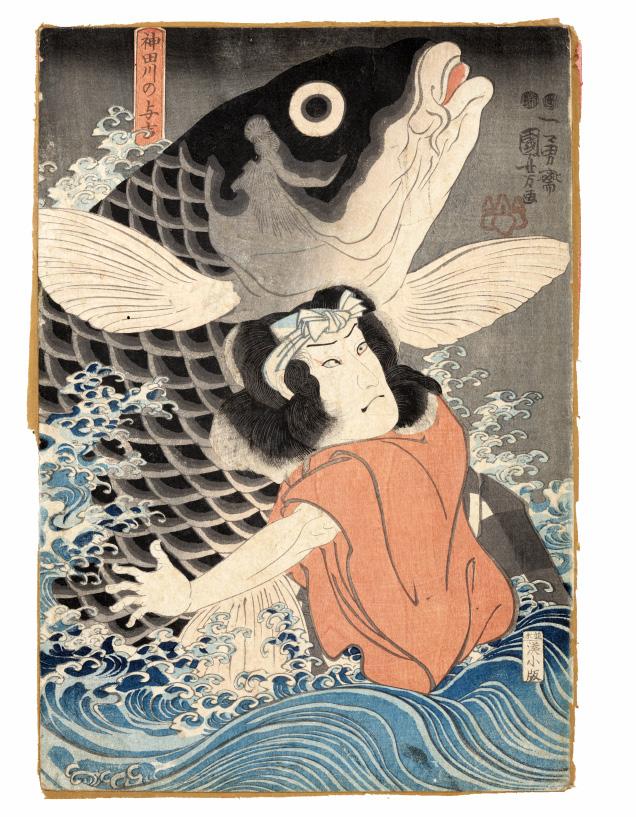
OBAN 36 x 25 cm
Condition: Good condition, color, and impression. Minor soiling. Small tears and losses around the edges.
Provenance: Austrian private collection.
AUCTION COMPARISON:
Compare a closely related woodblock print by Utagawa Kuniyoshi at Bonhams, 12 May 2022, London, lot 382 (sold for 6,375 GBP).

Estimate EUR 1,000
Starting price EUR 500
OBAN 36.2 x 24.6 cm (each print)
Condition: Good condition, color, and impression. Minor soiling and creasing.
Provenance: From a Canadian private collection. The reverse with a handwritten note.
AUCTION COMPARISON: Compare a closely related triptych woodblock print by Utagawa Kuniyoshi, depicting Doji Yoshiharu overthrowing a giant boar in the forest, at Christie’s, 22 June 2017, London, lot 112 (sold for 2,000 GBP).

Estimate EUR 2,000 Starting price EUR 1,000



Cloisonné, Ceramic & Porcelain Lots 110 to 121
110
A FINE CLOISONNÉ KORO (INCENSE BURNER) AND COVER, STYLE OF HAYASHI KODENJI Japan, Nagoya, late 19th century, Meiji period (1868-1912)



The compressed globular body supported on three short feet and rising to a short waisted neck with galleried rim, the shoulder flanked by two foliate handles with incised decoration. Finely worked in silver wire and bright enamels, the black ground decorated with two shaped panels enclosing garden scenes depicting birds and flowers, flanked by wide bands with stylized butterflies, flowerheads, and foliate scroll, further with diapered and tasseled bands, the feet with fierce beast heads, the en-suite cover with a lotus knop finial, the rims and interior gilt.
HEIGHT 12.8 cm, WIDTH 17 cm (across handles) WEIGHT 598 g
Condition: Excellent condition with minor wear. Provenance: British collection.
AUCTION COMPARISON: Compare to a closely related koro and cover, attributed to a Nagoya workshop, sold at Bonhams, Fine Japanese Art, 17 May 2018, London, lot 508 (sold for 6,250 GBP).
Estimate EUR 6,000 Starting price EUR 3,000
200


111
ANDO: A CLOISONNÉ ENAMEL VASE DEPICTING PHEASANTS AND CHRYSANTHEMUMS

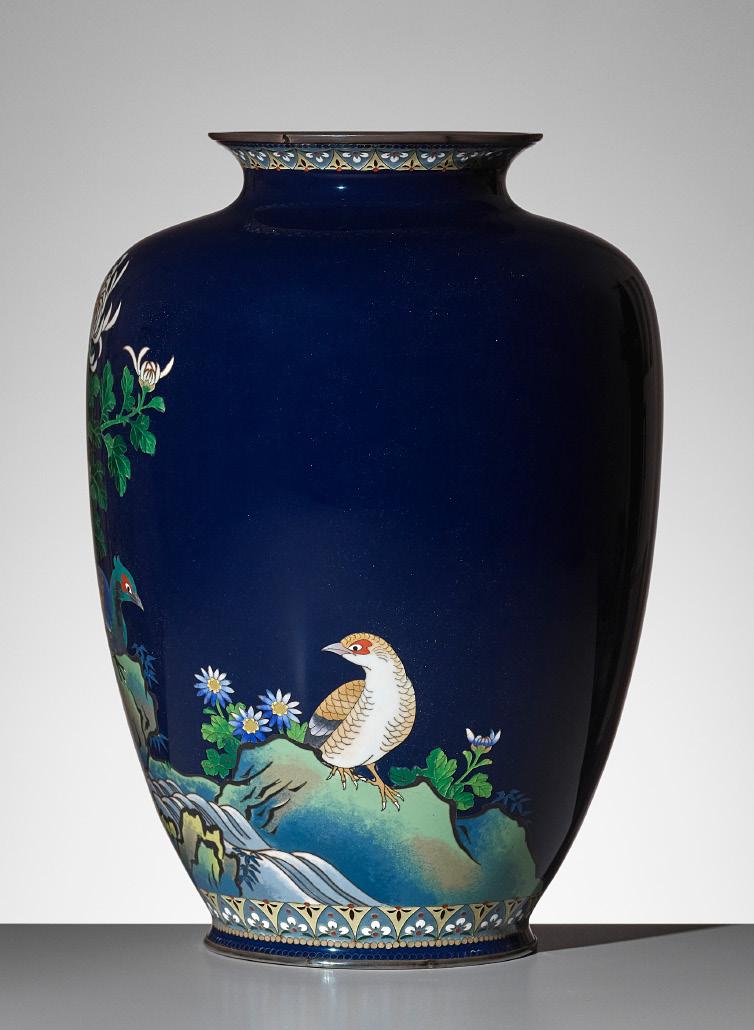
By the Ando company, signed with the Ando company mark Japan, Nagoya, early 20th century, Meiji (1868-1912) to Taisho period (1912-1926)
The broad baluster body supported on a short spreading foot and rising to a waisted neck with flared rim, the sides finely decorated in bright enamels with two pheasants on a rocky outcrop, a stream running between them, amid large leafy chrysanthemums, daisies, and other flowers, all against a deep-blue ground, with floral diapered bands below the rim and above the foot. The rims of silver, the foot rim with a two-character mark ‘jungin’ (pure silver), and the base with the Ando company mark.
HEIGHT 24.2 cm (excl. stand)
WEIGHT 1,100 g (excl. stand)


Condition: Excellent condition with minor wear and minimal manufacturing irregularities.

Rear-Admiral Reginald Vesey Holt, 1937, National Portrait Gallery, London
(1883-1958)
Provenance: From the collection of Vice-Admiral Reginald Vesey Holt, CB, DSO, MVO, and thence by descent. The vase was gifted to Vice-Admiral Holt by Admiral Koshiro Oikawa, the Japanese Naval Minister during World War II, as commemorated by the silver plaque on the wood stand. The wood stand further with remnants of an original Ando company label to the base. Koshiro Oikawa (18831958) was an admiral in the Imperial Japanese Navy and Naval Minister during World War II. Oikawa was appointed as Minister of the Navy in the second and third cabinets of Prime Minister Fumimaro Konoe between 5 September 1940 and 18 October 1941. While Navy Minister, he strove to maintain ties with the United States, and instructed his naval attachés in Washington DC to work together with the Japanese ambassador to prevent war from breaking out. He continued to serve as Naval Councilor until near the end of World War II and was Chief of the Navy General Staff in late 1944 but resigned in May 1945. ViceAdmiral Reginald Vesey Holt, CB, DSO, MVO, (1884-1957) was an officer in the Royal Navy. He commanded a considerable number of destroyers and torpedo craft during World War I. Holt was promoted to the rank of Vice-Admiral on 15 December, 1939. He was placed on the Retired List at his own request on 4 May, 1940.
AUCTION COMPARISON: Compare a closely related cloisonné vase by the Ando workshop, dated Taisho period (1912-1926), 30.8 cm high, at Bonhams, Fine Japanese and Korean Works of Art, 18 March 2015, New York, lot 3166 (sold for 3,250 USD).
Estimate EUR 4,000
Starting price EUR 2,000
203
The finely carved and openworked wood stand fitted with a silver commemorative plaque inscribed, ‘Vice-Admiral R.B. [sic] Holt. January 1940. From K. Oikawa, Admiral I. J. Navy’, and incised with a symbol of an anchor and prunus blossom
Koshiro Oikawa
112 KINZAN: A CLOISONNÉ ENAMEL SQUARE TRAY WITH COCKEREL AND HEN


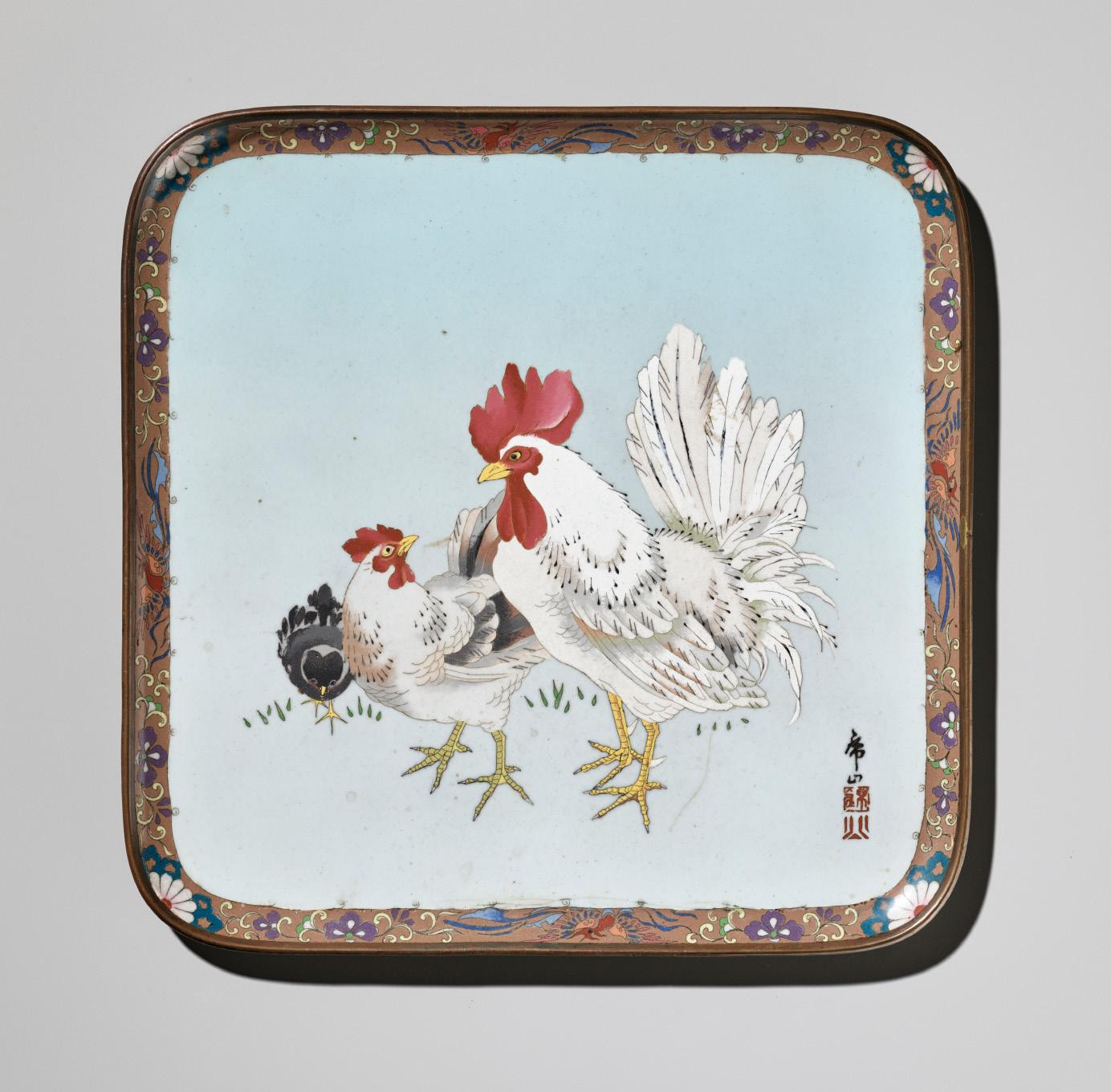
By the Kinzan company, signed Kinzan and with seal Kinzan Japan, late 19th - early 20th century, Meiji period (1868-1912)
Of rounded square form, the design after a painting by Watanabe Seitei (1851-1918), worked in copper wire with a cockerel, hen, and chick against a pale-blue ground, bordered by a band of halfchrysanthemum blossoms and stylized tendrils on a brown ground, the underside decorated with a large peony blossom issuing tendrils above a blue ground, signed KINZAN with a two red seals KINZAN.
SIZE 27.9 x 27.9 cm WEIGHT 1,302 g
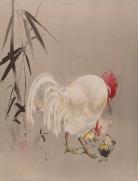
Condition: Good overall condition, some wear, manufacturing flaws including pitting, small hairlines, few minor losses to the enamels, light surface scratches.
Provenance: From a private collection, Zagreb.
LITERATURE COMPARISON: The design of the present object is inspired by a painting of rooster and hen with chicks by Watanabe Seitei, a famous artist of the Meiji period (1868-1912), who worked closely with Namikawa Sosuke. Compare a related painting of rooster and hen with chick by Watanabe Seitei, circa 1887, in the Metropolitan Museum of Art, accession number 14.76.61.54.
AUCTION COMPARISON: Compare a closely related square tray with near-identical motif by Kinzan, of closely related size (27.6 x 27.5 cm), at Bonhams, Polish and Poise Japanese Art Across the Centuries, 12 May 2022, London, lot 220 (sold for 2,805 GBP). Compare a related square tray with near-identical motif, attributed to Namikawa Sosuke, 19th century, at Christie’s, Innovative Japanese Design: Art of the Meiji Period, 18 November 2015, New York, lot 10 (sold for 13,750 USD).
Estimate EUR 1,500 Starting price EUR 800
113
A FINE CLOISONNÉ ENAMEL TRAY DEPICTING MOUNT FUIJI IN THE STYLE OF NAMIKAWA SOSUKE

Japan, Meiji period (1868-1912)
Of oval form, the shallow rounded sides finely decorated to the interior in musen (wireless) enamels with a view of the snowcapped Mount Fuji in the mist and to the base in copper wire with bamboo leaves, chrysanthemum roundels, stylized flowerheads, and scrolling vines against a turquoise-blue ground.
LENGTH 18.4 cm
WEIGHT 266.3 g
Condition: Excellent condition with minor wear and manufacturing irregularities.
Provenance: The Strong National Museum of Play, accession number 76.2503 (lacquered to the base). Margaret Woodbury Strong (1897-1969) grew up in a prosperous family of collectors. Her interests ranged so widely that by 1960 she had amassed more than 27,000 collectible items and works of art. The vast majority of her collections related in some way to play and as her accumulation grew, Margaret planned a museum to house her collection. It eventually opened to the public in 1982, and grew dramatically over the following decades, expanding its collections, facilities, and resources, now spanning over 285,000 square feet. Today, the Strong National Museum of Play (known as just The Strong Museum or simply The Strong) is the only collections-based museum in the world devoted solely to the study of play.


AUCTION COMPARISON: Compare to a tray by Namikawa Sosuke sold at Bonhams, Fine Japanese Art, 12 May 2011, London, lot 179 (sold for 22,800 GBP).
Estimate EUR 2,000 Starting price EUR 1,000

205
114 A FINE CLOISONNÉ FOUR-PANEL TABLE SCREEN DEPICTING BIRDS AND FLOWERS
Japan, early 20th century, Meiji period (1868-1912)
The hinged gilt-metal panels finely worked in silver wire and bright enamels to depict five birds, three in flight and two perched on branches of blossoming leafy trees growing from a rocky outcrop above crashing waves, all against a black ground, the silver backs engraved in katakiri with flying cranes and Mount FujI.


SIZE 18.4 x 32.7 cm WEIGHT 977 g

Condition: Very good condition with some wear, the backs with light surface scratches.
Provenance: The Strong National Museum of Play, accession number 76.2396 (lacquered to reverse of one panel). Margaret Woodbury Strong (1897-1969) grew up in a prosperous family of collectors. Her interests ranged so widely that by 1960 she had amassed more than 27,000 collectible items and works of art. The vast majority of her collections related in some way to play and as her accumulation grew, Margaret planned a museum to house her collection. It eventually opened to the public in 1982, and grew dramatically over the following decades, expanding its collections, facilities, and resources, now spanning over 285,000 square feet. Today, the Strong National Museum of Play (known as just The Strong Museum or simply The Strong) is the only collections-based museum in the world devoted solely to the study of play.
Estimate EUR 1,500 Starting price EUR 800
206
Margaret Woodbury Strong (1897-1969)
A SUPERB PLIQUE-À-JOUR ‘FLOWERS’ BOWL

Japan, Meiji period (1868-1912)
The deep rounded sides supported on a short, splayed foot, applied with silver rims, delicately worked in silver wire and translucent bright enamels in shades of red, violet, yellow, green, light blue, orange and brown against a bubble suffused ground, with numerous flowers borne on leafy vines, including chrysanthemum, peony, magnolia and plum.
DIAMETER 11.1 cm WEIGHT 130 g
Condition: Remarkably good condition, minor typical wear. Provenance: Norwegian private collection.
Plique-à-jour, known as shotai-shippo in Japan, came to Japan via France around 1900.

AUCTION COMPARISON: Compare a closely related plique-à-jour bowl with floral design, late 19th century, at Christie’s, Masterful Exuberance, Artistic Craftsmanship of Imperial Japan: The Property of a Lady, 18 May 2012, London, lot 241 (sold for 2,000 GBP). Compare a closely related plique-à-jour bowl with floral design, late 19th century, at Christie’s, The Avo Krikorian Collection: Innovation and Inspiration of Meiji Period Design, Geneva, 19 February 2007, lot 114 (sold for 2,160 CHF).
Estimate EUR 1,500 Starting price EUR 800

207
115
A HIRADO WHITE-GLAZED MINIATURE OKIMONO OF A SHISHI
Japan, 19th century
Finely modeled as a shishi seated on its haunches with one front paw resting on a neatly incised brocade ball, the lion further detailed with curled mane, beard, and tail and floppy ears, covered overall in a soft ivory-white glaze save for the underside.

LENGTH 5.4 cm
Condition: Excellent condition with minor wear.
Provenance: Ex-collection
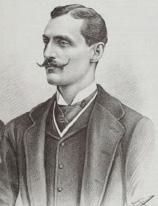
Conte Don Enrico Lucchesi Palli (1861-1924), Monarch of Campofranco. Purchased in 1889, when he accompanied his cousin Enrico (Henry), Prince of Parma, Earl of Bardi, on a tour of the world from 1887-1891. Thence by descent within the same family.
Estimate EUR 800
Starting price EUR 400
117
A MOLDED AND CARVED HIRADO BLUE AND WHITE VASE WITH CHRYSANTHEMUMS AND BUTTERFLIES

Japan, late 19th century, Meiji period (1868-1912)
Of square section, the petal-lobed ovoid sides finely applied with leafy chrysanthemum sprays and small butterflies, the leaves and butterflies decorated in cobalt blue and covered in a transparent glaze like the vase itself, the chrysanthemum blossoms in unglazed biscuit.
HEIGHT 16.5 cm
Condition: Good condition with minor wear, the biscuit chrysanthemum blossoms with small losses. Provenance: US private collection.
Hirado ware is a type of Japanese porcelain mostly made at kilns at Mikawachi, Sasebo, Nagasaki, and it is therefore also known as Mikawachi ware. It was made in the former feudal Hirado Domain, which owned the kilns, and was responsible for establishing and directing their production. It is known mainly for its underglaze cobalt blue and white porcelain, with the amount of blue often low, showing off the detailed modeling and the very fine white color of the porcelain. Hirado ware was developed to supply the domestic Japanese market in the 18th century, in the gap between the two main periods of Japanese export porcelain, and produced much of the best Japanese porcelain of the late 18th century and early 19th century. When large-scale exports resumed, it had a good share in the trade.
Estimate EUR 800
Starting price EUR 400
116
Conte Don Enrico Lucchesi Palli (1861-1924)
YABU TSUNEO: A FINE AND RARE MINIATURE SATSUMA VASE DEPICTING HYAKKI YAGYO (‘NIGHT PARADE OF ONE HUNDRED DEMONS’)

By Yabu Tsuneo (active after 1926), signed Meizan Japan, c. 1930
The pear-shaped body supported on a slightly spreading foot and rising to a waisted neck and garlic-head mouth with short lipped rim, the neck flanked by two cloud-form handles, the exterior exquisitely enameled with a procession of oni and yokai, including a three-eyed bakemono with a small pet, an Okame-like demon riding a boar, and a toad holding a tall staff. The base with the finely gilt signature MEIZAN.


HEIGHT 12 cm
Condition: Good condition, little rubbing to gilt. One of the handles restored.
Provenance: British private collection.
Hyakki Yagyo (‘Night Parade of One Hundred Demons’), also transliterated Hyakki Yako, is an idiom in Japanese folklore. Sometimes an orderly procession, other times a riot, it refers to a parade of thousands of supernatural creatures known as oni and yōkai that march through the streets of Japan at night. Kawanabe Kyosai (1831-1889), also known as ‘The Demon of Painting’ and a contemporary of Yabu Meizan, composed a book of paintings depicting a series of such demonic parades near the end of his life, which was first published after the artist’s death in 1889. Meizan was clearly familiar with this work and decided to recreate it for one of his pieces, heightening Kyosai’s designs with his painting and gilding techniques.

Yabu Tsuneo was the son of Yabu Meizan (1853-1934). He worked in the style of his father after his retirement in 1926. Like his father, his designs were quirky and often inspired by the work of Kawanabe Kyosai (1831-1889).
AUCTION COMPARISON:
Compare a related miniature Satsuma vase by Yabu Meizan, depicting a humorous procession of monkeys, 11.2 cm high, at Bonhams, Fine Japanese and Korean Art, 15 March 2017, New York, lot 6241 (sold for 12,500 USD).

118
Hyakki Yagyo by Kawanabe Kyosai
Estimate EUR 2,000 Starting price EUR 1,000
KINKOZAN: A RARE SATSUMA CERAMIC HU-FORM VASE WITH MAPLE AND SPARROWS
By the Kinkozan company, signed and sealed Kinkozan zo Japan, Kyoto, Meiji period (1868-1912)
The vase of Chinese Hu-shape rising from a short straight foot to a long neck with straight rim, comprising four sides that are finely painted in polychrome enamels and with gilt depicting an autumnal scene with four sparrows in flight amid branches of maple, all above a cream craquelure glaze. The rim in gilt with a band of key-fret. The recessed base with the gilt signature KINKOZAN zo and with an impressed seal KINKOZAN zo.
HEIGHT 18.8 cm
Condition: Very good condition, minor wear, mostly to the gilt, and manufacturing flaws. Provenance: British trade.
The design is quite unusual for the Kinkozan company and is much more reminiscent of the work of Yabvu Meizan (1853-1935)
AUCTION COMPARISON:
For a closely related satsuma vase with maple design, by Yabu Meizan, see Bonhams, Fine Japanese and Korean Art, 24 September 2020, New York, lot 896 (sold for 3,187 USD).


Estimate EUR 2,500 Starting price EUR 1,200

119
120
KINKOZAN: A PAIR OF COBALT-BLUE GROUND SATSUMA CERAMIC DISHES WITH PHEASANTS AND QUAILS
By the Kinkozan company, each signed Kinkozan zo Japan, Kyoto, Meiji period (1868-1912)
Each sturdily potted, the shallow rounded sides rising from a short foot to a petal-lobed rim. The interior finely decorated in colored enamels and gilt, one depicting a spring scene of pheasants below cherry trees in full bloom, the other depicting an autumnal scene of quails amongst dense autumnal grasses above a brown-gray ground. The rim and reverse covered in a rich cobalt blue. The recessed base with the gilt signature KINKOZAN zo.

DIAMETER 18.3 & 19.3 cm
Condition: Very good condition, minor wear, mostly to the gilt, and firing flaws.
Provenance: British collection.

AUCTION COMPARISON: Compare a related cobalt-blue ground satsuma dish, signed Kinkozan, size 31 cm, late 19th century, at Christie’s, Japanese Art & Design, 11 May 2011, London, lot 147 (sold for 1,500 GBP).
Estimate EUR 2,500 Starting price EUR 1,200
211

121
TOKUDA YASOKICHI III: A FINE KUTANI GLAZED PORCELAIN VASE





By Tokuda Yasokichi III (1933-2009), signed Kutani Masahiko Japan, late 20th century, Showa period (1926-1989)
The globular body supported on a short broad foot and rising to a slender cylindrical stem-form neck, covered overall in a rich, lustrous, finely crackled, blue-green streaked glaze, save for the white foot and base signed KUTANI MASAHIKO below an impressed foliate design.
HEIGHT 25.5 cm
Condition: Excellent condition. Provenance: Dutch collection.
Tokuda Yasokichi III was designated a Bearer of Important Intangible Cultural Assets (a “Living National Treasure”) in 1997 for his mastery of the innovative saiyu glaze technique, based on traditional Kutani colored glaze enamels as handed down from his grandfather and father, Tokuda Yasokichi I (1873–1956) and Tokuda Yasokichi II (1907–1997). Before he succeeded his father in 1988 as Tokuda Yasokichi III, the artist was known as Tokuda Masahiko.
LITERATURE COMPARISON:
Compare a related spherical vase by the same artist in the collection of the Metropolitan Museum of Art, accession number 2001.734. Compare a related vase by the same artist in the Minneapolis Institute of Art, accession number 2015.79.372.
AUCTION COMPARISON:
Compare a related vase by the same artist, 27.7 cm high, at Bonhams, Fine Japanese and Korean Art, 12 September 2018, New York, lot 1279 (sold for 4,750 USD). Another closely related vase by the same artist was sold at Zacke, Fine Japanese Art, 27 May 2022, Vienna, lot 75 (sold for 5,688 EUR).
Estimate EUR 3,000 Starting price EUR 1,500
213
Armor & Swords

Lots 122 to 140
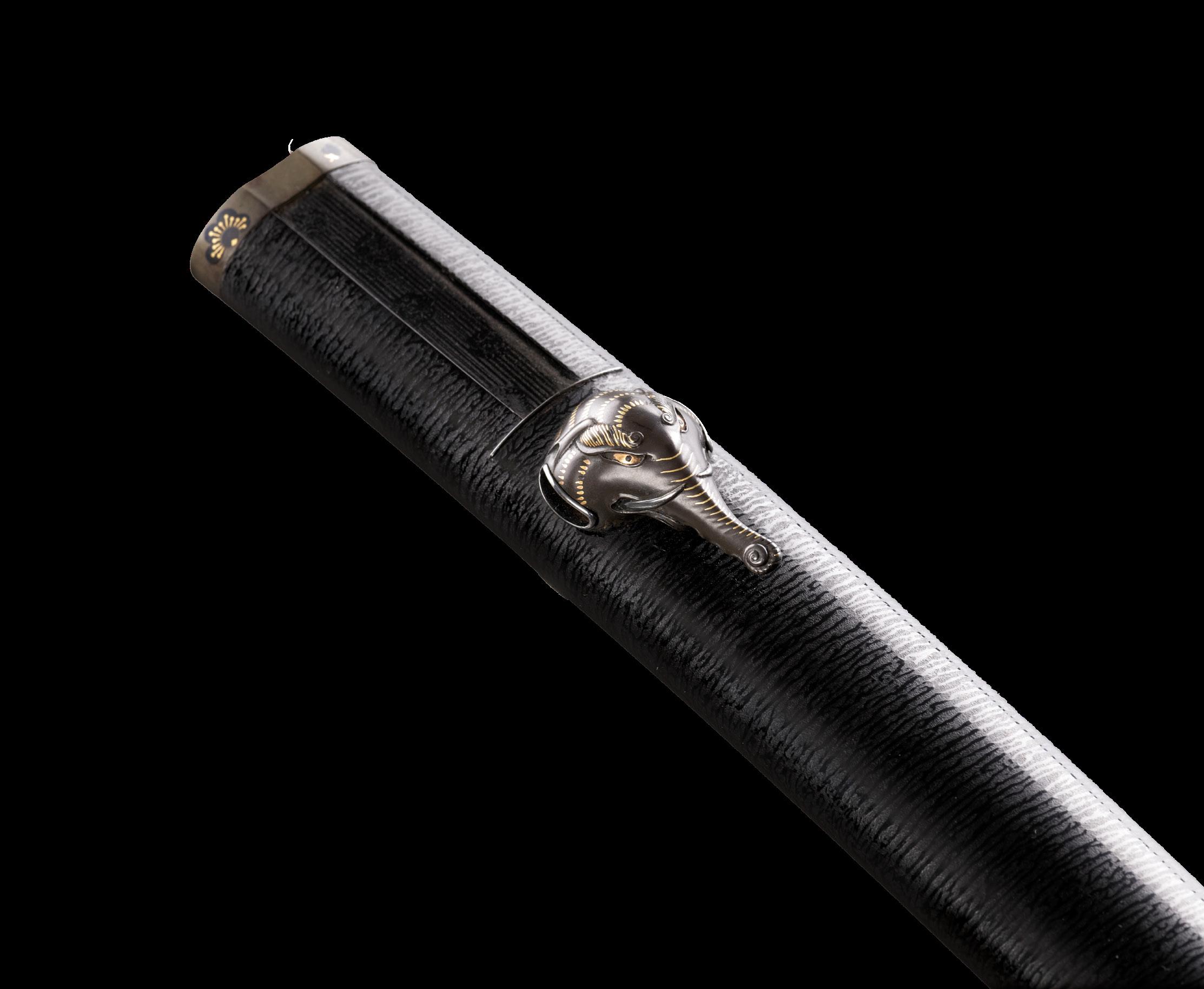


122 AN O-YOROI (‘GREAT HARNESS’) SUIT OF ARMOR
Japan, late Edo period (1615-1868)
The components lacquered gold and laced in blue, yellow, and orange, and mounted with gilt chrysanthemum-form kanamono. The armor comprising an iron sujibachi kabuto (helmet) with a 62-plate hachi mounted at the top with a partly gilt tiered chrysanthemum-form tehen kanamono, a loose-ring fitting suspending a red silk cord, with a five-lame shikoro, the lacquered fukigaeshi with lozenge designs, the mabizashi with raised geometric design and mounted with a gilt-metal maedate in the form of a ghost; a roughly textured black-lacquered menpo (mask) with facial hair and a three-lame yodare-kake; a brown-lacquered do (cuirass) with roughly textured black-lacquered sections similar to the menpo; two sode (shoulder guards) divided into a three-lame above a seven-lame section; two kote (sleeves) and tekko (gloves) with kusari and floral iron fittings over black textile decorated with tama pearls; two suneate (shin guards) with dark-brown lacquer and kusari over similar textile; and seven sections of five-lame kusazuri.

Condition: Very good condition with some wear, minor nicks, small losses, age cracks, flaking and small losses to lacquer, light scratches. Provenance: Dutch collection.
With a wood storage box.
Estimate EUR 10,000 Starting price EUR 5,000
216

AN IRON SAIGA BACHI KABUTO WITH GILT-WOOD MAEDATE

Japan, 16th century, late Muromachi (1336-1573) to Momoyama period (1573-1615)
Constructed of eight overlapping petal-shaped plates fastened by seated kiku-framed rivets, with four longer rivets, the two-lame shikoro laced with dark blue silk cords, the mabizashi flanked by small plain fukigaeshi, with a green silk chin cord. The gilt wood maedate of classic ken type.
LENGTH 30.5 cm, HEIGHT 21 cm WEIGHT 1,583 g
Condition: Good condition with some wear and traces of use, few small dents. Provenance: Dutch collection.
AUCTION COMPARISON: Compare to a related Saiga bachi kabuto of eccentric shape, also constructed of eight plates and with similar rivets, sold at Christie’s, Japanese and Korean Art, 18 April 2018, New York, lot 113 (sold for 18,750 USD).
Estimate EUR 3,000 Starting price EUR 1,500

123
124
A LACQUER JINGASA (WAR HAT) WITH ASHINA CLAN MON
Japan, 19th century, Edo period (1615-1868)
Of circular form with a domed top surmounted by an iron four-tiered chrysanthemum-form tehen kanamono from which three gold lacquered arrowlike tatemono elements extend, alternating with three mon composed of three encircled stripes (maru-no-uchi-ni-mitsuhikiryo), all against a roughly textured cream-colored ground, the rim of gold fundame. The underside is lacquered bright red with gold sprinkles, with linen straps. One of the ‘tatemono’ with an iron chrysanthemum-form fitting with a loose ring suspending a tasseled cord.


DIAMETER 42 cm
Condition: Good condition with some wear, few minor age cracks, small losses to lacquer, the underside with few tiny nicks and light surface scratches.
Provenance: Dutch collection.
The mon shown on the present jingasa is known as maru-no-uchi-ni-mitsuhikiryo and is associated with the Ashina clan.
Estimate EUR 1,500 Starting price EUR 800
125
A LACQUER JINGASA (WAR HAT) WITH HANABISHI MON
Japan, 19th century, Edo period (1615-1868)
Of circular form with a domed top and slightly flared brim, the black-lacquered top with a slight olive-green tint bearing a fine leathery texture and decorated with three gold-lacquered hanabishi mon (flowery-diamond crests), the rim of gold fundame. The smooth underside is lacquered a vibrant and even red, with cream-colored fabric straps.
DIAMETER 37 cm
Condition: Very good condition with minor wear, the underside with minuscule nicks and light surface scratches.
Provenance: Dutch collection.
The hanabishi mon is a crest that represents the head of the Takeda family and the military governor of Kai Province and is used as a family crest in Japan.

AUCTION COMPARISON: Compare a related lacquer jingasa, also decorated with three mon, dated late Edo to Meiji period, 42.5 cm diameter, at Christie’s, 28 January 2021, New York, lot 73 (sold for 5,625 USD).
Estimate EUR 1,200 Starting price EUR 600
219
126
A LACQUERED WOOD KURA (SADDLE) WITH TIGERS IN BAMBOO


Japan, 18th century, Edo period (1615-1868)
Of kurabane type, carved from red oak, the saddle lacquered with nashiji, the pommel (maewa) and cantle (shizuwa) both with a roiro ground finely decorated predominantly gold takamaki-e and hiramaki-e with kirikane to depict a ferocious roaring tiger balancing on a leafy bamboo stalk. The four triangular rings (shiode) for attaching the saddle are decorated with aogai inlay.
HEIGHT 26.3 cm, WIDTH 41 cm, LENGTH 39 cm
Condition: Good condition with minor wear and small losses to lacquer. One of the shiode lost. Provenance: Dutch collection.
Tiger imagery has a long history in East Asia. Tigers were frequently paired with dragons—the tiger representing the ‘male’ principle, the yin to the female ‘yang’ of the dragon, ancient cosmological symbols. Tigers are also commonly paired with bamboo, which is known as take no tora, or ‘tiger in bamboo’, and has many different interpretations; the tiger has a strong nature, is flexible and resilient like the bamboo, but it is also said that the strong tiger is looking for shelter underneath the bamboo, as any earthly power is inferior to the forces of nature. Moreover, the tiger and bamboo represent the power of faith in Buddhism.


LITERATE COMPARISON: Compare a related saddle, dated ca. 1700, in the Metropolitan Museum of Art, accession number 32.163.1a.
AUCTION COMPARISON: Compare a related saddle, dated to the 18th century, at Christie’s, 10 November 2004, London, lot 69 (sold for 4,183 GBP).
Estimate EUR 3,000 Starting price EUR 1,500
220
127
YOSHITSUGU:
A PAIR OF GILT AND SILVER-INLAID LACQUERED IRON STIRRUPS (ABUMI)
By Yoshitsugu, signed Yoshitsugu saku Japan, 17th to early 18th century, Edo period (1615-1868)
Of typical form, the exteriors finely decorated in gilt and silver hirazogan with flowering peony, the undersides each with a daikon radish. The buckles at the top with movable tangs. The interiors of red lacquer. Each stirrup signed on the uprights in silver hirazogan YOSHITSUGU saku.
SIZE 24.5 x 28 cm and 25 x 28 cm WEIGHT 2,284 g and 2,053 g
Condition: Good condition, commensurate with over 300 years of age. The lacquer with expected age cracks and some losses. Wear to inlays and gilt. Minuscule nicks and light scratches. Few minor losses to inlays. Provenance: Dutch collection.
At least eighteen artists using the name Yoshitsugu are listed in Haynes, Robert E. (2001) The Index of Japanese Sword Fittings and Associated Artists, two of which worked in Kaga Province, where the present stirrups were likely made; Yoshitsugu H 12230.0 (Kanazawa in Kaga Province, ca. 1600) and Yoshitsugu H 12234.0.
Abumi, Japanese stirrups, were used in Japan as early as the 5th century, and were a necessary component along with the Japanese saddle (kura) for the use of horses in warfare. Abumi became the type of stirrup used by the samurai class of feudal Japan.

The military version of this open-sided stirrup, called the shitanaga abumi, was in use by the middle Heian period. It was thinner, had a deeper toe pocket and an even longer and flatter foot shelf. It is not known why the Japanese developed this unique style of stirrup, but this stirrup stayed in use until European stylestirrups were introduced in the late 19th century. The abumi had a distinctive swan-like shape, curved up and backward at the front so as to bring the loop for the leather strap over the instep and achieve a correct balance. Most of the surviving specimens from this period are made entirely of iron, inlaid with designs of silver or other materials, and covered with lacquer.

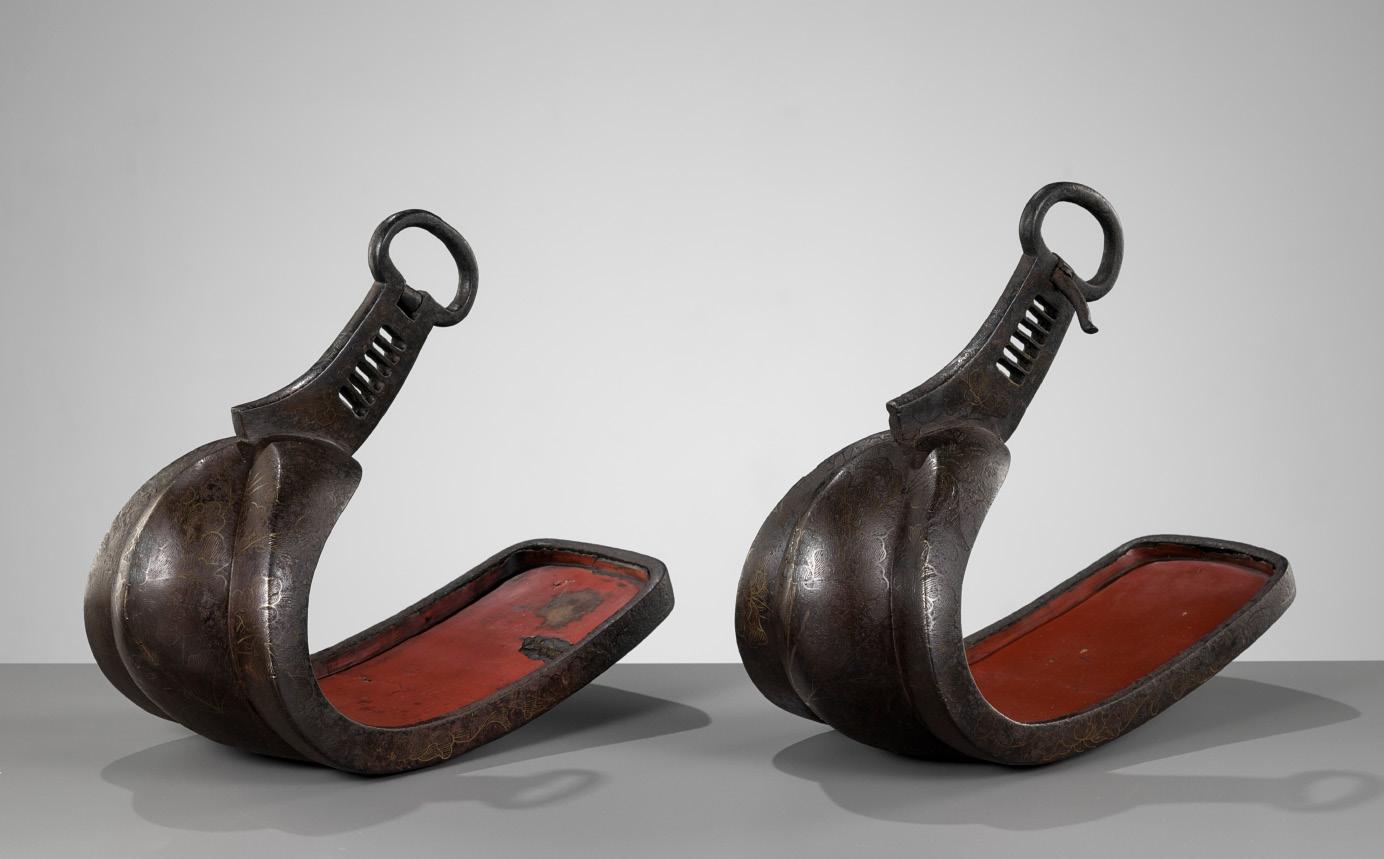
AUCTION COMPARISON:
Compare to a closely related pair of abumi, sold at Christie’s, Japanese Art and Design, 12 May 2010, London, lot 459 (sold for 4,000 GBP).
Estimate EUR 1,500 Starting price EUR 800
221
128
A RARE ‘DRAGON’ YAMATO UTSUBO (QUIVER) WITH YA (ARROWS)
Japan, 18th century, Edo period (1615-1868)


The utsubo (quiver) of wood, lacquered in black, red, gold, and silver hiramaki-e with a three clawed dragon amid swirling clouds, the central waist portion with a band of red lacquered leather, and the removable cover at the bottom held in place by a red lacquered leather band. The quiver contains twelve bamboo ya (arrows) fletched with feathers and painted in gold lacquer.
LENGTH 98.3 cm
Condition: Very good condition commensurate with age, few small nicks, minor losses to the lacquer, minuscule cracks, and small repairs.
Provenance: French private collection.

The traditional open ebira type quiver was carried on the back with the arrowheads downwards and the arrows and flights clearly visible. The utsubo type is said to have been developed in order to conceal the number of arrows held from an enemy. They were carried on the back with the arrow flights resting on an internal bamboo raft. Lacquered examples, as opposed to leather-clad and woven rattan examples, were quite luxurious and are known as Yamato utsubo.
LITERATURE COMPARISON: Compare a related utsubo with arrows, in the Victoria and Albert Museum, accession number CIRC.87-1950.
AUCTION COMPARISON: Compare a closely related utsubo with dragons, 18th century, at Christie’s, Samurai Swords and Armour: A Refined Art, 4 December 2014, lot 56 (sold for 8,750 USD).
Estimate EUR 6,000 Starting price EUR 3,000
222

129
A TANTO IN A SUPERBLY CARVED WOOD SAYA DEPICTING FROGS AND LOTUS
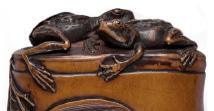

Japan, likely Hida province, 19th century, Edo period (1615-1868)
The saya and tsuka finely and naturalistically carved with two small frogs, the eyes inlaid with dark horn and the webbed feet superbly detailed, as well as furled lotus leaves and twisting vines. The end of the hilt formed as a lotus pod.

LENGTH 43.7 cm (total) and 23.6 cm (the blade)

Condition: Very good condition with minor wear, traces of use, few small losses to tsuka and saya. Provenance: Austrian private collection.
AUCTION COMPARISON: Compare the manner of the frogs to a wood inro sold at Bonhams, Japanese and Korean Art, 21 September 2022, New York, lot 538 (sold for 7,650 USD).
Estimate EUR 2,000 Starting price EUR 1,000
224
130
A FINE LACQUERED ‘MARINE-LIFE’ AIKUCHI TANTO
Japan, Meiji period (1868-1912)
The tanto mounted in a fine lacquer scabbard decorated in gold, silver and lacquer takamaki-e with fish, lobster, octopus, crab, and a hamaguri clam amid water grass, above a mother of pearl sprinkled ground. The fittings of silver.

LENGTH 28.6 cm (total) and 23.2 cm (the blade)
WEIGHT 130 g
Condition: Very good condition, minor wear, few minuscule losses. Provenance: British collection.
AUCTION COMPARISON:
Compare a related aikuchi tanto in lacquer scabbard, length 35.9 cm, 19th century, at Christie’s, Edo to Post-War: 500 Years of Japanese Art and Design, 17 November 2016, New York, lot 50 (sold for 4,000 USD).

Estimate EUR 3,000
Starting price EUR 1,500
225
A SUPERB INLAID LACQUER WAKIZASHI KOSHIRAE WITH CHERRY BLOSSOMS
Japan, 19th century
The black-lacquered saya with alternating textured and polished stripes and decorated in gold and colored takamaki-e with inlays of mother-of-pearl and coral leafy blossoming cherry sprays with falling leaves and fruit. The shakudo nanako tsuba of mokkogata form with two hitsu and gold rims, decorated in gold, silver, and shakudo takazogan with numerous lively horses striking different poses. The gold menuki crafted in the form of spiny lobsters, the shakudo nanako fuchi-kashira decorated in gold takazogan with spiny lobsters as well. The rayskin tsuka with green silk tsukamaki in lozenge pattern. With a wood blade and silk bag.


LENGTH 75 cm
Condition: Very good condition with minor wear, one tiny loss to one inlay.
Provenance: British private collection
Estimate EUR 4,000
Starting price EUR 2,000
226
131


132
SUKEMUNE:
A TANTO IN SUPERB KOSHIRAE
By Shimada Sukemune, signed Sukemune saku Japan, the blade mid-16th century, late Muromachi period (1336-1573), the mounting 18th-19th century, Edo period (1615-1868)
The blade: The blade with a wide hira-zukuri, muzori, and iori mune. The hamon is notare-ba in nie-deki, with profuse ko-ashi, the hada is ko-itame with pronounced grain and jinie. The blade carved with horimono to either side, the omote with ken and tsume, the ura with bonji and futasuji-hi. The silver habaki with incised diagonal lines. The nakago with two mekugi-ana and kuri jiri, the mei reads SUKEMUNE saku.

The mounting: The shibuichi tsuba of irregular form with two hitsu, decorated in gold takazogan with plum blossoms. The shakudo fuchi and kashira decorated in gold and silver takazogan with birds and plum blossoms and buds. The shibuichi menuki in the form of snails. The kojiri inlaid with stylized plum blossoms and leaves. The shakudo kurikata finely cast in the form of an elephant head with gold takazogan details. The rayskin tsuka wrapped in black leather. The black-lacquered saya in tataki-nuri.

With an NBTHK Hozon Token (Sword Worthy of Presentation) paper dated Heisei 26 (2014), no. 3005213.
NAGASA 29.7 cm, LENGTH 55.7 cm

Condition: Excellent condition with minor wear. Provenance: From an important British private collection.
Estimate EUR 10,000 Starting price EUR 5,000

133
SUKEHIRO: A KATANA IN SHIRASAYA
By Sukehiro, signed Echizen no kami Sukehiro Japan, Edo period (1615-1868)
The slender, gently curved blade with shinogi-zukuri and iori mune. The hamon is choji midare in nioi-deki with ashi, ending in an omaru boshi. The copper double habaki is partly gilt and decorated with diagonal file marks. The nakago with one mekugiana and kuri jiri, the mei reads Echizen no kami SUKEHIRO.

With a registration certificate issued on firearms and swords (Juho token rui torokusho) by the Committee of the Protection of Cultural Properties (Bunkazai hogo iin kai), no. 7695 in Gunma Prefecture, on 31 August 1963 (Showa 38), noting a nagasa of 2-shaku 1-sun 2-bu, a sori of 4-bu (ca. 1.21 cm), confirming the reading of the signature above, with seal Bunkazai Hozon Iin Kai.

NAGASA 64.2 cm, LENGTH 87 cm
Condition: Good condition with wear, fukure, blisters, light scratches. Provenance: Hungarian private collection.
Estimate EUR 4,000
Starting price EUR 2,000
134
SUKEHIRO: A WAKIZASHI IN SHIRASAYA, DATED 1687 BY INSCRIPTION
By Sukehiro, signed Tsuda Echizen no kami Sukehiro Japan, dated 1687
The slightly curved blade with shinogi-zukuri and iori mune. The hamon is midare with some notare, ending in a midare-komi boshi, the hada is itame. The copper habaki is partly gilt. The nakago with one mekugi-ana and kengyo jiri, the back inscribed Enpo rokunen nigatsu hi (A day in the second month in Enpo 6th year [corresponding to 1678]), the mei on the front reads Tsuda Echizen no kami SUKEHIRO.
NAGASA 54.6 cm, LENGTH 87.2 cm

Condition: Good condition with minor wear and traces of use, the mune with small nicks and some ware, minor fukure.
Provenance: Hungarian private collection.
This wakizashi was likely made by Sukehiro II in Settsu Province, see Sesko, Markus (2012) Index of Japanese Swordsmiths, p. 172-173. Around 1674, the swordsmith changed the style of his signature from kaku (square) to rounded (maru), as seen on the present lot.

AUCTION COMPARISON:
Compare a closely related wakizashi, also with a very shallow sori and signed Tsuda Echizen no kami Sukehiro, dated to the 17th century, at Sotheby’s, 11 May 2021, London, lot 37 (sold for 8,190 GBP).
Estimate EUR 6,000
Starting price EUR 3,000
135
TADAYOSHI: A HIZEN KATANA IN SHIRASAYA, DATED 1660, WITH GILT
INSCRIPTION
Signed Hizen no Kuni Tadayoshi Japan, dated 1660
The slender, gently curved blade with shinogi-zukuri and iori mune. The hamon is sugu in nie-deki ending in an omaru boshi, the hada is itame with some mokume. The silver habaki with diagonal file marks and dew drops. The nakago with one mekugi-ana and kuri jiri, with a gilt-inlaid tameshigiri (test-cutting) mei reading Manji sannen nigatsu hi, futatsu do setsudan, Yamano Kaemon (A day in the second month, Manji 3rd year [corresponding to 1660], a test cutting of Futatsu do [has cut two torsos] by Yamano Kaemon, the mei reads Hizen no Kuni TADAYOSHI.

NAGASA 69.5 cm, LENGTH 94.4 cm
Condition: Very good condition with minor wear and little fukure and ware.
Provenance: Hungarian collection.
232
The present sword was tested by Yamano Kaemon, who was the leader of the Yamano school – a school that was responsible for testing swords for sharpness and smooth cutting ability. To test this sword, he cleanly cut through two deceased human torsos. Gold letters on the tang of this sword acknowledge that a highly respected person inspected and certified this sword.
AUCTION COMPARISON:
Compare a related katana in shirasaya by Tadayoshi, dated 17th century, at Christie’s, 10 November 2004, London, lot 20 (sold for 26,290 GBP). Compare a related katana in a 19th-century koshirae by Tadayoshi (3rd generation), dated 17th century, at Christie’s, 18 September 2008, New York, lot 331 (sold for 25,000 USD).



Estimate EUR 15,000
Starting price EUR 8,000
136
AN UDA SCHOOL WAKIZASHI IN SHIRASAYA WITH NBTHK
KICHO TOKEN CERTIFICATE
Japan, 16th-17th century, late Muromachi period (1336-1573) to early Edo period (1615-1868)
The slender curved blade with shinogi-zukuri and iori mune. The hamon is sugu with slight notare, the hada is mokume. The copper habaki with diagonal file marks and dew drops. The nakago with two mekugi-ana, mumei, and kiri jiri.

With an NBTHK Kicho Token (‘Precious Token’) certificate, issued to a Mr. Takeda on 13 October 1979 (Showa 54), no. 377441, attributing the blade to the Uda school, noting a nagasa of 6-sun 1-bu 5-ri, in the original envelope.

NAGASA 48.8 cm, LENGTH 70.7 cm (total)
Condition: Good condition with some wear, minor fukure and ware, the mune with a small nick. Provenance: Hungarian collection.
The founder of the Uda school is considered to have been Kunimitsu. He was originally from the Uda district of Yamato Province. He worked around the Bunpo era (1317-1319) at the end of the Kamakura period. All of the succeeding smiths of this school used the kanji character Kuni in their signatures. Since remaining works by Kunimitsu are non-existent, his students Kunifusa and Kunimune are generally thought to be the true founders of this school. Both of these smiths studied under Norishige of the Etchu Province and they were active around the Koan era (1361-1362).
Estimate EUR 2,500
Starting price EUR 1,200
137
TADASHIGE: A TAKADA SCHOOL WAKIZASHI IN SHIRASAYA WITH NBTHK KICHO TOKEN CERTIFICATE

By Tadashige, signed Tadashige Japan, 17th century, Edo period (1615-1868)
The slender curved blade with shinogi-zukuri and iori mue. The hamon is notare with some midare in nie-deki, ending in a komaru boshi, the hada is itame. The gilt copper habaki with diagonal file marks and dew drops. The nakago with one mekugi-ana and kuri jiri. The mei reads TADASHIGE.
With an NBTHK Kicho Token (‘Precious Token’) certificate, issued to a Mr. Yoshida on 5 September 1971 (Showa 46), no. 218354, noting a nagasa of 1-shaku 7-sun 2-bu, confirming the reading of the signature above and attributing the blade to the school of Fujiwara Takada, in the original envelope.
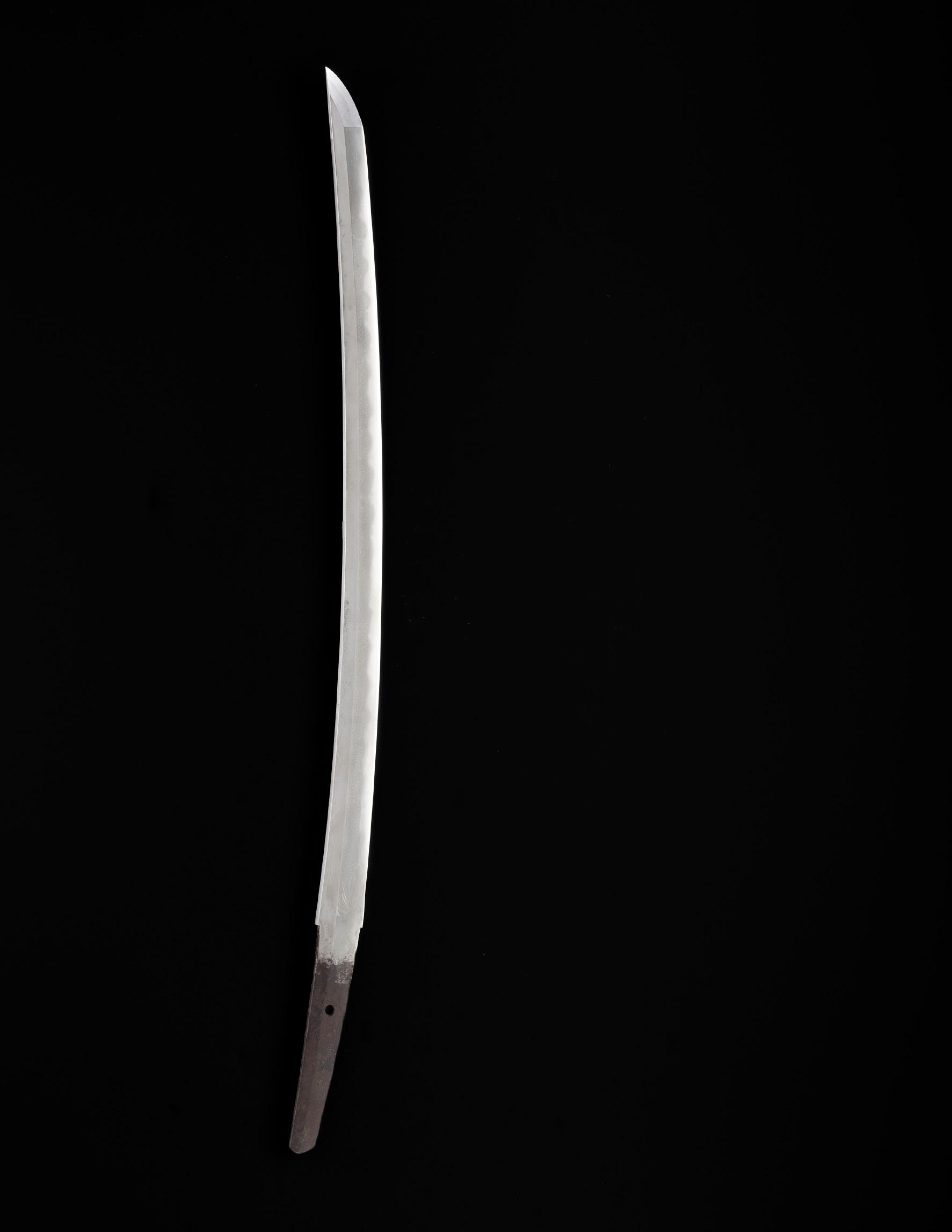
NAGASA 52 cm, LENGTH 75.2 cm (total)
Condition: Good condition with some wear, light scratches, and minor fukure and ware.
Provenance: Hungarian private collection.
Estimate EUR 2,500 Starting price EUR 1,200
138
A RARE KATANA IN KOSHIRAE, THE BLADE ATTRIBUTED TO JUMYO, WITH NBTHK KICHO TOKEN CERTIFICATE

Japan, the blade 15th-16th century, Muromachi (1336-1573) to Momoyama period (1573-1615), the mounting 17th-18th century, early Edo period (1615-1868)
The blade:
The slender, gently curved blade with shinogi-zukuri and iori mune. The hamon is gunome-midare in nie-deki with many hataraki including kinsuji and chikei, ending in a komaru boshi. The hada is itame. Both sides of the blade with a full-length bohi. The nakago is suriage with kiri jiri, mumei, one of the three mekugi-ana is filled with lead, part of an early mekugi-ana is visible at the bottom of the nakago.
The mounting:
The shakudo tsuba of maru-gata form with two hitsu, decorated in gold, silver, and copper takazogan with a boar and autumn grasses under a flat-inlaid moon to one side and flowers above a stream to the other. The iron fuchi and kashira are inlaid with gilt-copper to depict rain dragons and a reishi cloud. The figural menuki with details in copper and gold. The rayskin tsuka with green silk tsukaito. The saya is lacquered in roiro.
With an NBTHK Kicho Token (‘Precious Token’) white paper, dated 12 March 1967 (Showa 42), no. 122478, attributing the blade to Jumyo, noting a nagasa of 2-shaku, 3-sun 5-bu, in the original envelope.
NAGASA 71.1 cm, LENGTH 101.5 (total)
Condition: Very good condition with minor wear and traces of use, the blade with a tiny nick to the kissaki and scattered small fukure, the mounts with few minuscule nicks.
Provenance: Dutch collection.
With a fine silk brocade cover decorated in gold and colored thread with fans and swirling clouds.
The Jumyo (lit. ‘longevity’) school has its origins from Yamato Province (Nara Prefecture) and moved to Mino Province (Gifu Prefecture) in the Kamakura period (1185-1333). The tradition continued for centuries, right up until the end of the Edo period in 1868.
AUCTION COMPARISON:


Compare a related katana, signed Noshu Ju Jumyo, also with bohi on both sides but dated 18th century, at Christie’s, 13 December 2017, London, lot 17 (sold for 4,750 GBP). Compare a related katana, signed Jumyo, dated late 16th century, Momoyama period, at Christie’s, 21 June 2001, London, lot 9 (sold for 4,230 GBP).
Estimate EUR 6,000
Starting price EUR 3,000
236

139 KANEHISA: A TANTO IN SHIRASAYA WITH INSCRIBED BLADE

By Kanehisa, signed Kanehisa Japan, Edo period (1615-1868)
The blade with hira-zukuri and maru mune, the hamon is sugu with nie and nioi, the hada is masame. One side of the blade with a half-length bohi and a narrower ridge (soehi) below a horimono in bon script representing Fudo Myo-o. The habaki is gilt. The nakago with one mekugiana and kuri jiri. The wood saya of an attractive grain and color with bone fittings. The mei reads KANEHISA.
NAGASA 16 cm, LENGTH 27.3 cm
Condition: Very good condition with minor wear and traces of use.
Provenance: Hungarian collection.
Estimate EUR 2,000 Starting price EUR 1,000
140 A RARE MINO YOROI-DOSHI (‘ARMOR PIERCER’) IN SHIRASAYA
Japan, 14th-15th century, Muromachi period (1336-1573)
The blade with hira-zukuri and a broad iori mune tapering toward the kissaki. The hamon is sanbonsugi in nioi-deki, the hada is masame with little itame, the boshi is omaru. The nakago with one mekugi-ana, mumei, and haagari jiri.
NAGASA 22.7 cm, LENGTH 38.8 cm (total)
Condition: Very good condition with minor wear, traces of use, the blade with minor ware.
Provenance: Hungarian collection.
The yoroi-doshi (‘armor piercer’ or ‘mail piercer’) is one of the traditionally made Japanese swords that appeared in the Sengoku period (late Muromachi) and were worn by the samurai class as a weapon in feudal Japan. It is an extra thick tanto and was made for piercing armor and for stabbing while grappling in close quarters. Yoroi-doshi were worn inside the belt on the back or on the right side with the hilt toward the front and the edge upward. Due to being worn on the right, the blade would have been drawn using the left hand, giving rise to the alternate name of metezashi or ‘horse-hand (i.e. rein-hand, left-hand) blade’.

Estimate EUR 2,000
Starting price EUR 1,000
Sword Fittings
Lots 141 to 163


141
ICHIRYU TOSHIMITSU:
A SUPERB SENTOKU BAKUMATSU TSUBA WITH MONKEYS AND CRABS



By Ichiryu Toshimitsu, signed Ichiryu Toshimitsu 一柳壽光 with kakihan Japan, late 19th century, Meiji period (1868-1912)
Of aorigata shape, decorated in masterful takazogan with highlights of gold, copper and shakudo depicting a family of three monkeys, the father getting his hand nipped by a crab, while one of his young tries to pull him free, pulling on the collar of his father’s jacket, another monkey to the side screaming with his arms flailing. The reverse with another crab and an inlaid silver river stream, signed ICHIRYU TOSHIMITSU and kakihan.
SIZE 8.2 x 8 cm WEIGHT 226.0 g
Condition: Very good condition, minor surface wear. Provenance: British collection.
Ichiryu Toshimitsu is listed on page 2054, H 10450.0 in THE INDEX OF JAPANESE SWORD FITTINGS AND ASSOCIATED ARTISTS by Robert E. Haynes. He lived in Mito, Hitachi province, and was the first son and student of Hirano Toshiharu.
The present tsuba is a reference to the story of ‘The Crab and the Monkey’, in which a sly monkey kills a crab, and is later killed in revenge by the crab’s offspring.
Estimate EUR 4,000 Starting price EUR 2,000
242

142
TACHIBANA TAKAIE: A SUPERB GOLD AND SILVER INLAID IRON TSUBA WITH SARUMAWASHI AND MONKEY

By Tachibana Takaie (1850-1900), signed Morioka no Ju Tachibana Takaie Tsukuru, Tetsugendo horu 盛岡住 橘孝家造 鉄元堂鐫 Japan, late 19th century, Meiji period (1868-1912)
Of kaku-marugata (rounded square) form with three hitsu, worked in masterful takazogan with gold, silver, copper, and shibuichi details depicting a sarumawashi (monkey trainer) carrying his monkey on his back, below the silver-inlaid moon partly covered in misty clouds. Inscribed and signed Morioka no Ju TACHIBANA TAKAIE tsukuru [made by Tachibana Takaie from Moriaka]. The reverse with two haystacks in gold takazogan and with inscription Tetsugendo horu.
SIZE 8.4 x 7.2 WEIGHT 237.3 g
Condition: Very good condition, minor surface wear. Provenance: British private collection, purchased at Christie’s, Japanese Art and Design, 9 November 2005, London, lot 70 (sold for 3,360 GBP).
Tachibana Takaie is listed on page 1849, H 09273.0 in THE INDEX OF JAPANESE SWORD FITTINGS AND ASSOCIATED ARTISTS by Robert E. Haynes. The artist lived in Morioka in Rikuoka province and worked with Hidemune.
Estimate EUR 5,000 Starting price EUR 2,400
244

143
A FINE BAKUMATSU SENTOKU TSUBA WITH NOH MASKS
After Iwamoto Konkan (1744-1801), signed Iwamoto Konkan 岩本昆寛 Japan, late 19th century, Meiji period (1868-1912)
Of kakugata shape, the front finely worked in copper, shibuichi and gold takazogan, depicting two noh masks of Okame and oni, their tassels neatly incised and worked in shishiaibori (sunken relief), the reverse with a Konoha-tengu mask worked also worked in shishiabori. Signed IWAMOTO KONKAN – likely as a tribute to this legendary artist.


SIZE 9.7 x 8.3 cm WEIGHT 261.6 g
Condition: Very good condition, minor associated surface wear. Provenance: British collection.
Iwatomo Konkan is listed on pages 716-717, H 03464.0 in THE INDEX OF JAPANESE SWORD FITTINGS AND ASSOCIATED ARTISTS by Robert E. Haynes. Also known as Asai Konkan. He was the student and adopted son of Ryokan I, fifth master of the Iwamoto family, and founder of the Iwamoto school. He originally worked in the style of the Yokoya school and Nara school, but later developed the Konkan style. His work style and subject were so popular that the majority of signed examples are reproductions made in homage to this artist.
Auction comparison: For a related tsuba after Iwamoto Konkan, Meiji era (1868-1912), see Bonhams, Fine Japanese Art, 12 May 2016, London, lot 329 (sold for 6,875 GBP).
Estimate EUR 2,500 Starting price EUR 1,200
246
TORYO: A SUPERB BAKUMATSU COPPER TSUBA OF THE BUNBUKU CHAGAMA

By Toryo, signed Toryo 東凌 Japan, late 19th century, Meiji period (1868-1912)
Of tate-itomaki-gata with sumikiri corners, finely decorated in shibuichi, gold and copper takazogan depicting a tanuki seated by a tea kettle holding a teacup, the reverse with an idyllic scene of a straw hut below the moon in shibuichi, silver, and gold takazogan, inscribed Higashidaishita Shinobigaoka no hotori ni oite kore o saku, signed TORYO and with a seal.

SIZE 8.2 x 8.1 cm WEIGHT 246.3 g
Condition: Very good condition, minor wear, few minuscule nicks here and there.
Provenance: British collection.
The popular folktale Bunbuku-Chagama tells of a tanuki being mistreated as a tea kettle at a temple, before being sold off and bringing great wealth to its new owner using its shapeshifting powers.

Estimate EUR 2,500
Starting price EUR 1,200
The lucky tea kettle of Morin Temple (Morinji no bunbuku chagama), from the series New Forms of Thirtysix ghosts, by Tsukioka Yoshitoshi, 1892, in the collection of the Art Gallery NSW, accession number 582.2018.2

144
KATSUYASU: A FINE INLAID SENTOKU TSUBA WITH YORITOMO HIDING IN A TREE
By Katsuyasu (1832-1880), signed Katsuyasu horu 勝保鐫 Japan, late 19th century, Meiji period (1868-1912)
Of kakugata shape with sumikiri corners, decorated in superb gold, silver, shakudo, and copper takazogan, depicting Yoritomo and his comrades hidden in a tree trunk and two doves in flight, the reverse finely engraved with pines, military banners, and mountains, signed KATSUYASU horu.

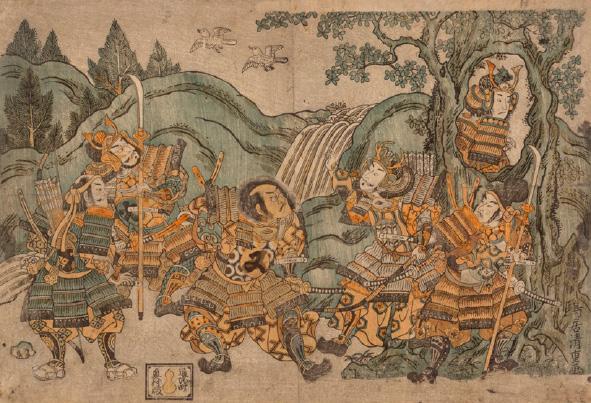

SIZE 9.3 x 8.5 cm WEIGHT 194.9 g
Condition: Very good condition, minor wear.
Provenance: British collection.
Katsuyasu is listed on page 608, H 02931.0 in THE INDEX OF JAPANESE SWORD FITTINGS AND ASSOCIATED ARTISTS by Robert E. Haynes. The artist was born in Mito, Hitachi province, as the second son of Hagiya Katsuhira. He carried on the family business in Mito and Edo.
This tsuba shows Minamoto Yoritomo hiding from his enemies in a tree during the Genpei War (1180-1185). Yoritomo was being followed through the Hakone Mountains by warriors from the Taira clan. One of these warriors, Kajiwara Kagetoki, was secretly a supporter of Yoritomo. When the Taira soldiers came upon the tree where Yoritomo was hiding, Kagetoki stuck his bow into the tree. This startled two doves that flew away. Kagetoki convinced the other Taira soldiers that no one could be in the tree with the doves, thus allowing Yoritomo to escape.
Estimate EUR 2,500 Starting price EUR 1,200
1758,
145
Woodblock print of Minamoto no Yoritomo Hiding in a Tree by Torii Kiyoshige, circa
in the Art Institute Chicago, reference number 1942.68
TOSHIMASA: A SUPERB SENTOKU TSUBA DEPICTING SHOKI WITH ‘BAT ONI’

By Toshimasa, signed Toshimasa 壽正 Japan, late 19th century, Meiji period (1868-1912)
Of octagonal form and finely worked in shishiaibori (sunken relief) and with gold, copper, and shibuichi takazogan with Shoki confronted by a flying oni in the form of a bat, the reverse with a silver inlaid moon behind clouds. Signed TOSHIMASA.
SIZE 8.2 x 7.5 cm
WEIGHT 178.8 g
Condition: Very good condition, minor surface wear. Provenance: British collection.
Estimate EUR 4,000 Starting price EUR 2,000
249
146
147
HAMANO NORIYUKI: A SENTOKU TSUBA OF RIHAKU GAZING AT THE MOON
By Hamano Noriyuki, signed Hamano Noriyuki saku 濱埜矩隨 Japan, 18th-19th century, Edo period (1615-1868)
Of tate-marugata shape, with one hitsu, finely worked in sukashibori (openwork) with gold, silver and shibuichi takazogan to depict Rihaku (Li Bai) leaning out a window with a book in his left hand and gazing towards the hidden full moon, signed HAMANO NORIYUKI. The reverse depicting the backside of the hut with a bamboo fenced window.
SIZE 6.3 x 7 cm WEIGHT 105.7 g
Condition: Very good condition with minor associated surface wear. Provenance: British collection.
Hamano Noriyuki is listed on pages 1446-1447, H 07454.0 and H 07455.0 in THE INDEX OF JAPANESE SWORD FITTINGS AND ASSOCIATED ARTISTS by Robert E. Haynes. Hamano Noriyuki I (1736-1787) lived in Edo. Hamano Noriyuki II (1771-1852), born in Edo, was the adopted son and student of Noriyuki I.

The present tsuba depicts a scene from one of the most recited poems in Chinese literature, Li Bai’s ‘Quiet Night Thoughts’ in which moonlight near his bed invokes thoughts of home.

Estimate EUR 1,500 Starting price EUR 800

250
148
HAMANO NORIYUKI: A FINE HAMANO SCHOOL SHIBUICHI, SILVER AND ENAMELED KOZUKA
By Hamano Noriyuki, signed Hamano Noriyuki saku 濱埜矩隨作 Japan, 18th-19th century, Edo period (1615-1868)
Of shibuichi, decorated with subtle silver and shippo enamels, depicting cherry blossoms floating on water under the reflection of the moon, the reverse continuing the imagery and inscribed on a silver section Shokado no zu o motte HAMANO NORIYUKI kore o saku [made by Hamano Noriyuki, after a design by Shokado].
LENGTH 9.6 cm WEIGHT 35.1 g
Condition: Very good condition, minor wear. Provenance: British collection.
Hamano Noriyuki is listed on pages 1446-1447, H 07454.0 and H 07455.0 in THE INDEX OF JAPANESE SWORD FITTINGS AND ASSOCIATED ARTISTS by Robert E. Haynes. Hamano Noriyuki I (1736-1787) lived in Edo. Hamano Noriyuki II (1771-1852), born in Edo, was the adopted son and student of Noriyuki I.
Estimate EUR 1,500
Starting price EUR 800
149 A GOLD AND SILVER-INLAID SHAKUDO KOZUKA WITH SIGNED BLADE
The blade with inscription and signed Kunimitsu Japan, 18th-19th century, Edo period (1615-1868)


The shakudo nanako ground finely decorated with gold and silver takazogan with nogiku (daisies) and long leaves with serrated edges tied together with a string, the reverse left plain, with a steel blade bearing an inscription and signed Kunimitsu. With a wood storage box.
LENGTH 9.7 cm (the handle), 16.9 cm (the blade incl. tang), and 20.7 cm (total)
WEIGHT 26.6 g (the handle) and 12.1 g (the blade)
Condition: The handle in excellent condition with minor wear. The blade in good condition with some wear and minor blisters. Provenance: British collection.
Estimate EUR 1,500 Starting price EUR 800
251
150
A FINE SHIBUICHI KOZUKA WITH DRYING FUGU
Unsigned Japan, 19th century, Edo period (1615-1868)


One side decorated in superb shibuichi, copper, and gold takazogan depicting a fugu (puffer fish) hung to a bamboo stick to dry, the reverse in densely engraved katakiri and ke-bori with a bustling scene of the Nihonbashi bridge, Mount Fuji visible to the side in the background.
LENGTH 9.7 cm WEIGHT 35.3 g
Condition: Very good condition, minor expected surface wear. Provenance: British collection.
Estimate EUR 1,500 Starting price EUR 800
252
151
YURAKUSAI SEKIBUN: A SUPERB SHAKUDO AND GOLD KOZUKA WITH CARP IN WATER WEEDS
By Yurakusai Sekibun, signed Yurakusai Sekibun 遊洛齋 赤文
Japan, 19th century, Edo period (1615-1868)


Of shakudo-nanako ground, finely decorated in gold takazogan with a carp swimming amid water weeds, signed YURAKUSAI SEKIBUN to the reverse.
LENGTH 9.9 cm WEIGHT 37.3 g
Condition: Excellent condition, minor wear. Provenance: British collection.
Yurakusai Sekibun is listed on page 1624-1625, H 08118.0 and H 08119.0 in THE INDEX OF JAPANESE SWORD FITTINGS AND ASSOCIATED ARTISTS by Robert E. Haynes. Yurakusai Sekibun I (1790-1872) was born in Murakami, Echigo province, and studied the Hamano school style. He learned both iron and soft metal plate techniques. His son Yurakusai Sekibun II (1838-1912) was born in Edo and took on his father’s name and titles after his death.
AUCTION
COMPARISON: Compare a related kashira and fuchi of a carp and water weeds by Yurakusai Sekibun, 19th century, at Bonhams, Arts of the Samurai, 27 October 2014, New York, lot 1175 (sold for 2,500 USD).
Estimate EUR 2,000 Starting price EUR 1,000

152
A SENTOKU KOZUKA WITH CRAB
Unsigned Japan, 19th century, Edo period (1615-1868)
The kozuka of rectangular shape, rounded to one side, created from sentoku and worked in copper takazogan with a crab, the details embellished with gold and shakudo.



LENGTH 9.8 cm WEIGHT 26.5 g
Condition: Very good condition, minor wear. Provenance: British collection.
Estimate EUR 1,000 Starting price EUR 500
153
RYUCHIKEN TERUYUKI: A SENTOKU AND GOLD KOZUKA WITH A CICADA ON A TREE
By Ryuchiken Teruyuki (circa 1825-1875), signed Ryuchiken Teruyuki 龍池軒英随
Japan, 19th century, Edo period (1615-1868)
The sentoku kozuka with masterful gold takazogan depicting a cicada perched on a tree trunk, the bark elaborately engraved with wood grain incisions, the reverse with an archaic Chinese poem written in gold nonume-zogan and signed RYUCHIKEN TERUYUKI. With a fitted wood storage box.
LENGTH 9.6 cm WEIGHT 30.7 g
Condition: Very good condition, minor wear. Provenance: British collection.

Ryuchiken Teruyuki, also known as Arai Teruyuki, is listed on page 1922, H 09665.0 in THE INDEX OF JAPANESE SWORD FITTINGS AND ASSOCIATED ARTISTS by Robert E. Haynes.
AUCTION COMPARISON:
Compare a closely related kozuka with a cicada on a tree by Ryuchiken Teruyuki, 19th century, at Bonhams, The Paul Goodman collection of Japanese arrowheads, swords, and fittings Part I, 20 October 2015, New York, lot 146 (part lot, sold for 3,125 EUR).
Estimate EUR 1,000 Starting price EUR 500
254
154
HARUCHIKA: A RARE SHIBUICHI AND SHAKUDO KOZUKA OF ANTS ON ROTTEN BARK
By Haruchika, signed Haruchika 春親 Japan, 19th century, Edo period (1615-1868)
The rather unusual kozuka made of two sections, one of shibuichi and one of shakudo, joined by two gold clips and a gold butterfly dovetail joint, depicting masterfully inlaid gold ants crawling on a piece of rotten bark. The reverse engraved with a branch-like design. With a fitted wood storage box, inscribed to the interior of the lid with an attestation by Amiya Soemon dated 1950.



LENGTH 9.8 cm WEIGHT 30.9 g
Condition: Excellent condition, minor wear.
Provenance: British collection.
Estimate EUR 1,500 Starting price EUR 800
155
JOKA: A RARE LACQUERED METAL KOZUKA WITH ANTS
By the Joka family, signed Joshin zu 乗真図 Joka 常嘉 with kakihan Japan, 19th century, Edo period (1615-1868)
Lacquered in kinji (gold) and in imitation of shibuichi, with five ants carrying dew drops, the reverse with inscription in gold lacquer Joshin zu (the design after Kano Joshin, active c. 1660) and signature JOKA with kakihan.
LENGTH 9.6 cm WEIGHT 22.4 g
Condition: Very good condition, minor wear to lacquer, particularly to the gold-lacquered inscription. Provenance: British collection.
Joka is listed on page 451, H 02141.0 in THE INDEX OF JAPANESE SWORD FITTINGS AND ASSOCIATED ARTISTS by Robert E. Haynes. The signature Joka indicated a group of artists who were active during the last two hundred years of the Edo period and into the Meiji period. There are various signatures and most artists are known for their lacquered metalwork.
Museum comparison: Compare a related iron tsuba by Joka, after Yasuchika, early 19th century, in the Metropolitan Museum of Art, accession number 1999.270.
Estimate EUR 1,500 Starting price EUR 800
156
GOTO MITSUTAKA: A SUPERB SHAKUDO NANAKO KOZUKA WITH DRAGON AND TIGER
By Goto Mitsutaka (1722-1784) after a design by Goto Teijo (16031673), signed Teijo saku 程乘作 and Mitsutaka 光孝 with kakihan Japan, 18th century, Edo period (1615-1868)
The front masterfully decorated in takazogan with a dragon and tiger above a superb shakudo-nanako ground, the reverse in gold with nekogaki (‘cat scratch’), signed TEIJO saku and MITSUTAKA with kakihan. With a wood tomobako storage box with an attestation by Sato Kanzan (1907-1978), dated 1972. With an attestation origami [certificate] with the signature of Goto Mitsutada bearing a date of 1729.
LENGTH 9.6 cm WEIGHT 27.7 g
Condition: Excellent condition, minor expected surface wear. Provenance: British collection.
The Goto School of sword-fittings makers was founded in the fifteenth century by Goto Yujo, who is said to have been patronized by the shogun Ashikaga Yoshimasa (1435–1490). The work of the Goto masters is characterized by painterly designs carved in high relief on a ground of shakudo (an alloy of copper and gold chemically treated to turn a rich blue-black), finished in nanako (tiny circles punched regularly over the surface to give it a granular appearance) with colorful accents in gold and silver.
MUSEUM COMPARISON:
Compare a related nanako ground kozuka inscribed by Goto Mitsutaka, 18th century, note the nekogaki decoration to the reverse, in the collection of the Metropolitan Museum, accession number 45.24.33.






AUCTION COMPARISON: Compare to a closely related mitokoromono (set of kozuka, kogai and menuki) by Goto Etsujo after Goto Kenjo sold at Bonhams, Fine Japanese and Korean Art, 17 March 2021, London, lot 659 (sold for 4,462 USD).
Estimate EUR 3,000 Starting price EUR 1,500
256
157
MASATOMO: A FINE SHAKUDO AND GOLD FUCHI AND KASHIRA WITH DRAGONS IN CRASHING WAVES


By Okada Masatomo, signed Masatomo 政知 saku 作 Japan, 19th century, Edo period (1615-1868)
Of shakudo and very finely worked in gold takazogan, the fuchi and kashira each with a wrathful dragon amid crashing waves inlaid with gold and silver dew drops, the fuchi signed Chohan [...] MASATOMO saku.
LENGTH 4 cm WEIGHT 34.9 g
Condition: Very good condition, minor wear.
Provenance: British collection.
Masatomo is listed on page 955, H 04569.0 in THE INDEX OF JAPANESE SWORD FITTINGS AND ASSOCIATED ARTISTS by Robert E. Haynes. Masatomo, also known as Okada Masatomo, lived in Hagi, Nagato province, was the son of Masatomi, the seventh master of the Okada family school, and the retainer of the Mori Daimyo of Nagato.
Estimate EUR 1,500
Starting price EUR 800
158
HOSAI: A SUPERB SHAKUDO AND GOLD FUCHI AND KASHIRA WITH DRAGONS AMONGST CRASHING WAVES

By Hosai, signed Hosai宝齋 Japan, 19th century, Edo period (1615-1868)
Finely modeled and superbly worked in high relief with details of gold, the fuchi and kashira each with a wrathful dragon amid crashing waves and gold dew drops, the eyes of shakudo. The fuchi signed HOSAI.
LENGTH 3.9 cm WEIGHT 35.1 g
Condition: Very good condition, minor wear. Provenance: British collection.
Hosai is listed on page 329, H 01624.0 in THE INDEX OF JAPANESE SWORD FITTINGS AND ASSOCIATED ARTISTS by Robert E. Haynes.
Estimate EUR 1,500 Starting price EUR 800
257
IWAMOTO KANRI: A FINE SHIBUICHI ISHIMEJI FUCHI AND KASHIRA WITH SWALLOWS

By Iwamoto Kanri (died 1815), signed Iwamoto Kanri 岩本寛利 with kao Japan, c. 1800, Edo period (1615-1868)
Of shibuichi and bearing a beautifully finished ishimeji ground, the design worked in gold, silver, shibuichi, copper, and shakudo takazogan, the kashira with a swallow flying beneath the moon, the fuchi depicting an idyllic scene with a swallow perched on a tree overhanging a straw hut, signed IWAMOTO KANRI with kakihan.
LENGTH 3.9 cm WEIGHT 37.7 g
Condition: Very good condition, minor wear. Provenance: British collection.
Iwatomo Kanri is listed on page 556, H 02659.0 in THE INDEX OF JAPANESE SWORD FITTINGS AND ASSOCIATED ARTISTS by Robert E. Haynes. Also known as Asai Kanri. The artist lived in Edo and adopted the style of Konkan in his earlier work, while later developing his own style.
Auction comparison: Compare a related kashira and fuchi with sparrows by Asai Kanri, at Bonhams, Fine Japanese Works of Art, 19 March 2008, New York, lot 5174 (sold for 1,560 USD).


Estimate EUR 1,000 Starting price EUR 500
160
YOSHIOKA INABANOSUKE: A SHIBUICHI AND GOLD FUCHI AND KASHIRA WITH MANDARIN DUCKS
By Yoshioka Inabanosuke, signed Yoshioka Inabanosuke 吉岡因幡之介
Japan, 18th-19th century, Edo period (1615-1868)
Each bearing a wave-like ground decorated with gold, silver, copper, shibuichi, and shakudo takazogan, depicting mandarin ducks and water grass in a pond. The fuchi signed YOSHIOKA INABANOSUKE. With a fitted wood storage box.
LENGTH 3.8 cm WEIGHT 33.6 g
Condition: Very good condition, minor wear. Provenance: British collection.
Yoshioka Inabanosuke is listed on pages 390-391, H 01894.0 in THE INDEX OF JAPANESE SWORD FITTINGS AND ASSOCIATED ARTISTS by Robert E. Haynes. All generations of the Yoshioka school used this name; the early generations did not sign, while the later generations signed as Ibanaosuke, sometimes adding Yoshioka. The family had very high standards in their work and were retainers of the Tokugawa Shogunate. Their pieces are comparable to the best of the Goto masters of their period and many pieces have been certified as true Goto school pieces.
Estimate EUR 1,000 Starting price EUR 500
161
KURAMOTO TERUSHIGE: A SHAKUDO AND GOLD FUCHI AND KASHIRA WITH CHIDORI
By Kuramoto Terushige (circa 1750-1775), signed Kuramoto Terushige 藏本英茂with kakihan Japan, 18th century, Edo period (1615-1868)
Each bearing a shakudo-nanako ground, worked in fine gold takazogan depicting chidori (plovers) in flight, the kashira with seven chidori, the shitodome ringed in copper, the fuchi with five further chidori above crashing waves in high relief and with dew drops, signed KURAMOTO TERUSHIGE with kakihan.
LENGTH 3.5 cm WEIGHT 34.4 g
Condition: Very good condition, minor wear. Provenance: British collection.
Kuramoto Terushige is listed on page 1916, H 09624.0 in THE INDEX OF JAPANESE SWORD FITTINGS AND ASSOCIATED ARTISTS by Robert E. Haynes. Terushige was a student of Terumitsu and worked with and for the Edo Omori family school.
Estimate EUR 1,000 Starting price EUR 500
159
162
TAKASE EIJU: A MASTERFUL TAKASE SCHOOL SHAKUDO KASHIRA AND FUCHI DEPICTING A FALCONS HUNTING EGRETS

By Takase Eiju (1775-1800), signed Takase Eiju 高瀬栄壽 with kakihan Japan, late 18th-early 19th century, Edo period (1615-1868)
Bearing a superb shakudo-nanako ground, the kashira decorated with a descending falcon and bamboo in gold takazogan, the shitodome ringed in gold. The fuchi with three egrets in flight in gold and silver takazogan, signed TAKASE EIJU and with kakihan.
LENGTH 3.8 cm WEIGHT 46.1 g
Condition: Very good condition, minor wear. Provenance: British collection.
Takase Eiju is listed on page 115, H 00436.0 in THE INDEX OF JAPANESE SWORD FITTINGS AND ASSOCIATED ARTISTS by Robert E. Haynes. The artist lived in Mito, Hitachi province, was a member of the Takase school and studied under the first Taizan Motozane.
Falconry (takagari) was introduced to Japan from China in the 4th century. Hunting with hawks and falcons is mentioned in the Kojiki (712). In the Heian period (794-1185), the sport of falconry was practiced by emperors and their courtiers. By the Kamakura period (1185-1333), samurai clans had established various schools, methods and traditions of hunting with falcons and hawks. By the Edo period (1615-1868), falconry was officially patronized by the shogunate and the position of master of falconry was established in the shogunate bureaucracy. This sword fitting set was likely intended for a falconer.

LITERATURE COMPARISON: Compare a related kashira with Horses by Takase Eiju, in the Walters Art Museum, accession number 51.906.
Estimate EUR 2,000 Starting price EUR 1,000
163

TAKASE EIZUI: A FINE PAIR OF SHAKUDO NANAKO FUCHI AND KASHIRA WITH ROOSTER AND CHICK
By Takase Eizui, signed Takase Eizui 高瀬荣随 with kakihan Japan, 19th century, Edo period (1615-1868)
Each bearing a superb shakudo-nanako ground decorated with gold, shibuichi, silver, and copper takazogan, the kashira with a rooster and gilt-copper ringed shitodome, the fuchi with a rooster and a chick amid flowering vines and grass, signed TAKASE EZUI with kao. With a fitted wood storage box dated 1975 and certified by Sato Kanzan.
LENGTH 4 cm WEIGHT 40.8 g
Condition: Excellent condition, minor expected wear. Provenance: British collection.
Takase Eizui is listed on page 121, H 00468.0 in THE INDEX OF JAPANESE SWORD FITTINGS AND ASSOCIATED ARTISTS by Robert E. Haynes.
Estimate EUR 1,500 Starting price EUR 800
259

Netsuke & Sagemono Lots 164 to 235

164
AN UNUSUAL ROOTWOOD OKIMONO OF A LEAPING HARE
Japan, Edo period (1615-1868)
Well carved in a dynamic pose with legs stretched out as if running or leaping, the animal further detailed with long ears, round eyes, and a short tail, the burled root wood finely stained.



LENGTH 13.4 cm
Condition: Good condition with minor wear, expected minor age cracks, minor nicks and scratches.
Provenance: British collection.
AUCTION COMPARISON: Compare a closely related rootwood okimono at Bonhams Skinner, 15 September 2022, lot 1091, Marlborough, lot 1091 (sold for 2,040 USD).
Estimate EUR 1,000 Starting price EUR 500
165
AN UNUSUAL ROOTWOOD FIGURE OF A FUGU (PUFFER) FISH
Japan, Edo period (1615-1868)
The burled and knotted rootwood of attractive grain and color, left mostly untreated save for the front and back which have been carved to subtly render the fish’s face with open mouth and bulging eyes, two small fins, as well as its long tail.
LENGTH 21 cm
Condition: Very good condition with old wear, minor age cracks, the underside with small losses which likely occurred before the piece was carved, occasional light scratches.
Provenance: British collection.
Estimate EUR 1,500 Starting price EUR 800
262
166
HIROYUKI: A FINE BOXWOOD OKIMONO OF LONG-EARED HARES
By Hirokyuki, signed Hiroykui 廣之 Japan, Meiji period (1868-1912)
Naturalistically modeled as a pair of rabbits with long ears, one standing with its front paws resting lightly on the back of its recumbent mate, the fur of both finely incised. Signed underneath HIROYUKI.

HEIGHT 28.8 cm
Condition: Good condition, minor surface wear, the paws with few small chips.
Provenance: British collection.
AUCTION COMPARISON:

Compare a bronze okimono of a hare by Yoshinobu, Meiji period (1868-1912), at Bonhams, Fine Japanese Art, 10 November 2011, London, lot 385 (sold for 6,875 GBP).
Estimate EUR 4,000 Starting price EUR 2,000
263

167
SHOKO SUGONOYA: A RARE AND FINE WOOD OKIMONO OF A CAT GEISHA
By Shoko Sugonoya, signed Shoko Japan, Takayama, Hida province, late 19th century, Meiji period (1868-1912)
The cat standing on two legs, striking a dancing pose and masquerading as a woman, wearing a fine kimono with well-carved folds, the belt neatly incised with cloud designs at the front and roundels at the back. The animal detailed with sharp claws and finely incised fur, the eyes of bone and glass with black-lacquered pupils. The underside signed SHOKO.
HEIGHT 30.4 cm
Condition: Very good condition with minor wear and few light surface scratches.
Provenance: British collection.
AUCTION COMPARISON: Compare a related wood netsukeokimono of a cat geisha and client, 6.2 cm high, at Zacke, 29 October 2021, Vienna, lot 201 (sold for 8,848 EUR). Compare a related wood netsuke by Ittan, 5.2 cm high, at Zacke, 16 April 2021, Vienna, lot 131 (sold for 11,376 EUR).


Estimate EUR 6,000 Starting price EUR 3,000
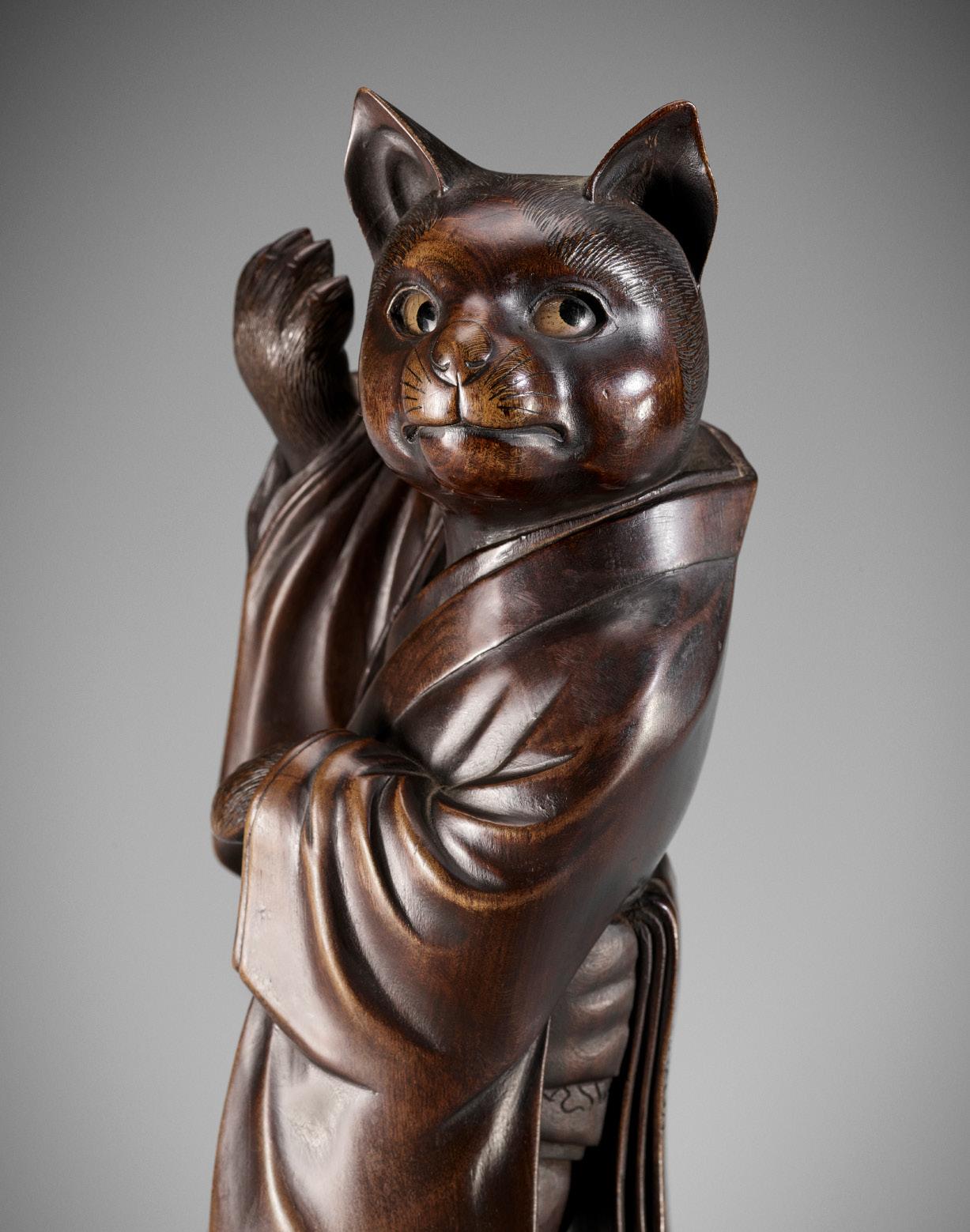
265
168
SUKENOBU: A MASTERFUL WOOD OKIMONO OF A TOAD AND SNAKE


By Sukenobu, signed Sukenobu (Ryosho) Japan, Takayama, Hida province, late 19th century, Meiji period (1868-1912)
Intricately and realistically carved as a toad attempting to fend off a snake which has encircled it threateningly, one of the toad’s eyes squinting under the pressure of the snake’s tail wrapped around its head, the serpent with the mouth wide open and split tongue stretched out, the scales neatly rendered, the toad detailed with masterful ukibori, both animals’ eyes double-inlaid with dark and translucent horn, the toad’s underbelly signed SUKENOBU within a rectangular reserve.

LENGTH 17 cm
Condition: Very good condition with minor wear, few minor age cracks, occasional light scratches.
With an associated black and gold-lacquered wood stand supported on four feet and decorated with butterflies as well as floral and foliate designs, dating from the same period.
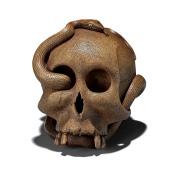
The present okimono alludes to the story of Jiraiya (lit. ‘Young Thunder’), the toad-riding protagonist of the Japanese folk tale Katakiuchi Kidan Jiraiya Monogatari. The tale was originally a Yomihon that was published in 1806-1807 and was adapted into a serialized novel that was written by different authors and published in 43 installments from 1839 to 1868; one of its illustrators was woodblock artist Kunisada. Jiraiya was a ninja who used shapeshifting magic to transform into a giant toad. His arch nemesis is Yasagoro, a master of serpent magic.
AUCTION COMPARISON:
Compare a closely related wood okimono signed Sukekazu, also dated Meiji period, late 19th century, 14.5 cm wide, at Christie’s, 5 December 2017, London, lot 20 (sold for 10,625 GBP). Compare a related wood okimono of a snake and skull by Sukeyuki at Zacke, 28 October 2020, Vienna, lot 188 (sold for 17,696 EUR).
Estimate EUR 15,000 Starting price EUR 8,000
266


SUKEYUKI: A FINE WOOD OKIMONO OF A SNAKE WINDING THROUGH A ROCK
By Sukeyuki, signed Sentei Sukeyuki zo Japan, Hida province, Takayama, late 19th century, Meiji period (1868-1912)
Finely carved in openwork as a tall rock with scattered grasses, bamboo leaves, and reishi fungi, a sinuous serpent writhing through the holes in the rock, the eyes double inlaid with pale translucent and dark horn, the scaled body neatly incised, the rock’s porous texture detailed with fine stippling. Signed underneath Sentei SUKEYUKI zo [made by Sentei Sukeyuki].
HEIGHT 7.7 cm
Condition: Good condition with minor wear, few minuscule age cracks, the base with few tiny nicks and light scratches, one inlaid eye is replaced. Provenance: British collection.
MUSEUM COMPARISON: Compare a closely related wood okimono by Sukeyuki, 9.7 cm high, in the collection of the British Museum, purchased from Sydney Moss Ltd., registration number 1980,1016.2.



Auction comparison: Compare a related wood netsuke of a snake and skull by Sukeyuki, 3.5 cm high, at Zacke, Fine Netsuke & Sagemono, 16 April 2021, Vienna, lot 151 (sold for 17,696 EUR), and a related wood okimono of a snake and skull by Sukeyuki, 12 cm high, at Zacke, Fine Japanese Art, 28 October 2020, Vienna, lot 188 (sold for 17,696 EUR).
Estimate EUR 5,000 Starting price EUR 2,400
169
170
ITTOKUSAI: A BOXWOOD NETSUKE OKIMONO OF AN OWL WITH MOVABLE OWLETS
By Ittokusai, signed Ittokusai Japan, late 19th century
Finely carved, the bird seated on a creeper-clad trunk, the head slightly turned to the right, with a small movable wood owlet emerging from a hole in the branch below, the owl’s large round eyes double-inlaid in amber and dark horn, the plumage neatly detailed, the owlet with inlaid eyes. Signed ITTOKUSAI underneath.





HEIGHT 8.3 cm
Condition: Good condition, minor wear, one segment of the branch re-attached and with associated minor losses. Fine, dark patina.
Provenance: French private collection.
AUCTION COMPARISON:
Compare a related wood netsuke of an owl with movable owlets by Ikkyu, 19th century, at Zacke, Fine Netsuke & Sagemono, 22 April 2022, Vienna, lot 130 (sold for 5,056 EUR). Compare a related wood netsuke of an owl with movable owlets by Tou, in the style of Ikkyu, 19th century, Bonhams, The Julius and Arlette Katchen Collection of Fine Netsuke Part I, 8 November 2016, London, lot 145 (sold for 4,000 GBP).
Estimate EUR 3,000 Starting price EUR 1,500
269

171
DORAKU: A SUPERB WOOD OKIMONO OF THREE TURTLES
By Doraku, signed Doraku Japan, Osaka, late 19th century, Meiji period (1868-1912)
Well carved, the bottom turtle almost entirely enveloped in its carapace with only the head peeking out slightly, a second turtle clambering on its shell surmounted by a third. The turtles’ limbs and carapaces are minutely incised, their faces are finely rendered, and their eyes are double-inlaid with dark and translucent horn. Signed DORAKU to the underbelly of the bottom turtle.



HEIGHT 8.5 cm
Condition: Very good condition with minor wear and few minuscule chips to edges.
Estimate EUR 15,000
Starting price EUR 8,000
172
TADAKAZU: A FINE WOOD OKIMONO OF A TURTLE PILE

By Tadakazu (Chuichi), signed Tadakazu Japan, Osaka, late 19th century, Meiji period (1868-1912)
Comprising ten turtles of varying sizes, the largest on the ground in a recumbent pose forming the platform for its companions to surmount whilst the others clamber atop to form a pyramid, their eyes inlaid with dark horn, their carapaces neatly incised, and their skins textured with cross-hatched incision work. Signed to the largest turtle’s underbelly within a rectangular reserve TADAKAZU. The present okimono underlines why the artist became famous for this model.
HEIGHT 13.6 cm
Condition: Good condition with minor wear, the head of the topmost turtle has been reattached. Provenance: British collection.
AUCTION COMPARISON: Compare a closely related okimono by Tadakazu, also with ten turtles, 9 cm high, at Bonhams, Fine Japanese Art, 17 May 2012, London, lot 142 (sold for 6,875 GBP).

Estimate EUR 5,000 Starting price EUR 2,400

272
173
ITSUMIN: A FINE WOOD OKIMONO OF NUMEROUS RATS
By Hokyudo Itsumin, signed Itsumin Japan, Tokyo, Meiji period (1868-1912)
Carved as a remarkably dense and intricate pile of ten rats clambering on top of each other, their fur finely incised and long tails well-carved and curling around. All eyes are inlaid in dark horn. Signed underneath within an inlaid plaque ITSUMIN.


HEIGHT 14.7 cm
Condition: Very good condition, minor wear. Provenance: European collection.
Hokyudo Itsumin was a highly talented carver of netsuke and okimono who likely started his career in Nagoya, possibly as a pupil of Ittan, and later moved to Edo (Tokyo).
AUCTION COMPARISON: For a closely related wood okimono of numerous rats, in the style of Itsumin, measuring 6.7 cm, see Bonhams, Fine Japanese Art, 14 May 2015, London, lot 299 (sold for 3,125 GBP).
Estimate EUR 3,000 Starting price 1,500
273
174 KAJIKAWA: A GOLD-LACQUER FOUR-CASE INRO DEPICTING EBISU AND DAIKOKU


By a member of the Kajikawa family, signed Kajikawa saku Japan, 19th century
Of lenticular form, bearing a kinji ground, finely decorated in predominantly gold takamaki-e and hiramaki-e with inlays of ivory to depict to one side Ebisu standing in a dynamic pose beside a fishing rod and a large fish inside a basket, holding a fan, and to the other with Daikoku holding a drum and carrying his large sack, his mallet tucked into his belt, both lucky gods beneath a line of shimenawa amid thick clouds and with tama pearls strewn on the ground before them, the interiors of nashiji with gold fundame edges, the base signed KAJIKAWA saku [made by Kajikawa].
HEIGHT 8.5 cm
Condition: Very good condition with minor wear. Provenance: Dutch collection.
With a wood tomobako.
AUCTION COMPARISON:
For a closely related inro, signed Shibayama and Shokasai, see Lempertz, Asian Art, 7 December 2018, Cologne, lot 559 (sold for 2,750 EUR).
Estimate EUR 2,500 Starting price EUR 1,200
274
175
A RARE GOLD-LACQUERED IVORY FOUR-CASE INRO ENSEMBLE DEPICTING A PHEASANT AND PLOVERS AMID CHERRY BLOSSOMS
Japan, late 19th century, Meiji period (1868-1912)
Of rounded rectangular form, the ivory ground richly decorated with two kinji-ground panels lacquered in gold and red takamaki-e with kirikane and e-nashiji to depict a golden pheasant (kinkei) perched on a branch of a flowering cherry (sakura) tree to one side and two plovers (chidori) flying amid cherry blossoms to the other, the panels surrounded by an intricate design of leafy scrolling vines (karakusa) in gold takamaki-e, the globular ivory ojime similarly decorated with plovers amid leafy scrolling vines, the kagamibuta-style manju ivory netsuke with a gold-lacquered plate decorated with cherry blossoms.


HEIGHT 9.8 cm (the inro), DIAMETER 1.5 cm (the ojime) and 3.5 cm (the netsuke)
Condition: Very good condition with minor wear and few tiny losses to lacquer.
Provenance: Dutch collection.

With a black-lacquered storage box with gold-lacquered inscription.
AUCTION COMPARISON: Compare a related gold-lacquered ivory inro ensemble depicting pheasants and sparrows by Hara Yoyusai at Zacke, Fine Netsuke & Sagemono, 25 September 2020, Vienna, lot 279 (sold for 3,792 EUR).
Estimate EUR 3,000
Starting price EUR 1,500
275
176
BIHO: A LACQUER TWO-CASE INRO DEPICTING MOMOTARO WITH HIS ANIMAL COMPANIONS AND TREASURE



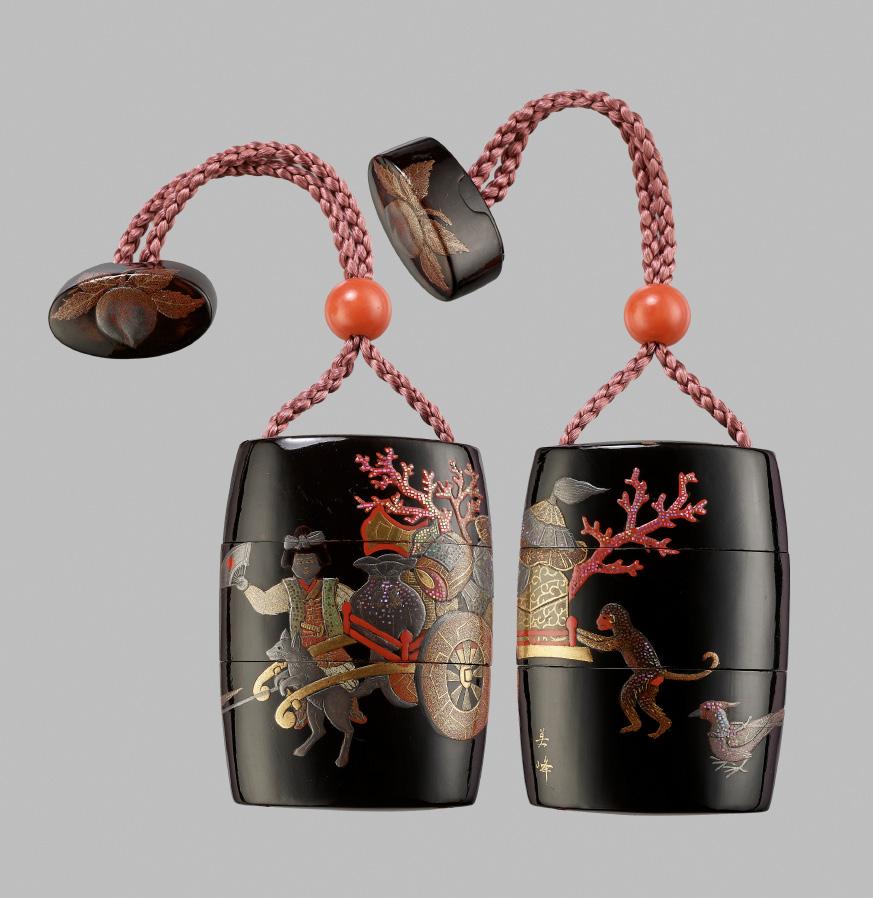
By Biho, signed Biho Japan, Meiji period (1868-1912)
Of rounded rectangular form, bearing a roiro ground richly decorated in iro-e takamaki-e with aogai and kirikane to depict Momotaro standing and holding a fan, as his animal companions move along their cart filled with numerous precious treasures including coral branches, a magic mallet, a large hat, and a chest, the dog and pheasant pulling the cart from the front while the monkey pushes it from behind. The interior of roiro with gold edges. The reverse with the goldlacquered signature BIHO.
HEIGHT 6.8 cm
Condition: Good condition with minor wear, few minuscule nicks, tiny losses to lacquer. Provenance: French private collection.
Estimate EUR 2,000 Starting price EUR 1,000
177
KAJIKAWA BUNRYUSAI: A THREE-CASE LACQUER INRO
By Kajikawa Bunryusai, signed Bunryusai with kakihan Japan, 18th century, Edo period (1615-1868)
Of rounded rectangular form, the roiro ground finely decorated in gold and silver takamaki-e and hiramaki-e with kirikane and e-nashiji to depict a dragon coiled amid waves inside a large antique bronze censer supported on a rocky outpost, the design continued onto the reverse with water lilies and reeds by a meandering stream, the interiors of nashiji with gold fundame edges, the base with the gold-lacquered signature BUNRUYSAI and redlacquered kakihan.
HEIGHT 7.1 cm
Condition: Good condition with some wear, few minor losses and tiny nibbles to lacquer. Provenance: German private collection.
MUSEUM COMPARISON: Compare a related inro by Kajikawa Bunryusai, dated ca. 1775-1850, 8.8 cm high, in the collection of the Victoria & Albert Museum, accession number W.431-1916.
Estimate EUR 1,500 Starting price EUR 800
276
Momotaro swinging the magic mallet (uchide no kozuchi), with his animal companions, by Santo Kyoden, 1804
178
A LACQUERED WOOD TWO-CASE INRO WITH CHRYSANTHEMUMS
Japan, 18th-19th century, Edo period (1615-1868)
Of ovoid form, the attractive wood grain heightened with translucent lacquer, decorated in gold, silver, and red takamaki-e with leafy chrysanthemum sprays to both sides, the interior showing the fine, dense wood grain.



HEIGHT 6.2 cm
Condition: Very good condition with minor wear and traces of use, expected minor age cracks.
Provenance: Deaccessioned from the Strong National Museum of Play.

Estimate EUR 1,000 Starting price EUR 500
The Strong National Museum of Play
179 JOSEN: AN INLAID AND LACQUERED WOOD SINGLE-CASE INRO DEPICTING LUNAR HARES
By Josen, signed Josen with kakihan Japan, 19th century, Edo period (1615-1868)
Of stylized moon form, the dark wood ground finely inlaid with a rabbit to either side, one in metal seated in a recumbent pose with gilt eyes and the other inlaid in darker wood seated on its haunches and looking up toward the sky, and decorated in gold hiramaki-e with grasses, the base incised with the signature JOSEN with a kakihan.
HEIGHT 5.5 cm
Condition: Good condition with some wear, small nicks, occasional light scratches, minor rubbing to lacquer. Provenance: British collection.
The design of the inro is very clever, its shape already hinting at the presence of the lunar hares depicted to either side. This popular motif originates in China, where the rabbit is often portrayed as a companion of the Moon goddess Chang’e, constantly pounding the elixir of life for her.
Estimate EUR 1,000 Starting price EUR 500
277
SHUOSAI: AN INLAID WOOD TONKOTSU DEPICTING MONKEYS AND PEACHES WITH EN-SUITE NETSUKE AND OJIME
By Shuosai, signed Shuosai Japan, late 19th century, Meiji period (1868-1912); the netsuke 18th century, Edo period (1615-1868)
Of beehive form, finely carved and with a troop of monkeys descending on a fruiting peach tree, some of the leaves and fruit inlaid in ivory, some of which are stained green, as well as amber and horn, the eyes double inlaid in pale and dark horn, the flat base signed SHUOSAI.
With a wood ojime in the form of a monkey hugging the cord, and an 18th-century wood netsuke carved as a seated monkey holding a giant chestnut, some of the details lacquered.

WIDTH 9 cm (the tonkotsu), HEIGHT 5.1 cm (the netsuke) and 2.4 cm (the ojime)

Condition: Very good condition, few minor age cracks, the netsuke and ojime with few minuscule nicks. Provenance: Dutch collection. The interior of the cover with an old Japanese label.
AUCTION COMPARISON: Compare a closely related boxwood tonkotsu, ojime and netsuke set, also signed Shuosai, sold at Bonhams, The Arno Ziesnitz Collection, 21 March 2018, New York, lot 1044 (sold for 4,375 USD).
Estimate EUR 3,000 Starting price EUR 1,500
278
180
181
KATSUYOSHI: AN UNUSUAL WOOD TONKOTSU WITH STAG ANTLER ONI FINIAL
By Katsuyoshi, signed Katsuyoshi Japan, first half of 20th century
Of stylized pouch form, each side with a dark wood panel carved in relief to one side with a shishi prancing above a kirin within a palace scene with blossoming branches, swirling clouds, pavilions, and a pagoda, continuing onto the reverse with further opulent palace structures. The cover surmounted by a superbly carved stag antler finial with a turning lock mechanism in the form of a fierce oni head, flanked by finely carved buffalo horn double-gourd-form cord runners, the narrow sides decorated with stag-antler-inlaid circular designs. The base inlaid with a gold plaque signed KATSUYOSHI.


WIDTH 10 cm
Condition: Very good condition with minor wear, few natural age cracks, few minor losses to inlays.
Provenance: Formerly from a noted German private collection, Munich.
The artist appears to be unrecorded, but clearly a talented individual who was versatile in many different materials.
Estimate EUR 3,000
Starting price EUR 1,500
279
A LARGE AND RARE STAG ANTLER YATATE (PORTABLE WRITING SET) WITH TSUKUMOGAMI SUMITSUBO
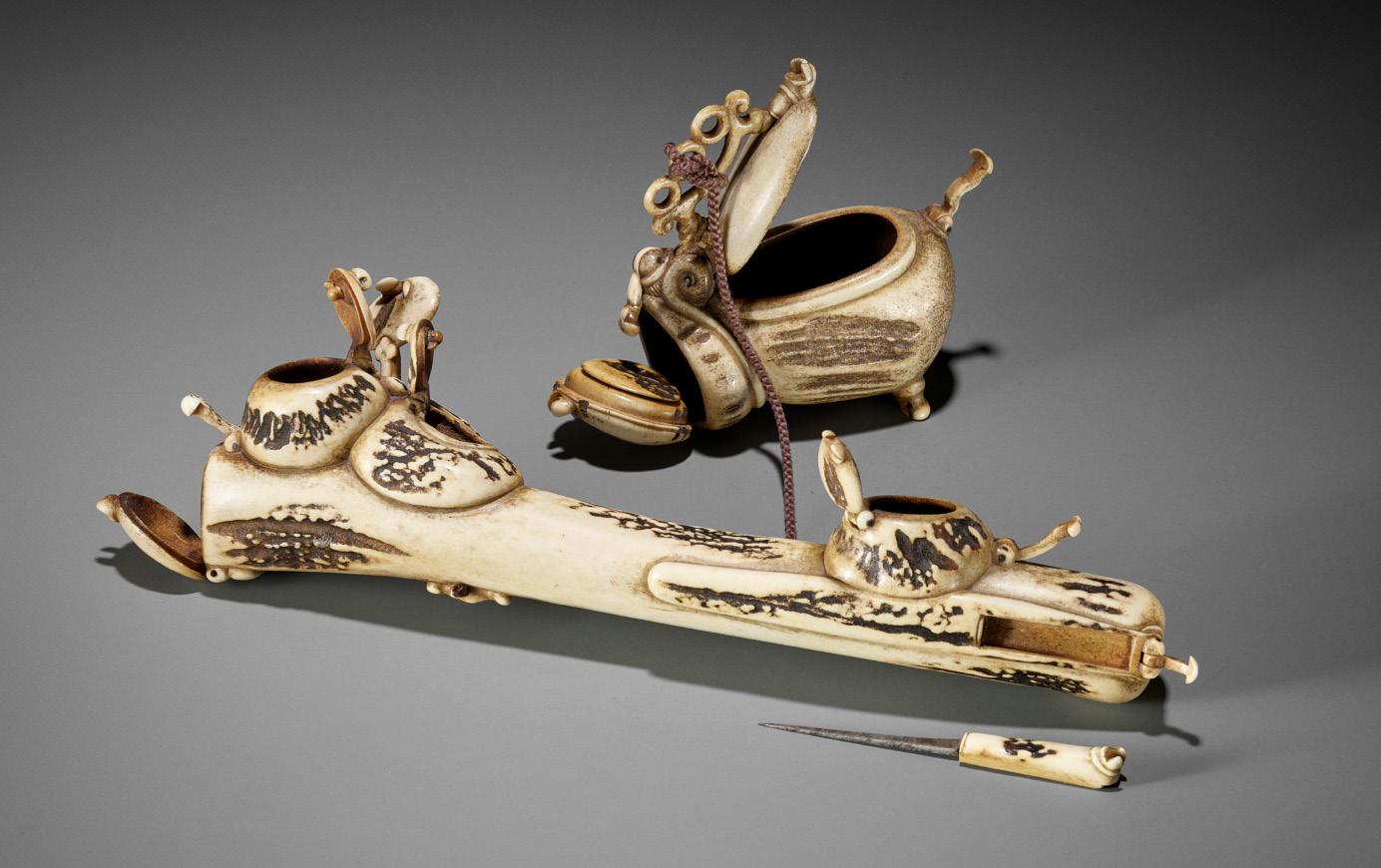

Unsigned Japan, Tokyo, Asakusa district, late 19th century
The yatate comprising a large fudezutsu (brush holder) and a container for ink (sumitsubo) or perhaps incense. The fudezutsu shaped as several pots for the tea ceremony, with one large and five smaller hinged compartments, cleverly utilizing the natural form of the material, one compartment carrying a small knife (kogatana). The sumitsubo in the form of a pot transformed into a two-legged mythical beast (tsukumogami) with inlaid eyes and openworked handle, and with two hinged compartments, the smaller one integrating a third compartment behind the lid.
LENGTH 25.5 cm (the fudezutsu), LENGTH 8.8 cm (the ink container)
Condition: Very good condition, minor wear, light surface scratches, few minuscule nibbles to exposed areas. Provenance: British collection.
Literature comparison: Compare a closely related stag antler yatate set, late 19th century, illustrated in Moss, Sydney L. (2016) Kokusai The Genius: and Stag-antler Carving in Japan, vol. III, p. 308-309, no. 521.
Tsukumogami are animate household objects. After a service life of nearly one hundred years, utsuwamono or kibutsu (containers, tools, and instruments) receive souls (kami).
Estimate EUR 2,500 Starting price EUR 1,200
182
A STAG ANTLER ‘LOTUS’ TONKOTSU
Unsigned Japan, Tokyo, Asakusa district, mid to late 19th
century
The stag antler tonkotsu carved as a lotus leaf with stem and bud, a large compartment at the center with hinged cover, the reverse featuring the stained and naturally dramatic texture of the material. The furled stem forming the cord attachment.

LENGTH 9.7 cm
Condition: Very good condition, minor wear. Provenance: British collection.
Literature comparison: Compare two related stag antler tonkotsu by Shoryu, mid to late 19th century, illustrated in Moss, Sydney L. (2016) Kokusai The Genius: and Stag-antler Carving in Japan, vol. III, p. 302-303, no. 518 and no. 519.
Estimate EUR 2,500 Starting price EUR 1,200
183
A STAG ANTLER KISERUZUTSU OF TENAGA FISHING
Unsigned Japan, Tokyo, Asakusa district, late 19th century
Of musozutsu form, finely carved in high relief with Tenaga perched on a rock trying to catch an octopus with his amusingly long arms. The cord attachment in the form of a pine branch.
LENGTH 21.5 cm
Condition: Very good condition, minor wear, few natural age cracks. Provenance: British private collection.
Tenaga and Ashinaga are yokai (spirits) in Japanese folklore which are often depicted together. The pair is commonly described as people from the “Long-legged Country”, and the “Long-armed Country”. As the names suggest, the inhabitants of these two countries possess unusually lengthy arms and legs.
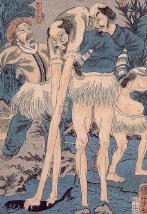
Estimate EUR 1,500
Starting price EUR 800
185 IKKO: A RARE BAMBOO FUDEZUTSU OF A MAGPIE ON PRUNUS
By Hasegawa Ikko, signed Ikko 一虎 with seal Japan, late 18th to early 19th century, Edo period (1615-1868)
The fudezutsu (brush case) carved in shishiaibori with a magpie perched on a blossoming prunus branch, its head raised upwards, the brush case with a metal mount, hinged cover, and wood end. Signed to the reverse IKKO and seal HASEGAWA.


LENGTH 28.6 cm
Condition: Very good condition, minor wear, light surface scratches, natural age cracks, a small rectangular piece inset to the narrow side.
Provenance: British private collection.
Hasegawa Ikko covered a wide range of subjects but excelled especially in his representation of animal and plant life. His style generally followed the traditions of early masters such as Korin and Ritsuo but was also influenced by his fellow craftsman Minko.
Estimate EUR 1,500 Starting price EUR 800
184
Ashinaga and Tenaga fishing, by Utagawa Kuniyoshi
186
HOGETSU NORITOMO: A FINE MIXED METAL AND BAMBOO KISERU (PIPE)
 By Hogetsu Noritomo, signed Hogetsu Noritomo (Jochi) 峯月乗知 Japan, Edo period (1615-1868)
By Hogetsu Noritomo, signed Hogetsu Noritomo (Jochi) 峯月乗知 Japan, Edo period (1615-1868)

The shibuichi fittings decorated in gilt and silver with a majestic dragon, cherry blossoms, and the full moon, connected by a bamboo segment, the mouthpiece and bowl in gilt. Signed in gold zogan HOGETSU NORITOMO.
LENGTH 21.4 cm WEIGHT 73.7 g
Condition: Very good condition with minor surface wear. Provenance: British private collection.
Hogetsu Noritomo, active in the mid-Edo period, is listed in Wakayama Takeshi, Toso Kinko Jiten, p. 309. Hogetsu Noritomo, also known as Omori Noritomo, with the original surname Akashio, was granted the right to use Omori as a family name. He was a samurai retainer at the Ueda domain in Shinshu, today’s Nagano prefecture. He studied in Edo under Nara Joi, one of the three metal master smiths of the Nara School in metal crafting, and later under Omori Hidetomo.
Estimate EUR 1,000 Starting price EUR 500
187

A RARE SILVER YATATE IN THE FORM OF GAGAKU INSTRUMENTS
Japan, 19th century
Of ladle type, the fudezutsu (brush holder) in the form of a transverse flute with seven smaller and one larger hole divided by incised parallel lines, the sumitsubo (inkwell) in the form of a drum, tied with silver wire, both sharing the hinged lid with handle in the form of a drum beater.
LENGTH 18.2 cm
Condition: Very good condition with minor wear and little tarnish to silver.
Provenance: The Strong National Museum of Play, accession number 75.5397 (lacquered to base of inkwell). Margaret Woodbury Strong (1897-1969) grew up in a prosperous family of collectors. Her interests ranged so widely that by 1960 she had amassed more than 27,000 collectible items and works of art. The vast majority of her collections related in some way to play and as her accumulation

grew, Margaret planned a museum to house her collection. It eventually opened to the public in 1982, and grew dramatically over the following decades, expanding its collections, facilities, and resources, now spanning over 285,000 square feet. Today, the Strong National Museum of Play (known as just The Strong Museum or simply The Strong) is the only collections-based museum in the world devoted solely to the study of play.
Gagaku (lit. ‘elegant music’) is a type of Japanese classical music that was historically used for imperial court music and dances. Gagaku was developed as court music of the Kyoto Imperial Palace, and its near-current form was established in the Heian period (7941185) around the 10th century. Today, it is performed by the Board of Ceremonies in the Tokyo Imperial Palace.
AUCTION COMPARISON: Compare a related silver yatate set sold at Bonhams, Fine Japanese Art, 17 May 2018, London, lot 143 (sold for 3,750 GBP).
Estimate EUR 1,000 Starting price EUR 500
188
KINJO: A GOLD INLAID COPPER KISERUZUTSU WITH TIGER AND DRAGON
By Ikeda Kinjo, signed Kinjo 琴乘 Japan, c. 1860
The pipe case of otoshi-zutsu type with subtle curvature, the design finely executed in katakiri and kebori with a tiger resting under towering stalks of leafy bamboo to one side and a dragon amid swirling clouds and crashing waves to the reverse, their eyes inlaid in gold. The cord attachment in the form of a flower head, signed KINJO to the side.

LENGTH 17.7 cm
Condition: Good condition, minor wear, few small dents, light surface scratches, one gold inlay to the tiger’s eye lost.
Provenance: The Strong National Museum of Play. Margaret Woodbury Strong (1897-1969) grew up in a prosperous family of collectors. Her interests ranged so widely that by 1960 she had amassed more than 27,000 collectible items and works of art. The vast majority of her collections related in some way to play and as her accumulation grew, Margaret planned a museum to house her collection. It eventually opened to the public in 1982, and grew dramatically over the following decades, expanding its collections, facilities, and resources, now spanning over 285,000 square feet. Today, the Strong National Museum of Play (known as just The Strong Museum or simply The Strong) is the only collections-based museum in the world devoted solely to the study of play.
Ikeda Kinjo, born in Tsuruoka, moved to Edo to study metal engraving from Ikkin Funada. He then returned to Tsuruoka and began making props for sword fittings, specializing in Ikkin style katakiri carvings.
Both the tiger and dragon have important meanings in Buddhist and Taoist philosophy, together representing the yin and yang, the earth and sky, or the male and female. Furthermore, they represent strength, resilience, and courage.
Estimate EUR 1,000 Starting price EUR 500
189
A FINE SHIBUICHI ‘TAKE NI TORA’ MANJU
Unsigned Japan, 19th century, Edo period (1615-1868)
The shibuichi manju decorated in the front in very fine katakiri and ke-bori with a tiger crouching behind bamboo. The reverse with a cord attachment as a metal loop in silver.

DIAMETER 3.8 cm
Condition: Very good condition, minor wear, few small nicks, and light surface scratches.
Provenance: European collection.
This motif is called take ni tora, “tiger in bamboo”. There are many different interpretations; the tiger has a strong nature, is flexible and resilient like the bamboo, but it is also said that the strong tiger is looking for shelter underneath the bamboo, as any earthly power is inferior to the forces of nature. Moreover, the tiger and bamboo represent the power of faith in Buddhism.
Estimate EUR 1,000
Starting price EUR 500
284
190
A GOOD KYOTO SCHOOL IVORY NETSUKE OF A TIGER
Unsigned Japan, Kyoto, early 19th century, Edo period (1615-1868)
A compact ivory netsuke of a tiger, with its head tilted backwards and left hindleg raised, capturing the moment before the tiger scratches himself. The bold and expressive eyebrows, the manner of fur coat, as well as the individual charm and expression of the piece allow for an attribution to the Okatomo school. The tiger, or tora, is the third animal of the zodiac and a symbol of resilience and strength. Good, generously excavated himotoshi underneath.


HEIGHT 4.1 cm
Condition: Very good condition, minor expected age cracks, very good patina. Provenance: European private collection.
Estimate EUR 3,000 Starting price EUR 1,500
285
191
A RARE IVORY ‘SILK SEAL’ TYPE NETSUKE OF A FOREIGNER
Unsigned Japan, late 17th to early 18th century, Edo period (1615-1868)
Published: Sydney L. Moss Ltd. (2016) Kokusai the Genius: and Stag-antler Carving in Japan, vol. I, p. 119120, no. 10.
Carved as a foreigner, decorated with a finely incised collar and elaborate ruff, the face with a grotesque, grim expression. Three large himotoshi for the cord attachment.
HEIGHT 3.8 cm
Condition: Very good condition, minor wear, few natural age cracks. Deep honey-yellow patina. Provenance: German private collection, ex-collection June Schuerch (1930-2009).
The preferred material for this type of netsuke was stag antler. Ivory silk-seal netsuke are very rare.
AUCTION COMPARISON: Compare a related stag antler silk seal netsuke, 17th-18th century, at Christie’s, Japanese Art & Design, 4 November 2009, London, lot 102 (sold for 1,500 GBP).
Estimate EUR 1,000 Starting price EUR 500
192
YOSHITOMO: A FINE IVORY NETSUKE OF HOTEI AND KARAKO




By Yoshitomo, signed Yoshitomo 吉友 Japan, Kyoto, late 18th century, Edo period (1615-1868)
Smiling and facing ahead, supporting a karako (Chinese boy) on his back, his loose robe belted at the waist, baring his chest and distended stomach, holding a fan in his right hand, the ears with long pendulous lobes, the himotoshi well integrated to the design, signed to the back YOSHITOMO in an oval reserve.
HEIGHT 5.8 cm
Condition: Good condition, appealingly worn, few natural age cracks, the feet restored. Fine honey-yellow patina.
Provenance: German private collection.
AUCTION COMPARISON: Compare a closely related ivory netsuke of Hotei by Yoshitomo, at Christie’s, An Important European Collection of Netsuke, 14 November 2001, London, lot 68 (sold for 10,575 GBP).
Estimate EUR 1,500 Starting price EUR 800
286
193
A CHARMING IVORY NETSUKE OF HOTEI WITH PUPPY

Unsigned Japan, early 18th century, Edo period (1615-1868)
Depicting Hotei seated, leaning on his treasure bag, his face with a content expression, the other hand resting on the knee, his loose robe belted at the waist, baring his chest and distended stomach, a small puppy clambering on his leg. Large himotoshi through the bag.
LENGTH 3.9 cm
Condition: Very good condition, minor wear, few natural age cracks. Fine honey-yellow patina.
Provenance: German private collection.
Estimate EUR 1,000 Starting price EUR 500
194

A CHARMING IVORY NETSUKE OF A SLEEPING TEMPLE SERVANT (EJI)
Unsigned Japan, 18th century, Edo period (1615-1868)
The temple servant (eji) taking a break, resting his head on the right hand while holding a parasol in his left hand, his face with an intensely tired expression. Deep himotoshi through the back and underside.
HEIGHT 3.9 cm
Condition: Very good condition, minor wear, few natural age cracks. Fine honey-yellow, unctuous patina.
Provenance: German private collection.
Estimate EUR 1,000 Starting price EUR 500
287
195

MINKOKU: A FINE IVORY NETSUKE OF TWO WOMEN WITH AN INFANT




By Genryosai Minkoku, signed Minkoku 民谷 Japan, Edo (Tokyo), early 19th century, Edo period (1615-1868)
Published: Zacke (1988), Ausstellung Marcel Lorber (1900-1986). 3.Teil: Japanische Netsuke aus seinem Nachlass, no. 17.
Finely carved and attractively stained deep-yellow, depicting a mother resting on top of a mortar and breastfeeding her young infant, a woman next to her holding a large pestle and grabbing the child’s arm. The expressions are superbly detailed, crafted in the typical manner of the artist. The women’s garments are elaborately carved and embellished with scrolling foliage and butterflies. Natural himotoshi and signed underneath the mortar MINKOKU within a rectangular reserve. The slightly worn ivory bearing a beautiful patina.
HEIGHT 4.6 cm
Condition: Very good condition, minor wear, few age cracks.
Provenance: Ex-collection Marcel Lorber (1900-1986), sold at Zacke in 1988. Excollection Teddy Hahn, Darmstadt.
LITERATURE COMPARISON:
For a discussion of the artist see Rimondi, Giovanni (Fall 2017) Genryosai Minkoku, an Early Edo Netsukeshi, Part 2, International Netsuke Society Journal, vol. 37, no. 3, pp. 3039. Compare to two closely related netsuke, one in wood and one in ivory, see fig.14 & 15.
Estimate EUR 2,000 Starting price EUR 1,000
288
Marcel Lorber (1900-1986)
196
MASATSUGU: A GOOD IVORY NETSUKE OF TWO WARRIORS




School of Kaigyokusai Masatsugu (1813-1892), signed Masatsugu 正次 Japan, Osaka, mid to late 19th century
Depicting a dynamic scene of a warrior, most likely Rinchu from the water margin, overwhelming his enemy, his foot holding the foe down while he draws his sword, his face with a fierce expression. His squirming enemy is toppled over on the ground, arms flailing, his expression marked by fear. The robes of the two are finely carved and stained with stippled details. ‘Chimney himotoshi’ through the back and underneath, the minutely incised signature MASATSUGU within an oval reserve.
HEIGHT 4.6 cm
Condition: Some old repairs and restorations to the sword and hand of the toppled foe. Otherwise, good condition with minor wear. Presents well.

Provenance: Collection Gabor Orszagh, Budapest, Hungary.
MUSEUM COMPARISON:
Compare a related Okimono of Watanabe no Tsuna by Kaigokudo Masatsugu, 19th century, in the Victoria and Albert Museum, accession number A.803-1910.
Rinchu (Chinese: Lin Chong) is a fictional character in Water Margin, one of the Four Great Classical Novels in Chinese literature.
Nicknamed ‘Panther Head’, he ranks sixth among the 36 Heavenly Spirits, the first third of the 108 Stars of Destiny.
Estimate EUR 3,000
Starting price EUR 1,500
c. 1830
289
Woodblock print by Utagawa Kuniyosh depicting Rinshu felling an enemy,
197 A GOOD WOOD NETSUKE OF A DUTCHMAN WITH CHILD
Unsigned Japan, 18th century, Edo period (1615-1868)
Typically depicted with shoulder-length, curling hair and exaggerated features, clad in a coat of finely detailed texture with a pleated collar, carrying a boy on his back and a trumpet in his right hand. The expression of each is very finely crafted, the eyes with minutely carved pupils. The wood bearing a fine patina, large himotoshi through the back.
HEIGHT 6.7 cm
Condition: Very good condition, appealingly worn, with minor surface wear, few natural age cracks. Fine, naturally grown, dark patina.
Provenance: European collection.
In the Edo period, Dutch merchants were the only Europeans admitted to Japan, where they were confined to the island of Deshima. Netsuke representing foreigners were popular in this period, and a number of examples in ivory are in museum collections, including the Metropolitan Museum of New York (no. 10.211.1506) and the British Museum (F.558). Interestingly, the lapa (trumpet) in this Dutchman’s hand is also foreign, being of Chinese origin.

AUCTION COMPARISON:

Compare to a closely related wood netsuke of a Dutchman with child, sold at Zacke, Fine Netsuke & Sagemono, 29 October 2021, Vienna, lot 4 (sold for 3,286 EUR).

Compare a closely related wood netsuke of a Dutchman with child, sold at Zacke, Fine Netsuke & Sagemono, 22 April 2022, Vienna, lot 17 (sold for 3,034 EUR).
Estimate EUR 2,500
Starting price EUR 1,200
290
198
ENSAI: A VERY RARE WOOD NETSUKE OF TSURU SENNIN
By Ensai, signed Ensai 宴齋 Japan, 19th century
Finely carved as the ‘crane sennin’ standing and holding a basket in one hand and crane’s feet in the other hand, dressed in a long flowing robe with a leafy apron and vest. Small himotoshi through the back, signed ENSAI.
HEIGHT 4.9 cm
Condition: Very good condition, minor wear. Provenance: European collection.
Works by this artist are extremely rare, only three other figural examples appear to be recorded: one of Rokusuke and Kappa, sold at Sotheby’s, 10 June 1977, lot 73. The second one depicts Tamamo no Mae, formerly in the W.L. Behrens Collection, no.477, illustrated in George Lazarnick, Netsuke and Inro Artists and How to Read Their Signatures, p.365.
Auction comparison: The third known netsuke by this rare artist was sold at Sotheby’s, The Katchen Collection of Netsuke Part II, 13 July 2006, London, lot 319 (sold for 4,800 GBP).

Estimate EUR 4,000 Starting price EUR 2,000

199 ROKKO: A FINE WOOD NETSUKE OF JUROJIN
By Rokko, signed Rokko 六甲 Japan, Edo/Tokyo, mid to late 19th century
Jurojin standing, dressed in loose robes with voluminous sleeves, a reishi scepter and hyotan (double gourd) tied to his waist, holding an uchiwa in his right hand, the face with a joyful expression. The details are superbly carved and stained dark for effect. The cord attachment goes through underneath the hyotan.
HEIGHT 4.9 cm
Condition: Very good condition, minor wear. Fine, smooth polish.
Provenance: British private collection.
Auction comparison: A closely related wood okimono depicting Ebisu by Rokko was sold at Zacke, Fine Netsuke, Sagemono & Okimono, 2 June 2018, Vienna, lot 84 (sold for 4,297 EUR).
Estimate EUR 1,500 Starting price EUR 800
291
200
A GOOD STAG ANTLER NETSUKE OF KAN’U

Unsigned Japan, 19th century, Edo period (1615-1868)
Standing wearing a coat with voluminous folds, the hem sweeping to one side, following the natural curvature of the material, secured with a belt, a sword attached to it, with neatly incised armor underneath, his right hand lowered and holding his halberd, the left hand at his waist, the face with a finely carved, determined expression and eyes inlaid with dark horn. The back with two himotoshi.
HEIGHT 8.3 cm
Condition: Very good condition, minor surface wear, some natural flaws to the material.
Provenance: Collection Gabor Orszagh, Budapest, Hungary.
AUCTION COMPARISON:
Compare to a closely related stag antler netsuke of Kan’u, attributed to Tomohisa and of earlier date, sold at Zacke, Fine Netsuke & Sagemono, 16 April 2021, Vienna, lot 257 (sold for 5,056 EUR).


Estimate EUR 4,000
Starting price EUR 2,000
292
201 A FINE STAG ANTLER NETSUKE OF KAN’U


Unsigned Japan, 19th century
The god of war standing, holding his halberd in the right hand and stroking his beard pensively, his armor and robe engraved in very fine detail with mail and floral medallions above stylized waves. The hat with a plug shaped as a rosette inlaid with dark horn. Good, asymmetrical himotoshi to the back.
HEIGHT 6.2 cm
Condition: Very good condition, minor wear. Provenance: European collection.
Estimate EUR 4,000 Starting price EUR 2,000
293
AN IVORY MASK NETSUKE OF AN ONI

Unsigned Japan, 18th century, Edo period (1615-1868)
Finely carved as an oni with fierce expression framed by prominent curls to the hair and beard, the mouth agape showing tongue and sharp fangs, the two stubby horns visible at the top. The ivory bearing a superb patina, particularly to the back which is smoothed and honey-yellow. Himotoshi through the horizontal bar in the back. A pleasingly tactile, old ivory netsuke.
HEIGHT 3.5 cm
Condition: Very good condition with many age cracks and a fine, deep patina. Provenance: European collection P. Jacquesson, purchased from Limoges Encheres in March 2004.
Estimate EUR 1,500
Starting price EUR 800

203 RYOICHI: A MARINE IVORY NETSUKE OF A NOH MASK, KO-OMOTE

By Ryoichi, signed Ryoichi 良一with kakihan Japan, Tokyo, late 19th century
The marine ivory finely carved and engraved to depict the face of a young woman with almond-shaped eyes and slender lips forming a subtle smile, stained in red, the reverse with a central himotoshi bar incised with a fan and signed RYOICHI with kakihan.
HEIGHT 3.5 cm
Condition: Excellent condition. Provenance: European collection.
Ko-omote (literally, “little mask”) conveys the beauty of a girl not yet twenty. A skilled actor can imbue an impassive expression with subtle emotion according to his movements; this is the prototype for more than twenty other masks for female roles, each varying subtly from the innocence of this mask to convey sensuous, passionate, demented, or supernatural characteristics.
LITERATURE COMPARISON: Compare a ko-omote mask dated to the 18th century in the collection of the Metropolitan Museum of Art, accession number 1993.341.1.
Estimate EUR 800 Starting price EUR 400
294
202
204
SHUZAN: A VERY FINE WOOD MASK NETSUKE OF KINTARO
 By Shuzan, signed Shuzan 舟山 Japan, Edo (Tokyo), mid-19th century
By Shuzan, signed Shuzan 舟山 Japan, Edo (Tokyo), mid-19th century
Finely carved as Kintaro, the face with a pronounced nose, two pierced eyes and a subtle smile below prominent cheeks, framed by delicately engraved hair. The reverse with a himotoshi bar signed SHUZAN. Superb, smooth polish.
HEIGHT 4.3 cm
Condition: Excellent condition, minor wear. Provenance: Ex-collection Richard R. Silverman. Richard R. Silverman (1932-2019) was a renowned Asian art collector with one of the largest private collections of netsuke outside of Japan. He lived in Tokyo between 1964 and 1979 and began to collect netsuke there in 1968. Since the 1970s, he wrote and lectured about netsuke and was an Asian art consultant for Christie’s,
Sotheby’s, and Bonhams. His gift of 226 ceramic netsuke to the Toledo Museum of Art constitutes perhaps the largest public collection of these miniature clay sculptures in the world. After moving to California, Silverman became a member of the Far Eastern Art Council at the Los Angeles County Museum of Art in 1984. In 1993, he joined LACMA’s Executive Board. He served on the board of directors for the International Society of Appraisers from 1986 to 1994 and served nine years as chair for the City of West Hollywood Fine Arts Commission. Richard Silverman was posthumously awarded the Order of the Rising Sun for his decadeslong promotion of Japanese culture.
Kintaro (English: Golden Boy) is a hero from Japanese folklore. According to legend, he was raised by a mountain witch and possessed supernatural strength. Kintaro is a popular figure in Bunraku and Kabuki dramas. In Japanese custom, Kintaro dolls are set out on Boy’s Day in the hope that boys will become equally brave and strong.
Estimate EUR 1,500 Starting price EUR 800
295
205
KIGAI: A WOOD NETSUKE OF OKAME AT SETSUBUN
By Kigai, signed Kigai saku鬼外作 Japan, late 19th-early 20th century, Meiji period (1868-1912)
Finely carved as Okame seated in a wooden box carved to the exterior with a ‘luck’ sign, performing mamemaki (bean scattering), her face with a joyful expression, pointing at the desperate oni which is crawling under a large straw hat to hide from the beans. Ringed himotoshi underneath, signed KIGAI saku [made by Kigai].
LENGTH 3.3 cm
Condition: Very good condition, minor wear. Provenance: Collection Gabor Orszagh, Budapest, Hungary.
Estimate EUR 1,000 Starting price EUR 500
206 KOGYOKU: AN IVORY NETSUKE OF SHOKI AND ONI

By Kogyoku, signed Kogyoku 光玉 Japan, Edo (Tokyo), late 19th century, Meiji period (1868-1912)
Depicting the legendary demon queller Shoki leaning over a decorative stool to search for the oni hiding below, Shoki dressed in an elaborate robe, holding a sword, his face with a grim expression and glaring eyes. Natural himotoshi through the stool and a small himotoshi underneath, signed KOGYOKU within an oval reserve.
HEIGHT 4.1 cm
Condition: Very good condition, minor wear. Provenance: Collection Gabor Orszagh, Budapest, Hungary.
AUCTION COMPARISON: Compare a related wood netsuke of Shoki and oni by Kogyoku, 19th century, at Lempertz, Japan, India/ South-East Asia, Tibet/Nepal, China I&II, 6 December 2019, Cologne, lot 143 (sold for 1,984 EUR).

Estimate EUR 1,500 Starting price EUR 800

296
208 SEIUN: A RARE IVORY NETSUKE OF AN ONI AS SARUMAWASHI

By Seiun, signed Seiun 晴雲 Japan, Edo/Tokyo, mid to late 19th century
A humorous ivory netsuke of an oni posing as a monkey trainer, the face with a grim expression and up-turned eyes, dressed in an elaborately decorated robe, holding a drum and drumsticks, a staff with hoop attached to his robe, a small finely carved monkey glancing over his shoulder. Two asymmetrical himotoshi through the back, the signature finely incised at the pouch SEIUN.

HEIGHT 5.7 cm
Condition: Good condition, few small losses to the leash of the monkey, the staff reattached, few minor natural age cracks. Provenance: Collection Gabor Orszagh, Budapest, Hungary.
Estimate EUR 2,500 Starting price EUR 1,200
207
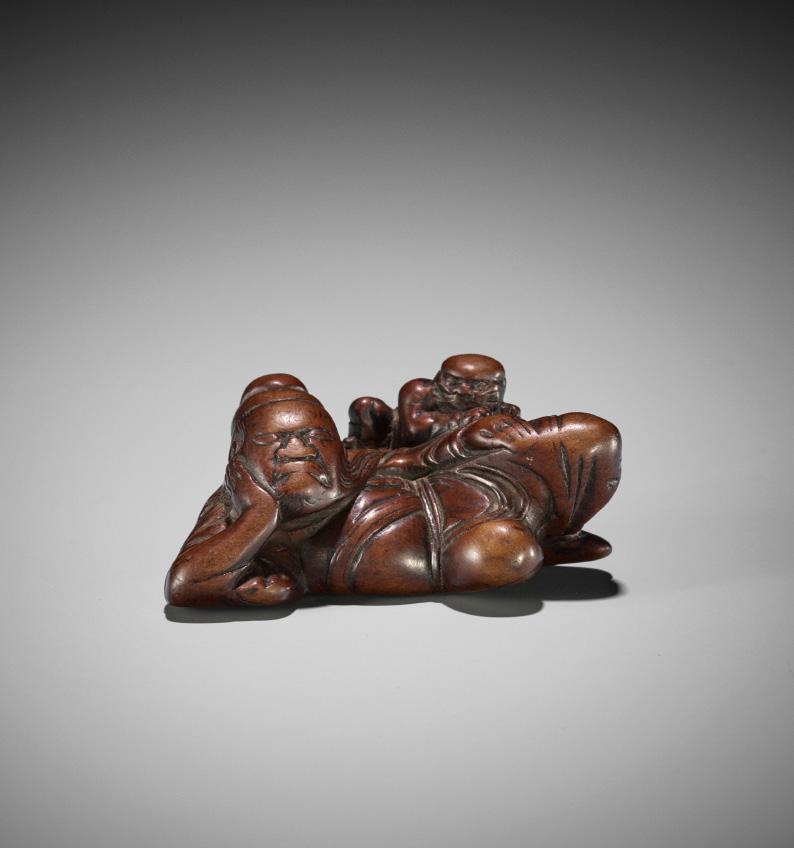
A RARE WOOD MITATE NETSUKE OF SHOKI AND ONI
Unsigned Japan, late 18th century, Edo period (1615-1868)
An amusing parody of the classic sleeping sarumawashi model, though this time it is an oni sneaking up on the sleeping demon queller. Shoki is shown fast asleep, though still as grim as ever, leaning on his right hand. Well hollowed himotoshi through the base. Beautiful, dark patina.
LENGTH 5.9 cm
Condition: Very good condition, appealingly worn with a fine patina.
Provenance: European collection.
AUCTION COMPARISON: Compare a related ivory mitate netsuke of shoki and oni, at Zacke, Fine Netsuke & Sagemono, 2 November 2019, Vienna, lot 187 (sold for 2,022 EUR).
Estimate EUR 2,000 Starting price EUR 1,000
297
209
A RARE IVORY NETSUKE OF AN ONI ON A KONGO (VAJRA)


Unsigned Japan, early 19th century, Edo period (1615-1868)

The mischievous little devil with amusing expression, climbing atop a four-pronged kongo (vajra), its spine, rib cage and muscular limbs neatly detailed. The lightly stained ivory bearing a fine patina. The underside with two oval himotoshi.
LENGTH 5.4 cm

Condition: Very good condition with minor surface wear and few associated natural age cracks.
Provenance: Collection Gabor Orszagh, Budapest, Hungary.
The design is illustrated in the Soken Kisho of 1781, the first publication on netsuke and their carvers.
LITERATURE COMPARISON: For a closely related ivory netsuke by Jugyoku see Ducros, Alain (1994) Netsuke & Sagemono, no. 32.
Estimate EUR 2,000 Starting price EUR 1,000
A sketch taken from the Soken Kisho
298
210
HIDEMASA: AN AMUSING IVORY NETSUKE OF SHOKI AND ONI

 By Hidemasa, signed Hidemasa 秀正 Japan, Osaka, mid-19th century, Edo period (1615-1868)
By Hidemasa, signed Hidemasa 秀正 Japan, Osaka, mid-19th century, Edo period (1615-1868)
The demon queller standing with one leg on a large kasa hat and piercing his sword through the surface, the obligatory oni hiding underneath straining to escape the blade. Shoki’s loosely fitted robe is finely stippled, embellished with various designs, and his long draping sleeves flow upwards dynamically. The individual expressions are achieved with humor, which is typical for the artist – Shoki looks determined, certain that he will have bested his foe, while the oni snarls mischievously. Natural himotoshi and signed underneath Shoki’s foot HIDEMASA. The finely stained ivory bearing a good patina.
HEIGHT 4.1 cm
Condition: Very good condition, few expected age cracks and associated minor surface wear.
Provenance: Collection Gabor Orszagh, Budapest, Hungary.
Estimate EUR 2,000 Starting price EUR 1,000
299
211
NANMUSAI: A RARE WOOD NETSUKE OF RAIJIN DISCHARGING A STORM



By Nanmusai, signed Nanmusai南無齋 Japan, 19th century, Edo period (1615-1868)
The thunder god kneeling over wispy clouds, wearing a large drum strapped to his back and surrounded by further finely carved clouds which he pulls out from a pouch-like bag, his squarejawed face is set in an expression of grim, somewhat doleful, determination. Natural himotoshi, the signature NANMUSAI within a raised oval reserve underneath.
HEIGHT 3.7 cm
Condition: Very good condition, minor wear. Fine, smooth patina. Provenance: Collection Gabor Orszagh, Budapest, Hungary.
The artist is rare, with only very few works recorded.
LITERATURE COMPARISON:
Compare a near-identical ivory netsuke of Raiden by Nanmusai, illustrated in Coullery, Marie-Therese and Newstead, Martin S. (1977) The Baur Collection, p. 61, no. C 19.
MUSEUM COMPARISON:
Compare a related wood netsuke of Raiden by Tomokazu, in the Ashmolean Museum, Oxford, accession number EA1956.1721.
Estimate EUR 2,000 Starting price EUR 1,000
300
212
JORYU: A FINE IVORY NETSUKE OF RAIJIN ENVELOPED IN CLOUDS

By Joryu, signed Joryu 如柳
Japan, Edo (Tokyo), early 19th century, Edo Period (1615-1868)
Finely carved in openwork, running over wispy clouds, Raijin swings his beater over his shoulder as he prepares to strike his thunder drum. The thunder god’s square-jawed face is set in an expression of grim, somewhat doleful, determination. He wears a loincloth, a hyotan issuing a swirl of clouds attached to his left arm, and his hair falls in curls at his neck. Signed underneath JORYU – a pupil of Jobun – on an oval reserve underneath, the himotoshi running through underneath it. The ivory bearing a deep-yellow patina.
HEIGHT 3.9 cm
Condition: Excellent condition, minor expected surface wear. Provenance: Collection Gabor Orszagh, Budapest, Hungary.
Raijin, also known as Raiden or Kaminari Sama, is the Japanese thunder god. Usually, he is depicted in red color with the face of a demon, two claws on each foot, and carrying a drum or wheel of drums.
Estimate EUR 2,000 Starting price EUR 1,000
301

213
A SUPERB WOOD NETSUKE OF A COILED DRAGON

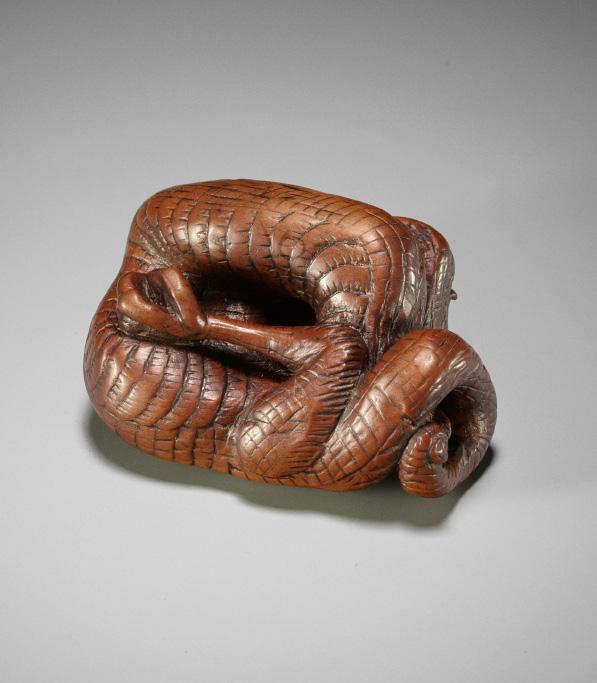

Unsigned Japan, probably Nagoya school, 18th century, Edo period (1615-1868)
Boldly carved, forming a compact composition, the sinuous body decorated with scales, the whiskers upturned, one claw grasping a tama, the eyes inlaid with translucent horn. Natural himotoshi through the sinuous body.
LENGTH 5.3 cm
Condition: Very good condition, appealingly worn. Fine, dark patina. Provenance: European collection.
AUCTION COMPARISON:
Compare a related wood netsuke of the four shijin by Tametaka, 18th century, at Bonhams, The Harriet Szechenyi Sale of Japanese Art, 8 November 2011, London, lot 62 (sold for 16,250 GBP).
Estimate EUR 6,000 Starting price EUR 3,000
303
214
A FINE WOOD NETSUKE OF A WOLF WITH HAUNCH OF VENISON

Unsigned Japan, probably Kyoto, late 18th to early 19th century, Edo period (1615-1868)
Finely carved as an emaciated wolf in the style of Masatomo, yet much finer, with neatly incised spine and fur, large, pricked ears, the eyes inlaid in mother of pearl with dark horn pupils, its mouth opened snarling, the tail tucked underneath, guarding a haunch of venison under its front paw. Natural himotoshi through the legs.
LENGTH 5.7 cm
Condition: Excellent condition, minor surface wear. Fine patina. Provenance: USA private collection.
Estimate EUR 3,000 Starting price EUR 1,500
304
215
KAIGYOKU: A FINE WOOD NETSUKE OF AN EAGLE SNATCHING A MONKEY




After Kaigyokusai Masatsugu, signed Kaigyoku 懐玉 Japan, Osaka, late 19th century, Meiji period (1868-1912)
The eagle with boldly incised feathers and plumage, its head lowered pressing down its talons against a squirming monkey. The monkey in return screeches, its mouth opened with a wild expression, grasping the feathers of the eagle to protect the young monkey hiding next to it. Himotoshi underneath, signed KAIGYOKU.
HEIGHT 3.5 cm
Condition: Very good condition, minor wear.
Provenance: Collection Gabor Orszagh, Budapest, Hungary, acquired from Michael Strone.
Literature comparison: Compare a related ivory netsuke of an eagle snatching a monkey by Kaigyoku Masatsugu, illustrated in Meinertzhagen, Frederick / Lazarnick, George (1986) MCI, Part A, p. 291.
AUCTION COMPARISON: Compare a related wood netsuke of a family of chickens by Kaigyokusai or Kaigyokudo, late 19th century, at Bonhams, The Julius and Arlette Katchen Collection of Fine Netsuke Part III, 6 November 2018, London, lot 90 (sold for 5,500 GBP).
Estimate EUR 4,000 Starting price EUR 2,000
305
216
ITSUMIN: A WOOD OKIMONO NETSUKE OF A TANUKI STIRRING MISO IN A MORTAR




By Hokyudo Itsumin, signed Itsumin 逸民 to 刀 Japan, Tokyo, second half of 19th century, Meiji period (1868-1912)
Seated in front of the suribachi (mortar) with deep conical sides, stirring thick miso paste with a large pestle held in both hands, wearing a loose-fitting robe with wide sleeves and a cloth wrapped around the head. The tanuki’s bushy tail emerges from below. Natural himotoshi between the arms, pestle, and tail. Signed underneath ITSUMIN to [carved by Itsumin].
HEIGHT 4.8 cm
Condition: Very good condition with minor wear, few natural age cracks.
Provenance: Collection Gabor Orszagh, Budapest, Hungary.
Estimate EUR 2,000 Starting price EUR 1,000
217
ITTAN: A FINE NAGOYA SCHOOL WOOD NETSUKE OF AN ONI WITH MORTAR AND SKULL
By Ittan, signed Ittan 一旦 with kakihan Japan, Nagoya, first half of 19th century, Edo period (1615-1868)
The oni seated, dressed in a tiger skin loincloth, holding a mortar with his feet while grinding a human skull and bones with a long pestle. The face with a strenuous expression, the mouth agape, his eyes inlaid in dark horn. Natural himotoshi through the legs and arms, signed underneath within a raised oval reserve ITTAN with kakihan.
HEIGHT 3.8 cm
Condition: Very good condition, one inlay to the left eye missing.
Provenance: From the collection of Mike and Hiroko Dean, acquired at Sotheby’s, London, 14 November 2000, lot 150.
Neil Davey wrote on Ittan, “A fine artist, who worked entirely in wood, producing small models, chiefly of animals but occasionally of legendary figural subjects. His work is full of intricate details, the eyes being inlaid in dark horn and the himotoshi being formed by a natural gap in the form.” (Netsuke, 1974, p. 194).
AUCTION COMPARISON:
Compare
Estimate EUR 2,000
Starting price EUR 1,000
1,560 GBP).
306
to a closely related wood netsuke of a fox stirring miso, by Ittan, sold at Bonhams, Fine Japanese Art, 12 May 2009, London, lot 138 (sold for
218
ITSUMIN: A FINE WOOD NETSUKE OF A REPENTING ONI WITH MOKUGYO

By Hokyudo Itsumin, signed Itsumin 逸民 to刀 Japan, Edo (Tokyo), mid-19th century, Edo period (1615-1868)
The repenting oni seated, dressed in a tiger skin loin cloth and wearing a headdress, drumming with a mallet on the mokugyo laying in front of him, his face with a grim expression, the open mouth revealing a set of sharp fangs, and the bulging eyes inlaid in pale translucent horn with dark pupils. Note the superbly carved underside of the mokugyo which also houses the signature ITSUMIN to [carved by Itsumin]. Natural himotoshi, the well-toned wood bearing a fine, warm patina.

HEIGHT 4.7 cm
Condition: Very good condition, minor wear, one finger with a tiny chip to the edge.
Provenance: North German private collection, assembled before 1984.

LITERATURE COMPARISON:
Compare a closely related wood netsuke of an oni beating a mokugyo by Itsumin, illustrated in Meinertzhagen, Frederick / Lazarnick, George (1986) MCI, Part A, p. 247.
Auction comparison: A related wood okimono of monkeys, by Hokyudo Itsumin, was sold at Bonhams, Fine Japanese Art, 10 November 2011, London, lot 121 (sold for 5,000 GBP).
Estimate EUR 2,000 Starting price EUR 1,000
219
SHURAKU: A FINE WOOD NETSUKE OF A MONK WITH MOKUGYO

By Shuraku, signed Shuraku 舟樂with kakihan Japan, Edo, first half of 19th century, Edo period (1615-1868)
Finely carved and with detailed incision work, depicting a monk leaning on a mokugyo (temple bell), the bell with handles formed as confronting dragons sharing a tama in their mouths and superbly hollowed, the monk holding a drumstick, his face with a serene expression. Natural himotoshi through the mokugyo handle, signed SHURAKU with kakihan.
LENGTH 4.3 cm
Condition: Very good condition, minor wear.
Provenance: Collection Gabor Orszagh, Budapest, Hungary.
Estimate EUR 2,000 Starting price EUR 1,000
307
GYOKUSUI: A FINE TOKYO SCHOOL IVORY AND WOOD NETSUKE OF A PRIEST RESTING ON A MOKUGYO
By Gyokusui, signed Gyokusui 玉翠 Japan, Tokyo, late 19th century, Meiji period (1868-1912)
The priest leaning on a mokugyo, his left and right hand placed on his knee, wearing a loose-fitting monastic robe finely incised and inlaid with chrysanthemums and medallions above a very delicate ground of scrolls. The mokugyo carved from wood with inlays of green-stained antler and pale horn. Two asymmetrical and well-hollowed himotoshi through the base, signed GYOKUSUI upon a red-lacquered plaque underneath the mokugyo.
HEIGHT 3.2 cm, LENGTH 4.6 cm
Condition: Very good condition, minor wear, few natural age cracks. Provenance: Collection Gabor Orszagh, Budapest, Hungary.
Estimate EUR 2,000 Starting price EUR 1,000
221 KOKOKU: AN IVORY NETSUKE OF OKAME WITH MIRROR


By Kokoku, signed Kokoku 光谷 Japan, Tokyo, late 19th century, Meiji period (1868-1912)
Okame seated with her legs tucked under her body, a mirror in her right hand, her robe and eboshi inlaid with dark buffalo horn, patinated metal, mother-of-pearl, red lacquer, and finely incised and painted in sumi-e with scrolls and foliate designs. The mirror inlaid in mother-of-pearl, which cleverly reflects light on Okame’s face. Two asymmetrical himotoshi underneath and signed KOKOKU on a red-lacquered plaque.
HEIGHT 4.5 cm
Condition: Good condition, minor wear, the frame of the mirror with a repair.
Provenance: Collection Gabor Orszagh, Budapest, Hungary.
The present artist belonged to the Tokoku school and along with Egawa Sokoku excelled in the use of various different materials.
Estimate EUR 2,500 Starting price EUR 1,200
308
220
222
MUNETAME: A FINE IVORY NETSUKE OF A MAN DRINKING SAKE




By Munetame, signed Munetame with kakihan Japan, Tokyo, Meiji period (1868-1912)
Finely carved and stained, the drunkard seated with his legs crossed, the face with an amusingly inebriated expression, dressed in a finely stippled robe decorated with ginkgo leaves, a tabako-ire tied to his waist, holding in his left hand a sake cup, his right hand resting on the empty sake bottle. Himotoshi underneath, signed to the bottle MUNETAME with kakihan.
HEIGHT 3.3 cm
Condition: Very good condition. Minor wear.
Provenance: Collection Gabor Orszagh, Budapest, Hungary.
Estimate EUR 1,500 Starting price EUR 800
223 SHIZU: A FINE TOKYO SCHOOL IVORY NETSUKE OF HOTEI
By Shizu, signed Shizu (Sei) Japan, Tokyo, Meiji period (1868-1912)
Finely carved as Hotei seated, leaning on his left hand, the right hand resting on his knee, and wearing a finely stained and stippled, flowing robe opening at the chest, a nyoi-scepter tucked into his belt. His expression is, as always, cheerful with a joyous smile. Himotoshi underneath, signed in seal script SHIZU within a square, red-lacquered reserve.
HEIGHT 3.3 cm
Condition: Excellent condition, minor wear, some natural nerve channel plugs.
Provenance: Collection Gabor Orszagh, Budapest, Hungary.
Estimate EUR 1,500 Starting price EUR 800
309
YASUAKI: A FINE TOKYO SCHOOL IVORY NETSUKE OF HOTEI
 By
By
Yasuaki (Homei), signed Yasuaki 保明 with seal Kodama 見玉 Japan, Tokyo, Meiji period (1868-1912)
The lucky god seated, laughing jovially, his loosely fitted robe revealing his hairy chest and bulging stomach, the green-stained robe neatly incised with cloud patterns and embellished with various inlays, an inlaid wood reishi scepter fitted into his belt at the back. Signed underneath YASUAKI with gilt metal seal Kodama next to the two himotoshi which are ringed in dark horn.
HEIGHT 2.9 cm, LENGTH 3.4 cm
Condition: Excellent condition.
Provenance: Collection Gabor Orszagh, Budapest, Hungary.
AUCTION COMPARISON:

A closely related ivory netsuke of a seated Hotei by Yasuaki was sold at Lempertz, Netsuke and Sagemono incl. The Kolodotschko Collection V, 9 June 2017, Cologne, lot 622 (sold for 2,728 EUR).

Estimate EUR 2,000
Starting price EUR 1,000
310
224
225
YASUAKI: A FINE AND LARGE TOKYO SCHOOL IVORY NETSUKE OF HOTEI
By Yasuaki (Homei), signed Yasuaki 保明 with seal Kodama 見玉 Japan, Tokyo, Meiji period (1868-1912)
A larger than usual model of Hotei laughing jovially, his loosely fitted robe revealing his right shoulder, hairy chest, bulging stomach, as well as a green-stained cord tied into the fold of his belly, the pinkstained robe neatly incised with swirling patterns and embellished with various inlays depicting kamon, an inlaid tortoiseshell reishi scepter fitted into his mother-of-pearl belt at the back. The eyes are minutely inlaid in dark horn. Signed underneath YASUAKI with seal Kodama next to the two ringed himotoshi.
HEIGHT 3.6 cm, LENGTH 4.1 cm
Condition: Very good condition, minor wear.
Provenance: Collection Gabor Orszagh, Budapest, Hungary.
AUCTION COMPARISON:
A closely related ivory netsuke of a seated Hotei by Yasuaki was sold at Lempertz, The Kolodotschko Collection of Netsuke II, 6 December 2014, Cologne, lot 972 (sold for 3,720 EUR).


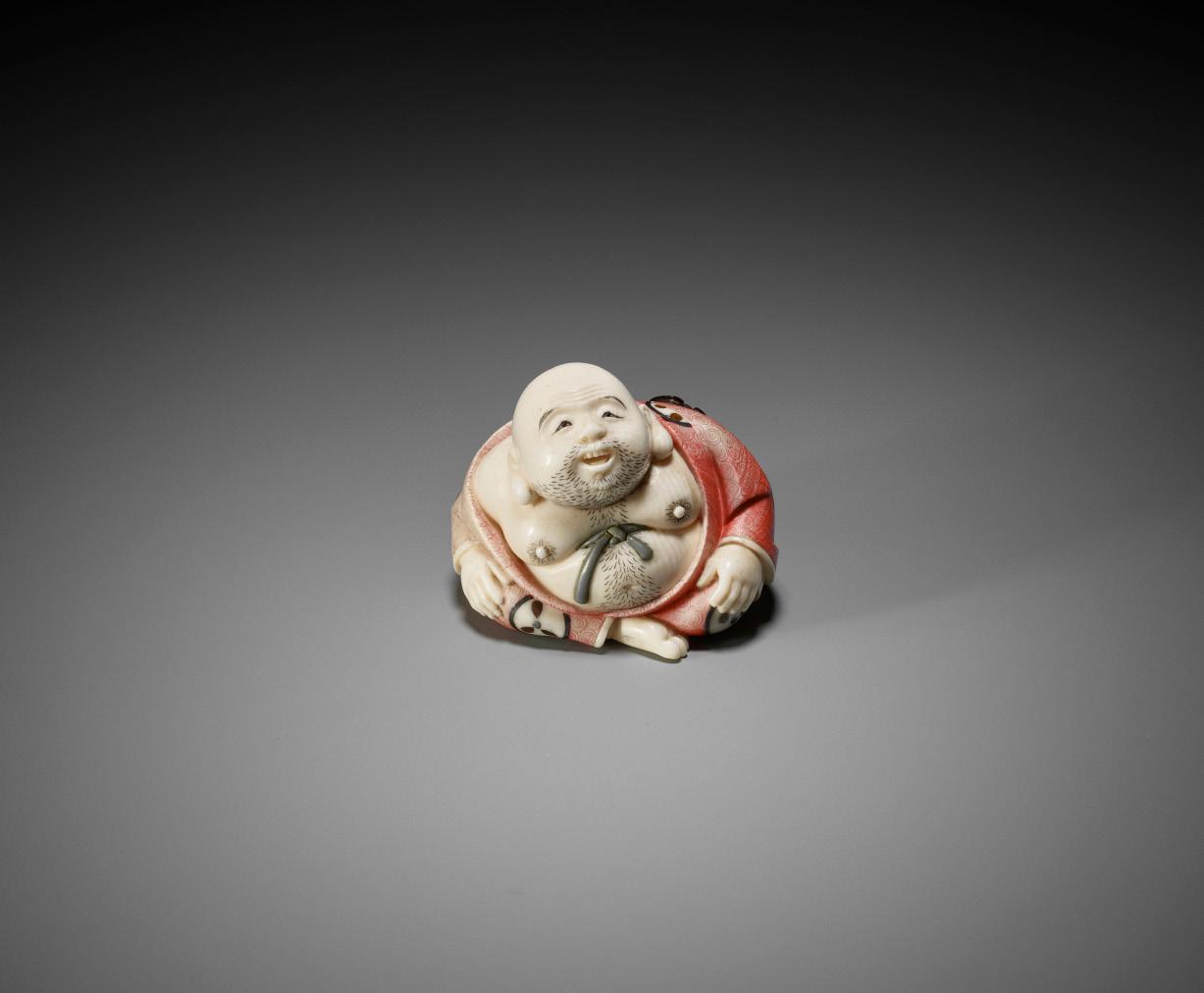
Estimate EUR 3,000
Starting price EUR 1,500
311
A LARGE WOOD NETSUKE OF A MOKUGYO, ATTRIBUTED TO GYOKUMIN

Attributed to Gyokumin, unsigned Japan, Tokyo, Asakusa district, late 19th century
Finely carved as a mokugyo (gong) the handles shaped as two confronting dragonfish heads sharing a tama (magical jewel) in their opened mouths, the scales and curling manes finely incised. The wood is superbly polished and the mokugyo makes an appropriate sound when struck. One side is carved with a neatly incised lotus medallion in the center, with two bonji characters in sunken relief against a circular reserve on either side. Natural himotoshi through the underside of the bell, however likely this was either an okimono or simply a miniature mokugyo.
HEIGHT 6.8 cm
Condition: Excellent condition with only very minor wear. Provenance: European collection.
Literature comparison: Compare to a related netsuke of a mokugyo with the same bonji character, saku, in Kokusai the Genius: and Stag-antler Carving in Japan’ vol. III, Sydney L. Moss, Ltd., 2016, no. 352.
Estimate EUR 2,000 Starting price EUR 1,000
312 226
227
KOKUSAI: A SUPERB STAG ANTLER OJIME OF A MOKUGYO
By Ozaki Kokusai (1835-1892), sealed Koku 谷 Japan, Shiba, Tokyo, c. 1860-1880
The ojime finely carved as a mokugyo (temple bell) formed as a dragon fish catching a tama in his mouth and tail, its curling mane and scales neatly incised. The bell decorated with two medallions enclosing lotus flowers and issuing vines. A round seal KOKU in sunken relief to one side.
HEIGHT 2.5 cm
Condition: Very good condition, minor wear, few natural age cracks. Provenance: European collection.
Estimate EUR 1,500 Starting price EUR 800
228 GYOKKO: A FINE IVORY OJIME OF THE SHICHIFUKUJIN
By Gyokko, signed Gyokko 玉光 Japan, Tokyo, 19th century
Of globular form, finely carved with the seven lucky gods floating above swirling clouds, their robes finely incised. The top with a metal collar in the form of a flower head, the bottom with a gilt rim. Signed in a raised, rectangular reserve GYOKKO.

HEIGHT 1.9 cm
Condition: Very good condition, appealingly worn. Fine patina.
Provenance: German private collection.

In Japanese mythology, the Seven Lucky Gods or Seven Gods of Fortune (shichifukujin) are believed to grant good luck and are often represented in netsuke and in other artworks.
Estimate EUR 1,000 Starting price EUR 500
313
229
RANTEI: A RARE AND FINE IVORY NETSUKE OF A CHRYSANTHEMUM
By Hogen Rantei, signed Rantei蘭亭 Japan, Kyoto, late 18th to early 19th century, Edo period (1615-1868)
Of domed form, finely carved as a blossoming chrysanthemum, the reverse with furled stem issuing leaves bearing simulated worm rot. Wellintegrated himotoshi through the stem and foliage, signed to the stem RANTEI within the typical oval reserve.
LENGTH 4.2 cm
Condition: Very good condition, minor wear. Fine honey-yellow patina. Provenance: German private collection.
Estimate EUR 1,500 Starting price EUR 800
230
KOGYOKU: A LARGE IVORY MANJU NETSUKE WITH PEONIES

By Kogyoku, signed Kogyoku 光玉 Japan, Edo (Tokyo), mid-19th century, Edo period (1615-1868)
The large manju of circular form, well carved in relief featuring a blossoming peony flower and bud on a rock, likely an allusion to a shishi, the reverse with two himotoshi and signed KOGYOKU.

DIAMETER 5.9 cm
Condition: Good condition, light surface scratches, natural age cracks, later incisions to the back. Fine honey-yellow patina.
Provenance: Collection Gabor Orszagh, Budapest, Hungary.
Estimate EUR 1,000 Starting price EUR 500
314
231
HOGYOKU: AN IVORY MANJU NETSUKE OF A NOH ACTOR AS HANNYA

By IkkeIsai Hogyoku, signed Ikkeisai Hogyoku一鶏齋 法玉 with kakihan Japan, Edo (Tokyo), mid-19th century, Edo period (1615-1868)
The two-part manju of circular form, well carved in shishiaibori (sunken relief) to one side depicting an actor in the role of Hannya, standing in a dynamic pose, the arms spread outwards, wearing formal attire, the head turned to the right and with flowing hair, details in red and black sumi, the reverse incised and inked with two peonies and signed HOGYOKU IKKEISAI with kakihan.
DIAMETER 4.4 cm
Condition: Very good condition, minor wear, few minuscule nibbles to the rims, few light surface scratches. Fine honey-yellow patina. Provenance: Collection Gabor Orszagh, Budapest, Hungary.
Literature comparison: Compare a related ivory manju netsuke depicting Tadamori by Ikkeisai Hogyoku, illustrated in Meinertzhagen, Frederick / Lazarnick, George (1986) MCI, Part A, p. 164.
Estimate EUR 1,000 Starting price EUR 500
232

YUKIMASA: AN IVORY NETSUKE OF AN AMA WITH OCTOPUS

By Yukimasa, signed Yukimasa 幸正 Japan, early 20th century
In the shape of a hamaguri clam, carved in the front in shisiaibori (sunken relief) with inked details depicting an ama (diving girl), bare-chested, pushing away an amorous octopus with its tentacles wriggling underneath her skirt. Her expression is quite ambiguous; although she is grabbing the octopus by its mouth and fighting off his approach, she seems to be enticed by its presence. Good himotoshi through the reverse and signed YUKIMASA. The ivory is lightly stained and finely polished.
LENGTH 4.8 cm
Condition: Very good condition, fine age cracks.
Provenance: German private collection, acquired in Japan c. 1980.
Estimate EUR 1,500 Starting price EUR 800
315
MICHAEL BIRCH: BEAR REFLECTED ON ICE
By Michael Henry Birch (1926-2008), signed with artist’s initials ‘MHB’ England, 2003
Published: Birch, JKL (2013) The Art & Life of Michael Birch, p. 112.
Carved from hippopotamus incisor, the eyes inlaid in black onyx. Depicting a stylized bear slipping on ice, its reflection visible beneath. Signed within a gold-inlaid tablet MHB. A remarkably clever and amusing composition.


LENGTH 6.1 cm
Condition: Excellent condition. Provenance: From the collection of Jonathan Birch, son of Michael Henry Birch.
Estimate EUR 2,000 Starting price EUR 1,000
316
233
234
MICHAEL BIRCH: PORTRAIT OF MY FATHER
By Michael Henry Birch (1926-2008), signed with artist’s initials ‘MHB’ England, 1994
Published: Birch, JKL (2013) The Art & Life of Michael Birch, p. 41. Exhibited & Illustrated: The Carvings of Michael Henry Birch, N.K.C. New York, 1995. Michael Birch Netsuke Carver and Sculptor, National College of Art & Design, Dublin 1997. Tactiles by Michael Henry Birch, I.N.S.C Boston, 2001.
The head of elongated pear shape, carved from hippopotamus incisor, the features finely detailed in an exaggerated manner with an aquiline nose, and smiling eyes below arched brows. The head inset in a wood stand of lobed form. Small himotoshi through the back and the signature ‘MHB’ within a gold-inlaid rectangular reserve.

HEIGHT 9.2 cm
Condition: Excellent condition with natural veining and age cracks. Provenance: From the collection of Jonathan Birch, son of Michael Henry Birch.

AUCTION COMPARISON: Compare a related netsuke of a samurai mask by Michael Birch, at Zacke, Fine Netsuke & Sagemono, 16 April 2021, Vienna, lot 251 (sold for 1,138 EUR).
Estimate EUR 1,500 Starting price EUR 800
235
MICHAEL
BIRCH: THE MAGIC WHIRLPOOL WITH YIN-YANG SYMBOL
By Michael Henry Birch (1926-2008), signed with artist’s initials ‘MHB’ England, 2000
Published: Birch, JKL (2013) The Art & Life of Michael Birch, p. 139. Exhibited & Illustrated: Netsuke Sculptures by Michael Henry Birch, I.N.S.C. Honolulu, 2004.
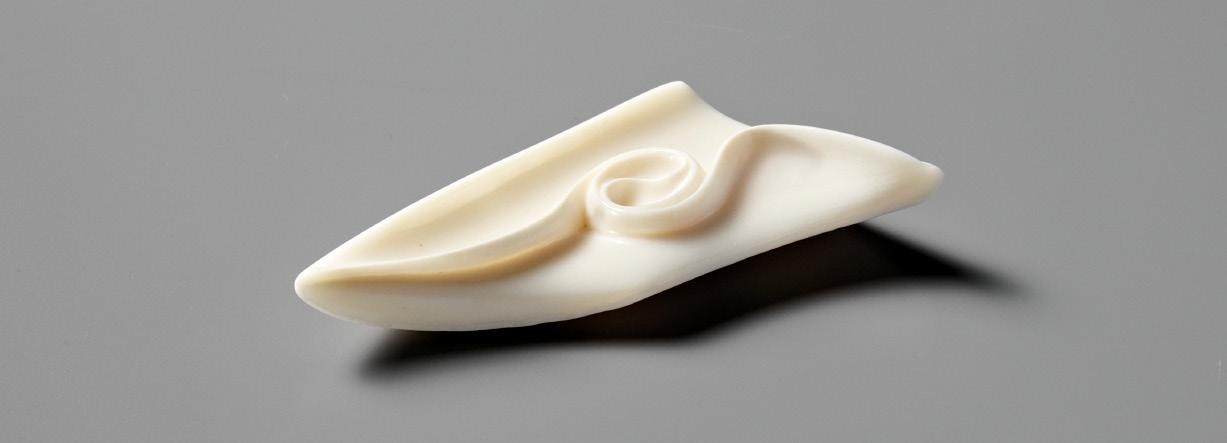
Carved from hippopotamus incisor following the organic shape of the material, one side with a wave-like ridge forming a yin-yang symbol at the center, the reverse left uncarved. Small himotoshi to one side, signed ‘MHB’ within a gold-inlaid rectangular reserve.
Janet Birch remarked the following: “When carving the […] pieces from the thin hollow end of the incisor, Michael left the crystal-hard enamel un-carved on the underside of each to denote the ripples on a sandy seabed beneath the waves”.
LENGTH 8.4 cm
Condition: Excellent condition.
Provenance: From the collection of Jonathan Birch, son of Michael Henry Birch.
Estimate EUR 1,500 Starting price EUR 800
317





















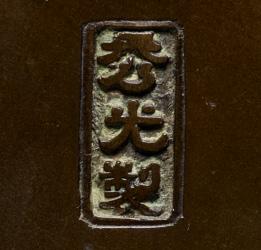



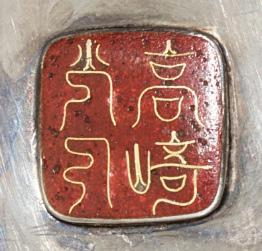






No. 12 No. 21 No. 24 No. 25 No. 32 No. 41 No. 42 No. 44 No. 52 No. 53 No. 57 No. 60 No. 61 No. 62 No. 59 No. 66 No. 68 No. 72 No. 73 No. 75 No. 77 No. 78 No. 79 No. 4 No. 54 ARTIST SIGNATURES No. 74 No. 30 No. 49 No. 58 No. 64








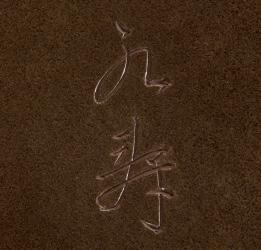













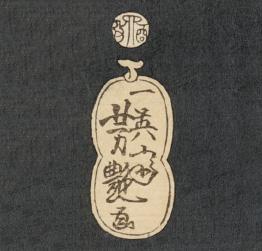








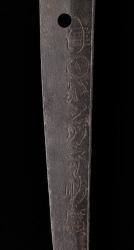
No. 81 No. 82 No. 84 No. 85 No. 87 No. 88 No. 89 No. 90 No. 97 No. 98 No. 100 No. 107 No. 108 No. 109 No. 102 No. 112 No. 118 No. 119 No. 120 No. 127 No. 132 No. 133 No. 134 No. 80 No. 99 No. 121 No. 94 No. 101 No. 111

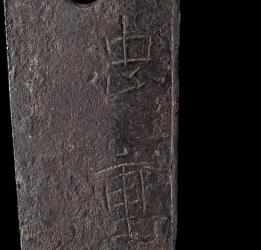



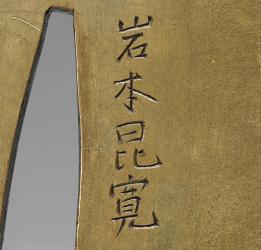

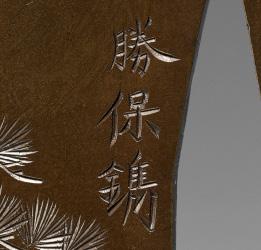



















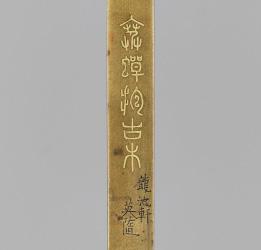



No. 137 No. 139 No. 141 No. 142 No. 144 No. 145 No. 146 No. 147 No. 151 No. 153 No. 155 No. 158 No. 159 No. 157 No. 162 No. 163 No. 169 No. 170 No. 172 No. 135 No. 154 ARTIST SIGNATURES No. 168 No. 143 No. 148 No. 156 No. 161








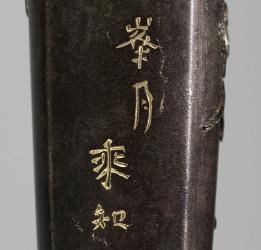



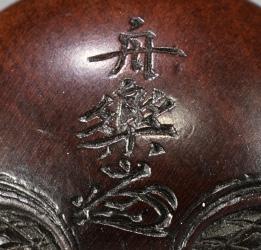








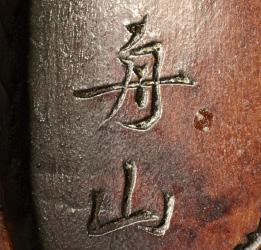








No. 174 No. 176 No. 177 No. 179 No. 181 No. 185 No. 186 No. 188 No. 195 No. 196 No. 199 No. 205 No. 206 No. 208 No. 204 No. 211 No. 212 No. 215 No. 216 No. 218 No. 219 No. 220 No. 221 No. 173 No. 198 No. 217 No. 180 No. 192 No. 203 No. 210













No. 223 No. 224 No. 225 No. 227 No. 229 No. 230 No. 231 No. 232 No. 234 No. 235 No. 222 ARTIST SIGNATURES No. 228 No. 233
§
§
1) The auction shall be carried out in accordance with the provisions of the rules of procedure of GALERIE ZACKE©, SZA VERSTEIGERUNGEN UND VERTRIEBS GMBH, Sterngasse 13, 1010 WIEN (hereinafter referred to as the company) as well as in accordance with sections 244-246 of the GEWERBEORDNUNG [Industrial Code] of 1994. The auction shall be carried out on commission. The auctioneer shall be entitled to withdraw lots exceptionally, to conduct the auction deviating from the order of the catalog numbers and to offer lots jointly. In the event of any dispute concerning a double bid or if the auctioneer has missed a bid, the auctioneer shall be entitled to revoke acceptance of a bid and to continue auctioning the item. The figures stated in the catalog shall be the highest bid in Euro (€) expected by the respective expert. As a rule, the bid shall be increased by 10% of the last bid. (See table of the bidding increments).
2) The acceptance of a bid shall be granted to the highest bidder unless a hidden reserve has been agreed upon with the consignor of the item in question. Such a hidden reserve (also called limit or just reserve) shall be the minimum price under which the item will not be sold during the auction. This reserve will be disclosed upon request and after the auction only and may exceed the estimate. The auctioneer will in this case bid on behalf of the seller against all other bidders until the reserve has been reached. If a reserve is not reached during the auction, the auctioneer will knock down the item to the highest bidder at the final bid, but the sale will be conditional of the acceptance of this final bid by the seller. In this case the highest bidder shall be bound to his/her last bid for a term of 8 days starting with the day of the knockdown. If the winning bidder does not receive a written cancellation notice within this term of 8 days, the knockdown becomes unconditional and the sale is final. Typically, only a minority of all items in an auction have a hidden reserve.
§ 3) Most items shall be subject to differential taxation. A uniform surcharge of 25% plus the value added tax applicable to the surcharge to the amount of 20% shall be added to the achieved highest bid (final and highest bid). Thus, the surcharge shall be 30% of the final and highest bid in total. Items with added VAT are marked † in the online catalog.
§ 4) In the event of sales abroad, the value added tax will be repaid if the item is sold to a country which is not a member country of the European Union (third country), the legal requirements are met, and the proof of exportation is provided. The value added tax shall not be shown separately on the invoice.
§ 5) The auction buyer must pay the purchase price immediately upon acceptance of the bid (final and highest bid plus 25% surcharge, plus the value added tax applicable to the surcharge to the amount of 20%, or the added VAT on top of the final price, when a lot is highlighted accordingly in the auction catalog). The company may grant an auction buyer a term of payment for the purchase price in whole or in part when this has been formally applied for in writing before the auction.
§ 6) In the event of a term of payment, or any payment delay, in whole or in part, the company shall be entitled to charge default interest (12% p.a.) as well as storage charges (2.4% pf the final and highest bid per month commenced) after 14 days upon acceptance of the bid. The item purchased at auction shall be handed over exclusively upon full payment of the purchase price including all costs and charges accrued since the acceptance of the bid.
§ 7) The buyer should take acquired items into possession, as far as possible, immediately or after the end of the auction. Items which have been fully paid for shall be handed over in our show rooms in GALERIE ZACKE, Sterngasse 13, 1010 VIENNA. If a deferred purchase price is not paid within the set period, the company shall be entitled to auction the item again in order to recoup its claim from the defaulting auction buyer. In this case, the defaulting auction buyer shall be liable to the company for the total loss of commission incurred by the company due to the re-auctioning as well as for any default interest and storage charges.
§ 8) The company shall be entitled to a lien on all items of the buyer irrespective of whether the buyer bought them within the scope of an auction or in free sale or the company secured ownership of these items otherwise. This lien shall serve to secure all current and future, qualified, limited and unmatured claims to which the company is entitled and which result from all legal transactions concluded with the buyer.
§ 9) The items received for auction will be exhibited and may be viewed prior to the auction. In doing so, the company shall give everyone the opportunity to check the nature and the condition of the exhibited items to the extent deemed possible within the scope of the exhibition. Every bidder shall be deemed to act on its own behalf unless it provides a written confirmation saying that it acts as a representative or agent of a well-known principal. The company may refuse bids; this shall particularly apply if a bidder who is unknown to the company or with whom the company has no business connections yet does not provide a security deposit before the auction. However, in principle there shall be no claim to accept a bid. If a bid has been refused, the previous bid shall remain effective.
§ 10) The company’s experts evaluate and describe the items received for auction and determine the starting prices unless otherwise stated in the catalog or expert opinion. The information concerning production technique or material, state of preservation, origin, design and age of an item is based on published or otherwise generally accessible (scientific) findings concluded by the company’s expert with the necessary care and accuracy. The company shall warrant to the buyer according to §34-38 of the AGB (Terms and Conditions) that properties are correct provided that any complaints referring to this are made within 45 days after the auction day. Subsequent complaints shall be excluded in principle. The company shall not be liable for any further information in the catalog and expert opinion as well. This shall also apply to illustrations in the catalog. The purpose of these illustrations is to guide the potential buyer during the preview. They shall not be authoritative for the condition or the characteristics of the pictured item. The published condition reports shall only mention defects and damage affecting the artistic or commercial value significantly. Complaints concerning the price shall be excluded upon acceptance of the bid. The company reserves the right to amend the catalog online prior to the auction. These amendments shall also be made public orally by the auctioneer during the auction. In this case, the company shall be liable for the amendment only. All items offered may be checked prior to the auction. These items are used. Any claims for damages exceeding the liability named above and resulting from other material defects or other defects of the item shall be excluded. When making the bid, the bidder confirms that he/she has inspected the item prior to the auction and has made sure that the item corresponds to the description.
§ 11) If a customer is not able to participate in an auction personally, the company shall accept purchase orders. These orders may be placed in writing via mail, e-mail, fax, www.zacke.at or a third party bidding platform. In the case of a purchase order placed by phone or orally, the company shall reserve the right to make the performance dependent on a confirmation from the principal communicated in writing. Furthermore, the company shall not be liable for the performance of purchase orders. Equal purchase orders or live bids will be considered in the order of their receipt. Bids which below the estimate shall be exhausted completely. Bids which do not correspond to the increments determined by the company (see bidding increment table) will be rounded up to the next higher increment. The table of these increments can be sent upon request. The written bid (purchase order) must include the item, the catalog number and the offered top bid limit which is quoted as the amount of the acceptance of the bid without buyer’s commission and without taxes.
Ambiguities shall be carried by the bidder. A purchase order which has already been placed may only be cancelled if the written withdrawal is received by the company at least 72 hours prior to the beginning of the auction.
§ 12) The company may refuse a purchase order without explanation or make its execution dependent on payment of a security deposit. In the event of an unsuccessful order, such a deposit will be reimbursed by the company within 5 working days. Processing of purchase orders is free of charge.
§ 13) Every seller shall in principle be entitled to withdraw the items offered for auction until the start of the auction. Therefore, it is impossible to assume liability or to give warranty for the actual offering.
§ 14) Paid items must be collected within 30 days after payment. Items which have not been collected may be re-offered without further communication at the starting price from the recent auction reduced by 50%. Items which have not been collected within 30 days after the auction or for which the company does not receive any proper shipping instructions stating the type of shipping and the address of dispatch (independent of a possibly placed purchase order) shall be stored at the owner’s risk.
Furthermore, the company shall be entitled to store items which have been purchased at auction and paid but not collected at the buyer ś risk and expense, including the costs for an insurance, with a forwarding agency. It shall be understood that the provision concerning the re-auctioning of unpaid and paid but not collected items must also apply to items not exhibited or stored on the premises of the company. The ownership shall be transferred to the buyer at the time of handing over the issuing note.
§ 15) In the case of mixed lots with a starting price of less than EUR 350.00, the company shall not warrant for the completeness or correctness of the individual items within a mixed lot.
§ 16) A registration for a bid by telephone for one or several items shall automatically represent a bid at the estimate price of these items. If the company cannot reach a bidder by telephone, it will bid on behalf of this bidder up to the estimate price when the respective lot is up for auction.
§ 17) Payments made to the company by mistake (through the payer ś fault) (e. g. due to miscalculation of the exchange rate by the payer) or payments made to the company for the same invoice several times shall be compensated in form of a credit note for goods for an indefinite period of time. The repayment of such payments in cash shall be excluded.
§ 18) Certain auction lots may exist several times (multiples). In such a case, the auctioneer may accept a second, third or even more bids from the underbidder(s). In this case, the text in the catalog and not the illustration shall be exclusively binding with regard to the warranty.
§ 19) The company reserves the right to assign to the buyer all rights and obligations resulting from the contractual relationship between the company and the seller by way of a respective declaration, as well as to assign to the seller all rights and obligations resulting from the contractual relationship between the company and the buyer by way of a respective declaration, in each case in terms of a complete assignment of contract with the result that the contractual relationship - following the submission of the aforementioned declarations by the company – shall exclusively be between the seller and the buyer, all of which is in accordance with the basic model of the commission agreement. Buyers and sellers shall already now give their explicit consent to this contract assignment.
§ 20) The place of performance of the contract brought about between the company on the one hand and the seller as well as the buyer on the other hand shall be the place of business of the company. The legal relationships and contracts existing between the company, the sellers and the buyers shall be subject to Austrian law. The company, the sellers and the buyers shall agree to settle all disputes resulting from, concerning and in connection with this contract before the territorially competent court of Vienna.
§ 21) The export of certain art objects from Austria shall require a permit from the Bundesdenkmalamt [Federal Monuments Office]. The company will orally provide information about art objects for which such export permit will probably not be granted at the beginning of the auction.
§ 22) Whenever making a bid, whether personally or via an agent, in writing, online, telephone, or in any other way, the bidder fully and unconditionally accepts the Terms of Auction, the ‘Important Information’ section in the auction catalog, the Terms and Conditions (AGB) of Galerie Zacke, §1-50, the Fee Tariff, and the Bidding Increments table, all as published on www.zacke.at on the day of the auction.
TERMS OF AUCTION
IMPRINT
Publisher

Galerie Zacke founded 1968 © SZA Versteigerungen & Vertriebs GmbH 1010 Wien Sterngasse 13 Austria, Europe
Tel (0043-1) 532 04 52 Email: office@zacke.at
Editors
Lukas Zacke Marion Schor Experts
Lukas Zacke Max Zacke Alexander Zacke Assistance Anne-Aymone Gabriel Hope Reynolds Julia Pastor
Assistance with Signature Readings Mieko Gray Photography Georg Bodenstein Design Hermann Kienesberger Printing Print Alliance HAV Produktions GmbH Website www.zacke.at © GALERIE ZACKE Reproduction forbidden



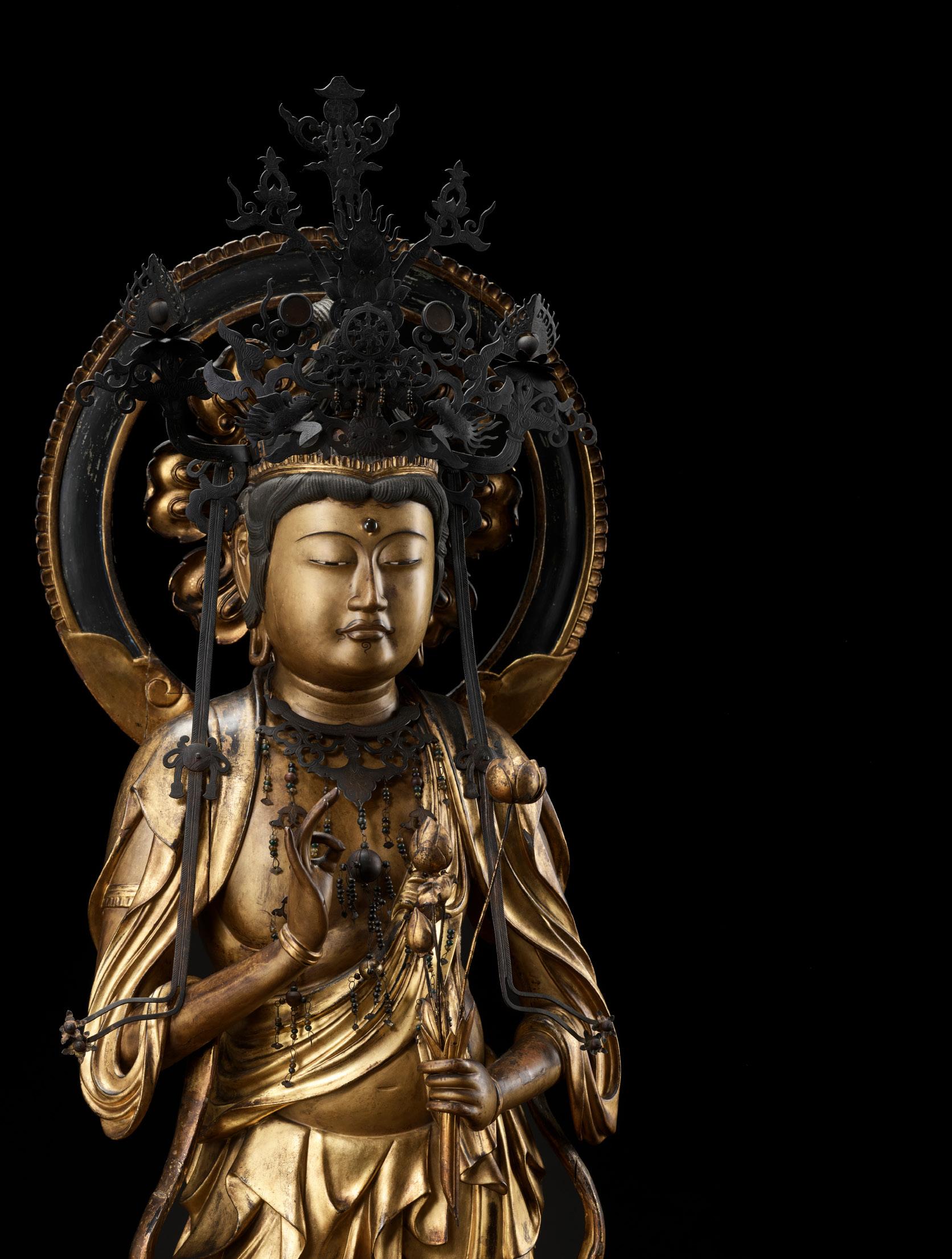
1010 VIENNA AUSTRIA STERNGASSE 13 www.zacke.at Tel +43 1 532 04 52 . Fax +20 E-mail office@zacke.at








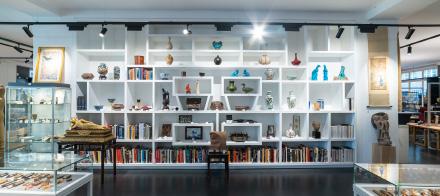



































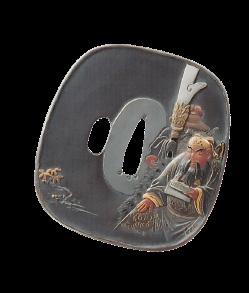
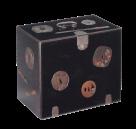


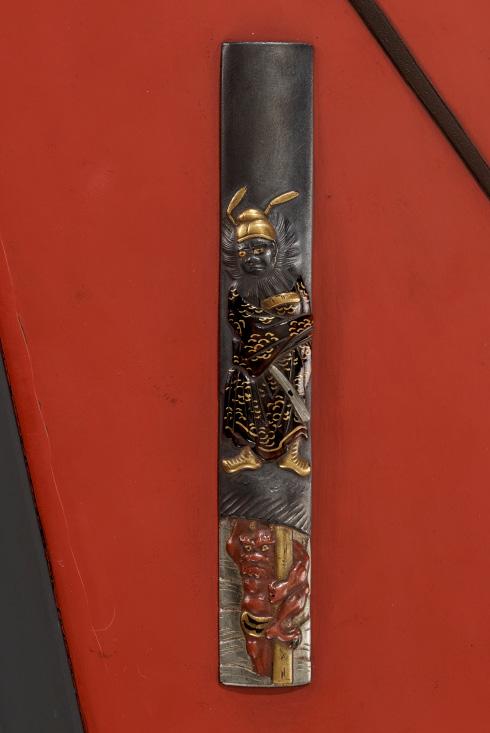











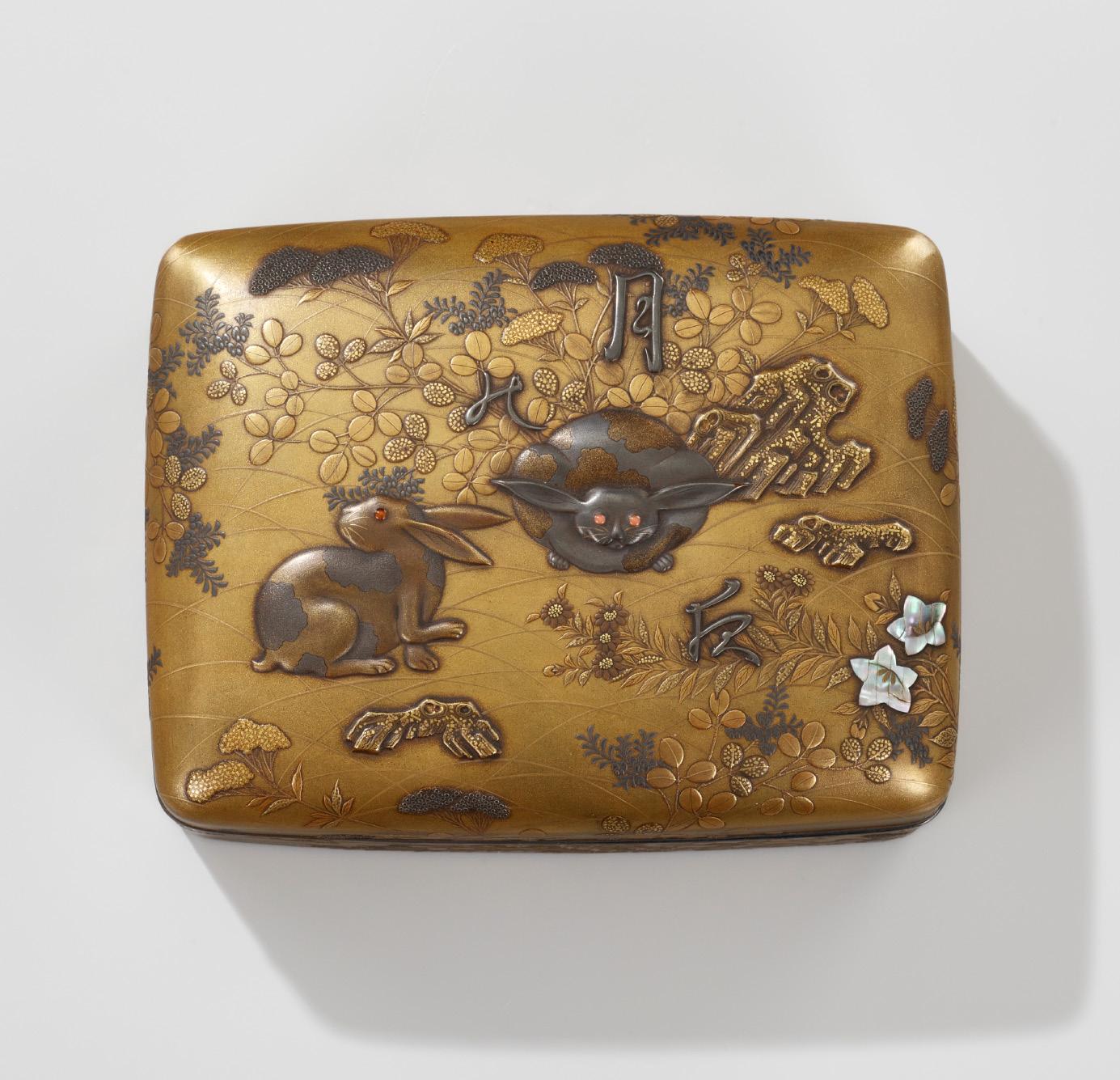







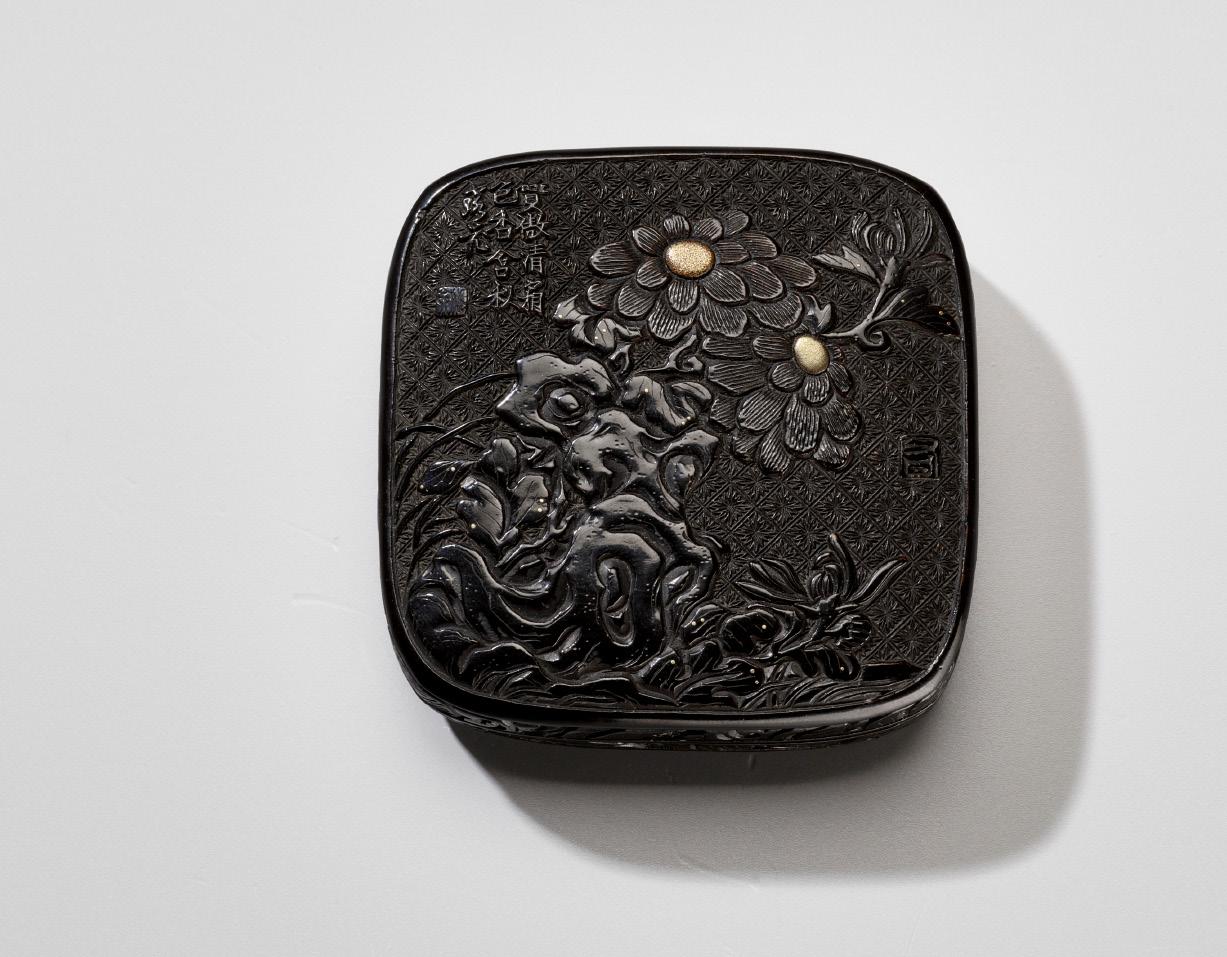

 By Ikkokusai, signed Ikkokusai Japan, Meiji period (1868-1912)
By Ikkokusai, signed Ikkokusai Japan, Meiji period (1868-1912)
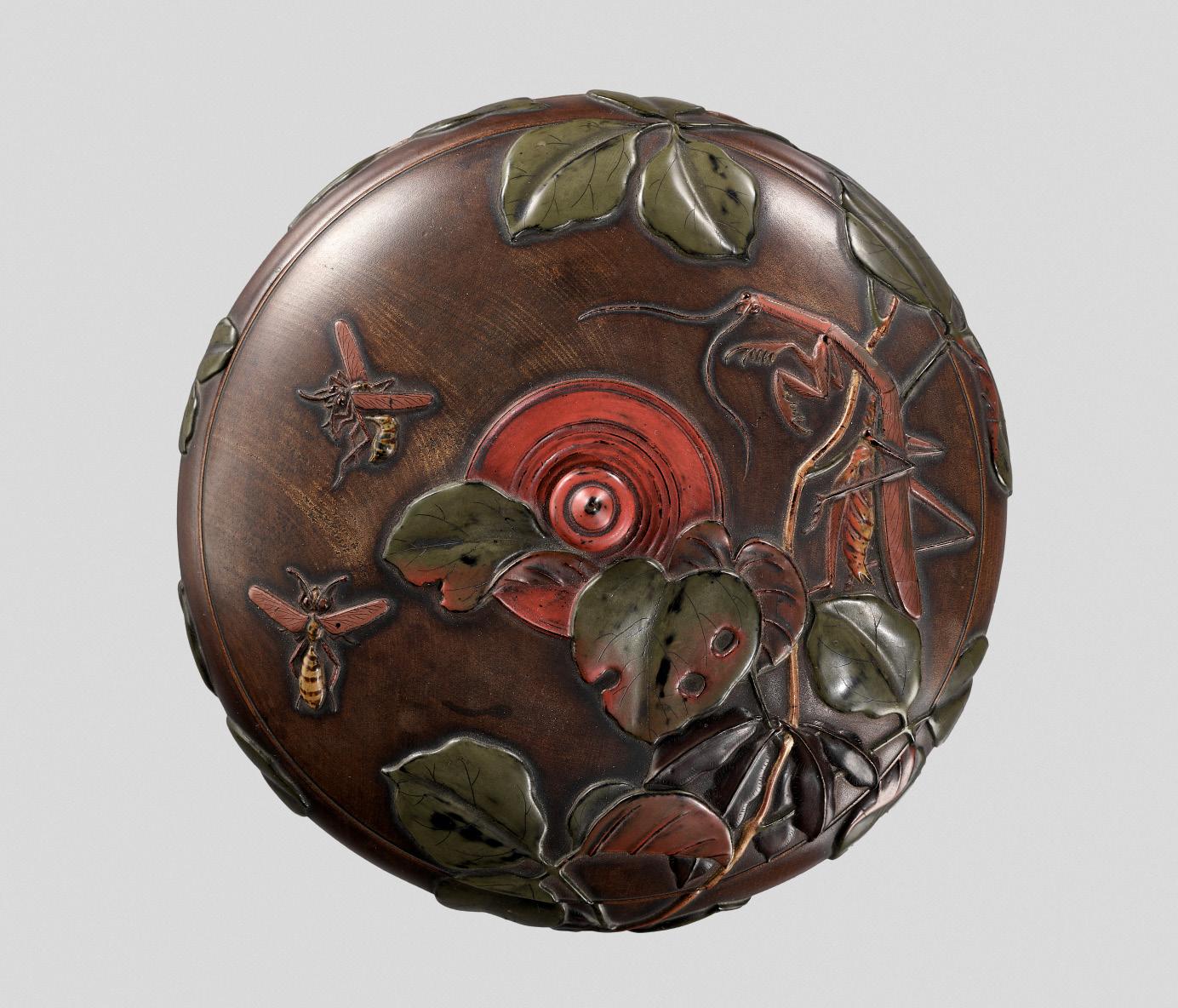














 A LACQUER SUZURIBAKO DEPICTING SHISHI AND HOTEI
A LACQUER SUZURIBAKO DEPICTING SHISHI AND HOTEI
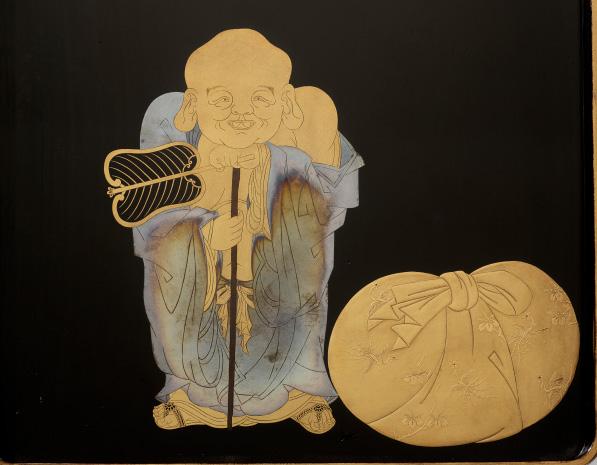

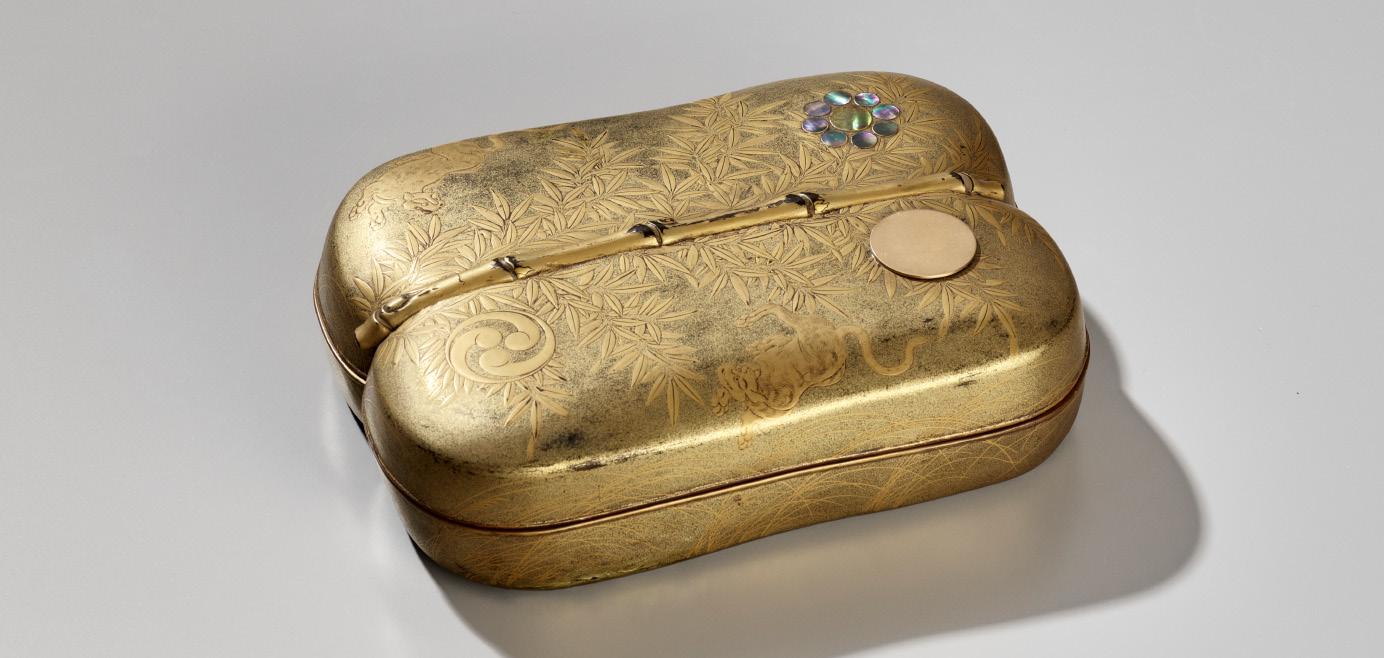






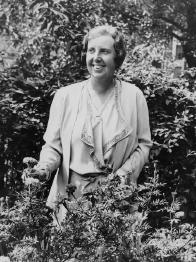


































































 BY INSCRIPTION
BY INSCRIPTION
































































































 By Hidemitsu (Shuko), signed Hidemitsu kansei Japan, Meiji period (1868-1912)
By Hidemitsu (Shuko), signed Hidemitsu kansei Japan, Meiji period (1868-1912)



















 By
By














































































































































































 By
By



















































































































































































































 By Hogetsu Noritomo, signed Hogetsu Noritomo (Jochi) 峯月乗知 Japan, Edo period (1615-1868)
By Hogetsu Noritomo, signed Hogetsu Noritomo (Jochi) 峯月乗知 Japan, Edo period (1615-1868)




































 By Shuzan, signed Shuzan 舟山 Japan, Edo (Tokyo), mid-19th century
By Shuzan, signed Shuzan 舟山 Japan, Edo (Tokyo), mid-19th century











 By Hidemasa, signed Hidemasa 秀正 Japan, Osaka, mid-19th century, Edo period (1615-1868)
By Hidemasa, signed Hidemasa 秀正 Japan, Osaka, mid-19th century, Edo period (1615-1868)



























 By
By
































































































































































